- BOAT OF THE YEAR
- Newsletters
- Sailboat Reviews
- Boating Safety
- Sailing Totem
- Charter Resources
- Destinations
- Galley Recipes
- Living Aboard
- Sails and Rigging
- Maintenance
- Best Marine Electronics & Technology


Adding Solar Power to a Sailboat
- By Emily Fagan
- Updated: October 18, 2019
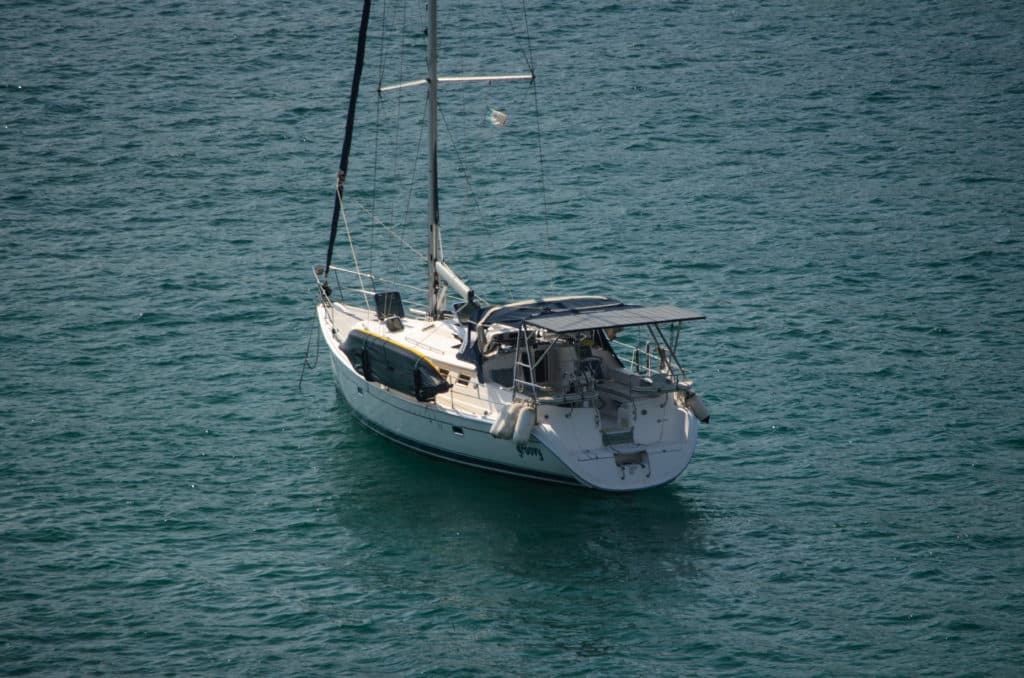
During our nearly four-year cruise of Mexico, my husband, Mark, and I lived almost exclusively on 555 watts of solar power charging a 640-amp-hour house battery bank. We anchored out virtually every night aboard our 2008 Hunter 44DS, Groovy , and relied on the sun for power. During one 10-week stretch, while we waited for a replacement engine alternator to arrive, our boat’s solar panels were our sole source of power. We had no backup charging system to turn to, and yet we lived and sailed comfortably the entire time. Mounting solar panels on a sailboat was not difficult, but a few key decisions made a huge difference in how effective our panels were.
A solar-power installation on a sailboat is made up of two independent systems: one system to charge the batteries, and another system to provide 120-volt AC power for household appliances. In the charging system, the solar panels convert sunlight into electrical current and deliver it to the batteries via a solar charge controller. Similar to a voltage regulator, the charge controller acts as a gatekeeper to protect the batteries from receiving more current than they need as they are being charged. In the AC power system, an inverter or inverter/charger converts the 12-volt DC power in the battery into 120 volts AC whenever it is turned on.
Panel Positioning and Wiring Considerations
One of the biggest challenges for sailors installing solar power on a sailboat is finding a place on the boat where the panels will be shaded as little as possible. Just a few square inches of shade on one panel can render that panel all but inoperable. Unfortunately, between the mast, radome, spreaders and boom, shadows cross the deck all day long, especially as the boat swings back and forth at anchor.
What’s worse, if the panels are wired in series rather than in parallel, this little bit of shade can shut down the entire solar-panel array. When we installed solar power on Groovy , we had already lived exclusively on solar power in an RV for over two years. Our RV solar panels had been wired in series, and we had witnessed the array shutting down current production when just half of one panel was shaded.
Choosing whether to wire the panels in series or parallel on a boat affects the wire gauge required, which is why many solar-power installers lean toward wiring the panels in series. Panels wired in series can be wired all the way to the solar charge controller with a thinner-gauge wire than those wired in parallel. This is because the voltage of panels wired in series is additive, while the current remains constant, so the current flowing is just that of a single panel. In contrast, the current flowing from panels that are wired in parallel is additive, while the voltage across them is not. This means that in a parallel installation, the current going to the charge controller is several times higher and requires much thicker cable to avoid any voltage loss over the length of the wire.
Not only is thinner-gauge wire less expensive, but it is also more supple and easier to work with, making the job of snaking it in and around various crevices in the boat and connecting it to the solar charge controller much less of a struggle. Thus the choice between series and parallel wiring boils down to a trade-off between system performance, expense and ease of solar system installation.
Luckily, the size of the wire can be reduced if higher-voltage solar panels are chosen. Since watts are determined by multiplying volts by amps, a higher-voltage panel that generates the same watts as a lower-voltage panel will produce less current. Therefore, selecting nominal 24-volt panels instead of 12-volt panels allows for the use of thinner wire sizes no matter how they are wired.
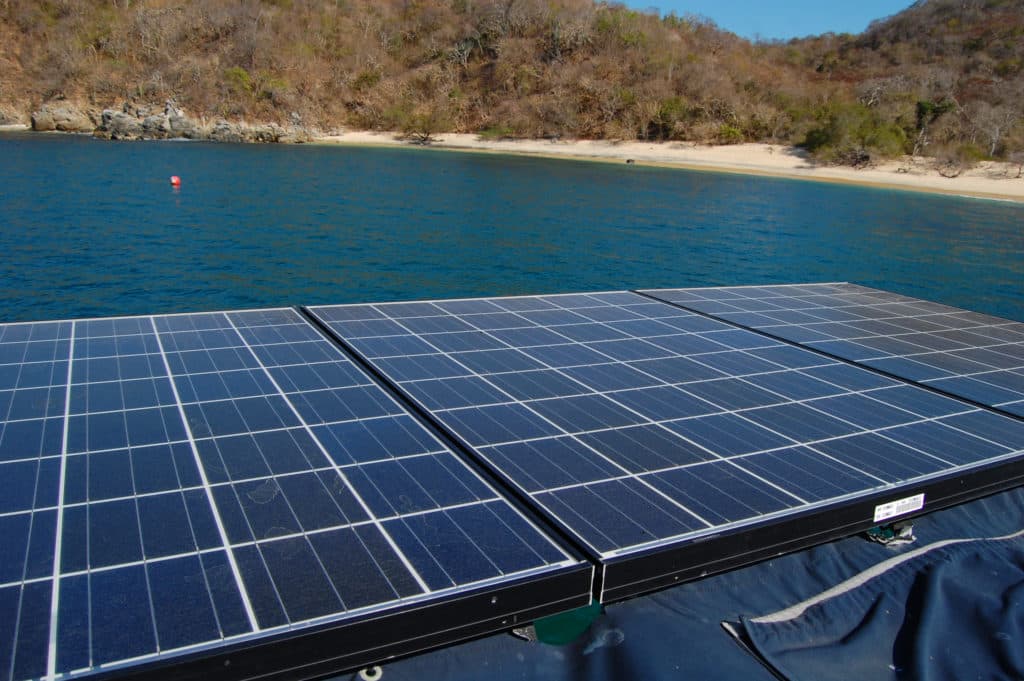
Our Marine Solar Panel Design Choices
In our installation, we decided to mount three 185-watt, 24-volt (nominal) Kyocera solar panels high above the cockpit, well aft of the boom, as far away as possible from potential shade. Our Hunter came with a big, solid stainless-steel arch, and we turned to Alejandro Ulloa, a brilliant metal fabricator at Baja Naval Boatyard in Ensenada, Mexico, to build a polished stainless-steel solar-panel arch extension onto the existing structure. He designed the arch extension with integrated telescoping davits to hoist our dinghy as well as support the solar panels. These davits were strong enough — and the lines and blocks had enough purchase — that either of us could lift our light Porta-Bote dinghy with its 6-horsepower outboard without a winch.
We spaced the panels about a half-inch apart and wired them in parallel. Using two twin-lead wires, we snaked the three positive leads and one common ground down through the inside of the arch tubes so they wouldn’t be visible, and placed wire loom over the exposed wires under the panels.
The junction points for the three parallel panels were on positive and negative bus bars inside a combiner box, all mounted in a cockpit lazarette. Inside the combiner box, we installed three breakers, one for each panel. This gave us the ability to shut off any or all of the panels if we needed to (we never did).
We mounted a Xantrex solar charge controller (model XW MPPT 60-150) in a hanging locker, as close to the batteries as possible, in a spot where it was easy to monitor and program. We ran twin-lead wire from the combiner box to the charge controller and from there to the batteries.
Our boat came with three new 12-volt Mastervolt 4D AGM house batteries, all wired in parallel, for a total of 480 amp-hours of capacity. We wanted a bigger house battery bank, and because it is best for the age, type and size of the batteries to be matched, we added a fourth new Mastervolt 4D AGM house battery, which brought our total to 640 amp-hours. Our batteries were installed at the lowest point in the hull, below the floorboards, and they ran the length of the saloon, from just forward of the companionway stairs to just aft of the V-berth stateroom door.
The best way to charge a bank of batteries that are wired in parallel is to span the entire battery bank with the leads coming from the charge controller. We did this by connecting the positive lead from the charge controller to the positive terminal of the first battery in the bank, and the negative lead from the charge controller to the negative terminal of the last battery. By spanning the entire bank, the batteries were charged equally rather than having the charging current focused on just the first battery in the bank.
We feel that AGM batteries are superior to wet cell (flooded) batteries because they can be installed in any orientation, don’t require maintenance, can’t spill (even in a capsize), and charge more quickly. Our Mastervolt batteries, like almost all AGM batteries on the market, are dual-purpose, combining the very different characteristics of both deep-cycle and start batteries. Our batteries work well, but if we were doing an installation from scratch today, we would consider the new Trojan Reliant AGM batteries. These batteries are engineered strictly for deep-cycle use and have been optimized to provide consistent current and maximize battery life.
Our boat came with a Xantrex Freedom 2,500-watt inverter/charger wired into the boat’s AC wiring system with a transfer switch. The inverter/charger performed two functions. While the boat was disconnected from shore power, it converted the batteries’ 12-volt DC power into 120-volt AC power, allowing us to operate 120-volt appliances, like our microwave. When the boat was connected to shore power, it charged the batteries.
Because this inverter/charger was a modified-sine-wave inverter, mimicking AC current with a stair-stepped square wave, we also had a 600-watt pure-sine-wave inverter to power our potentially more sensitive electronic devices. We chose Exeltech because its inverters produce an electrical signal that is clean enough to power medical equipment, and they are NASA’s choice for both the Russian and American sides of the International Space Station. For simplicity, rather than wiring the inverter into the cabin’s AC wiring, we plugged ordinary household power strips into the AC outlets on the inverter and plugged our appliances into the power strips. Like the charge controller, the inverter must be located as close to the batteries as possible. Ours was under a settee.
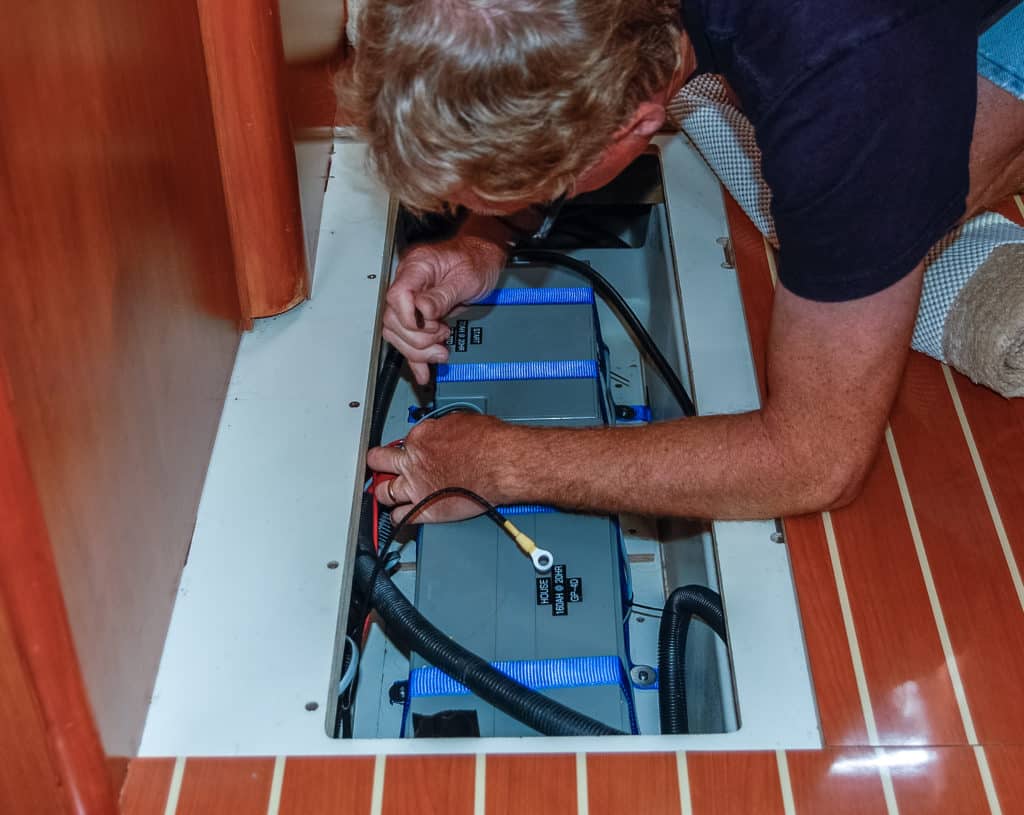
Shade’s Impact on Sailboat Solar Panels
Once our solar installation was completed on our sailboat, we closely observed the effects of shade on our solar-panel array. We were often anchored in an orientation that put the panels in full sun. Just as often, however, we were angled in such a way that shade from the mast and boom covered portions of our panels. It was fascinating to monitor the solar charge controller’s LCD display whenever the sun was forward of the beam — the current from the panels to the batteries fluctuated up and down as we swung at anchor.
Taking notes one morning, we noticed that the charging current was repeatedly creeping up and down between 9.5 and 24.5 amps as the boat moved to and fro. When the entire solar-panel array was in full sun, it generated 24.5 amps of current. When we moved so the mast shaded a portion of one panel, the array generated 15 amps. When it shaded portions of two panels and only one was in full sun, the array produced just 9.5 amps. Of course, it would have been preferable to see a steady 24.5 amps all morning, but this sure beat watching the current drop to zero whenever a shadow crossed a panel.
We discovered that shade makes a huge impact while sailing, too. Surprisingly, it is far worse to have the panels shaded by the sails than to have the panels in full sun but tilted away from its direct rays. One afternoon, we noticed that while we were on a tack that tilted the panels away from the sun, they generated 24.5 amps of current, whereas on a tack where the panels were tilted toward the sun but two of the three were partially shaded by the sails, the current dropped to a mere 10 amps.
Reflections On Our Solar Panel Installation
A wonderful and surprising side benefit of our large solar panels and arch system was that the setup created fabulous shade over the jumpseats at the stern end of the cockpit. Our metal fabricator, Alejandro, placed a support strut at hand-holding height, and sitting in those seats feels secure and comfortable while sailing, no matter the conditions.
After living on solar power for eight years of cruising and land-yacht travel, we’ve learned that you can never have too much solar power. Groovy’s 555 watts was enough to run all our household appliances as needed, including our nearly 4-cubic-foot DC refrigerator, two laptops, a TV/DVD player, and lights at night. However, it was not quite enough power to run all that plus our stand-alone 2.5-cubic-foot DC freezer during the short days and low sun angles of the winter months without supplemental charging from the engine alternator every few days. For the 10 weeks that we did not have a functioning alternator, our solution was to turn off the freezer, which enabled our batteries to reach full charge every afternoon.
Solar power made a world of difference in our cruise. Not only did it allow us to live comfortably and with ample electricity for weeks on end when our engine alternator went on the blink, but as a “set-it-and-forget-it” system, it also gave us the freedom to anchor out for as long as we wished without worrying about the batteries. In our eyes, the solar-panel arch enhanced the beauty and lines of our boat, giving her a sleek and clean appearance. It was true icing on the cake to discover that the panels and arch system also provided much-needed shade over the cockpit and helm from the hot tropical sunshine. If you are preparing for a cruise, consider turning to the sun for electricity and outfitting your sailboat with solar power.
The Installation:
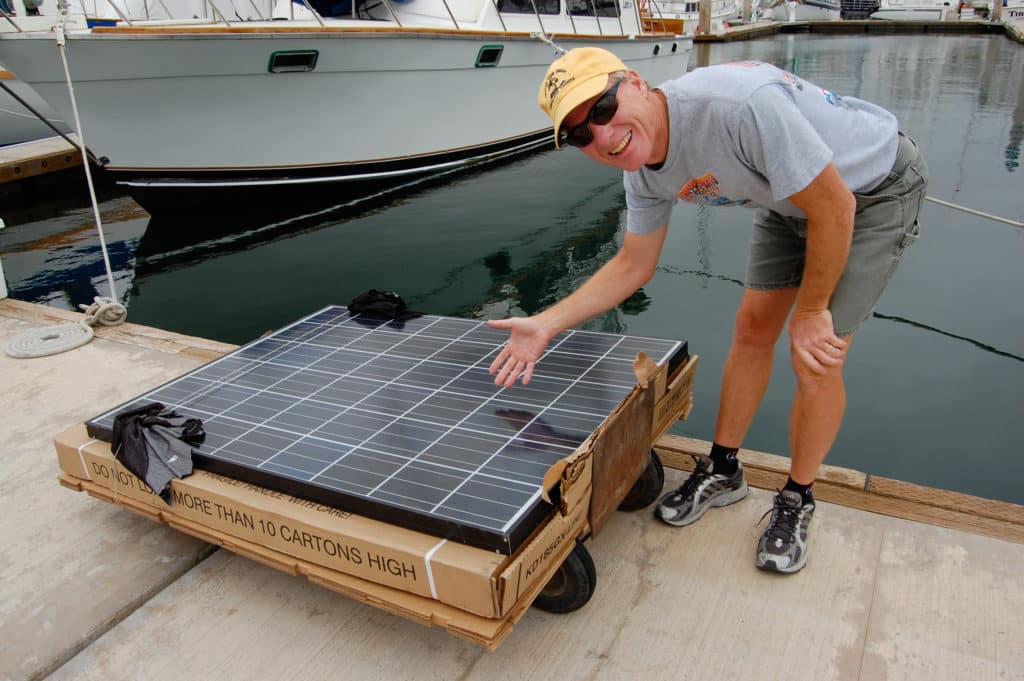
Emily and Mark Fagan offer cruising tips and share their stories and photos on their website, roadslesstraveled.us . They are currently enjoying a land cruise across America aboard an RV.
- More: DIY Sailboat Projects , green sailing , How To , installations , Refits , Sail Green , solar , solar panel , Upgrades
- More How To

3 Clutch Sails For Peak Performance

It’s Time to Rethink Your Ditch Kit

8 Ways to Prevent Seasickness

How To De-Winterize Your Diesel Engine

Kirsten Neuschäfer Receives CCA Blue Water Medal

2024 Regata del Sol al Sol Registration Closing Soon

US Sailing Honors Bob Johnstone

Bitter End Expands Watersports Program
- Digital Edition
- Customer Service
- Privacy Policy
- Email Newsletters
- Cruising World
- Sailing World
- Salt Water Sportsman
- Sport Fishing
- Wakeboarding
Save 40% off! Join our newsletter and get 40% off right away!
Sailboat Life
Sailboat Cruising and Lifestyle Magazine.

Sailboat Solar Systems and How-To

Solar on a sailboat goes together like hands and gloves, but sailboat solar systems can be installed in a variety of ways. The solar components themselves create an infinite combination of possibilities for off-grid sailing. Victron Energy chargers, Renogy Panels, Sunpower Yachts, BlueSea Systems, and many more brands have entered the marketplace, and that’s not including the lithium battery companies.
To simplify things, we’ve compiled three sailboat solar systems videos to give you an overview of what’s possible. And to help you decide on your own simple solar panel setup for sailing.
How-To Install Solar Panels on Your Sailboat
This system from Zingaro shows flexible panels summing 300w of power on a 38′ catamaran.
300W Solar System:
- Three 100w solar flexible panels
- 1 MPPT Solar charger controller
View on Amazon >>
100W HQST Flexible Solar Panels $100-$200
20amp Solar Charge Controller by Victron Energy $150-$200

Simple Sunpower Solar System
This simple solar system from The Fosters shows a quick and easy setup with limited space on top of a bimini.
Sunpower Solar Panels are considered by most in the industry as the gold standard. They use the highest-efficiency solar cells and have top-notch build quality. In this simple installation, three 50w panels are just enough to get you started. Plus, it’s the most affordable installation!
150w Starter Solar System
- Three 50w Flexible Solar Panels
- A Single 15amp solar charge controller
50W Sunpower Solar Panels $150-$200
75v/15amp Solar Charge Controller by Victron Energy $100-$124

Off-Grid on a DIY Solar Powered Sailboat
Here’s a special installation that turned a derelict sailboat into an off-grid sailing machine!
Simon has transformed this derelict sailboat into an epic off-grid solar-powered and fossil-fuel-free cruising catamaran. He’s been living aboard and renovating the boat for the past 3.5 years We’re excited to show you the transformation as well as how he plans to propel the boat without the use of diesel or fossil fuels!
5280w Solar System for Electric Powered Catamaran
- 16 Rigid solar panels (330w each)
- 20kwh of Lithium Batteries
240W Rigid Solar Panels $250-$300
200AH Lithium 4d Battery $1200-$1200

Share this post!
Throw in your two cents, start a discussion cancel reply, related articles.

The Voyage of the Sea Star – 35ft Sloop to Bermuda

Living Aboard a 30-36ft Sailboat: A Guide for the Curious and Adventurous

Summer Sailboat Video, Bikinis, Sails, and Fun

Saved Up For This Dream

Top 3 Best Solar Panels For Sailboats

Last Updated by
Daniel Wade
June 15, 2022
Choosing whether or not to install solar panels on your sailboat is a big decision. They are not exactly cheap, though they can start to pay themselves off pretty quickly.
This article is going to cover not only why you might want to use solar panels but all the benefits they provide. You will also find a helpful guide on which solar panels would be best for you and your budget. Hopefully, by the end, you will feel confident in your decision to install solar panels on your sailboat and even have an idea of which ones you might like.
Table of contents
Are solar panels on sailboats necessary?
Whether or not you should be installing solar panels on your boat is a matter of choice, not out of necessity. Sailboats get their power from the wind, by harnassing it in their sail. So if you plan to be sailing for the afternoon you probably don’t need solar panels.
You could charge a battery pack from the marina and that will probably see you through several trips. The problems only really start to arise if you are planning to be on your sailboat for longer periods, or even permanently. If you plan to live on your sailboat year-round, even if you spend 80% of it in a marina, you would be better off with some solar panels. Even if it is just as a backup source of power.
Are solar panels on boats safe?
Solar panels are generally pretty safe. They have no moving parts and typically have a very strong protective cover over them so you never come in contact with the electrics themself. So, as a source of power, they are generally pretty safe. The only time they may become unsafe is if they are badly damaged.
Solar panels are often covered by glass plating that keeps them safe. It also helps them absorb sunlight and warmth. This is great, except when the glass breaks. If the glass protective cover on your solar panels should crack and splinter you are at risk of serious injury from sharp shards of glass. Not only is the glass itself dangerous at this point, so are the electronic components inside. They have powerful currents running through them, and if you come in contact with them you may be in for a shock.
Furthermore, if these electronics get wet they can become deadly. Electricity and water do not mix well at all. Being as you are on a sailboat, at sea, the chances of them getting wet is very high. Luckily, the chances of them breaking in the first place are slim to none. The only real way they would break, besides vandalism, is by debris hitting them during a bad storm. There is not often debris at sea, so this shouldn’t be too much of a problem.
What are the benefits of having solar panels on a sailboat?
There are so many great benefits of having solar panels on a sailboat. They can be a lifesaver if you find yourself at sea for a long time. There benefits range from trivial comforts to being the difference between life and death. Here are some of the benefits you might not have considered about having solar panels installed on your sailboat.
Money-saving
Solar panels are not cheap, it is far cheaper to just run a generator or charge your batteries from the marina the whole time. At least, it is in the short term. Over time, it can start to become very expensive. With solar panels, you are looking at a big initial cost (the solar panels themself) and then it’s smooth sailing. You don’t need to pay for power again. Solar panels last for about 40 years before they start to become too inefficient at producing power. The cost of a few solar panels upfront compared to 40 years of marina fees and gasoline for a generator is the financially savvy move.
Emergency power
If you find yourself at sea, the wind dies down (or becomes too strong), and you find yourself stuck bobbing around waiting for more favorable conditions you may run into trouble. Depending on how long you are out there, you may find yourself with dead electronics. Be it a satellite phone, radio, or secondary engine (depending on the boat). Having a set of solar panels and a power bank can be a genuine lifesaver in these situations.
Comfort amenities
Whether you are day sailing or making a week-long voyage, having access to the comforts in life can make the whole journey so much more enjoyable. The amenities may not be available to you without having a constant source of power at sea. Having access to a kettle, tv, videogame system, radio or microwave oven may be the only thing keeping you going at rougher times. As exciting as sailing can be, when you aren’t sailing and are just bobbing around it can be quite dull. The sea is beautiful, but there is only so much time you can spend looking at the water before you miss the comforts of land. With solar panels, you can bring those comforts with you.
Eco-friendly
There are only two alternatives to solar panels. A gasoline generator, and taking power from the grid. Neither of these is good for the environment. Luckily, solar panels are a great third option. Solar panels are completely eco-friendly and are great for the environment. This is not just great for the earth, and your conscience, but for the journey itself. If you are running a gasoline generator at sea you are going to be listening to it thrumming away and smell the burning gasoline. Wouldnt you prefer silence and nothing but the smell of the sea breeze?
How much do solar panels cost?
How much solar panels cost is almost entirely tied into both their voltage/wattage and whether or not they are portable panels. Portable solar panels are great for people who don’t spend a lot of time on their boat or are happy enough living off the marina’s power grid. Permanent solar panels, the kind that may need to professionally installed, can end up costing far more. They are also likely to be far superior and you can pretty much forget about them once they are installed.
Portable solar panels will cost just a few hundred dollars each. You will need a few to be sustainable, but that’s not going to be much of a problem. These portable solar panels can just be rolled out on the deck of your boat, weighed down, and then hooked up to a battery pack. The battery itself here is going to be the most expensive part of the whole set up. A decent-sized battery could set you back a $1000. But, when charged fully it will last days. Even with constant use.
Permanently installed solar panels can cost one or two thousand dollars in some cases. The advantage here though is once they are installed that’s it, you can forget about them. You don’t have to put them up, take them down, and find somewhere to stow them every time they need using. They too will need to be hooked up to a battery, the battery is still only going to cost you $1000. If you are installing permanent solar panels because you plan to be making long voyages, it is ideal to have two or perhaps even three large batteries hooked up to your boat. One to run off, one or two for emergencies.
How do I maintain my solar panels?
Solar panels, unlike gasoline generators, are generally pretty easy to maintain. They have no moving parts and are thus pretty self-sufficient. They don’t need taking apart and they last as long as 40 years. That being said, if they do break they need repairing as soon as possible. The exposed electrics can be deadly when water is thrown into the mix. Which, on a boat, is almost always. The glass cover will need replacing and the electronics inside may need repairing, though not always. Don’t ever attempt to do this yourself unless you are experienced at making these repairs. The cost of hiring someone to do it for you is preferable to being dead. Solar panels have very powerful electric currents, that when in contact with water and yourself can be fatal. As mentioned above, these panels rarely break so you will likely not ever run into this problem. If you do, hire a contractor.
Do my solar panels need cleaning?
Solar panels work by converting the light and heat of the sun into useable power. The process itself is rather complicated but the results are simple to understand. That being said, there are some reasons that your solar panels will stop working as effectively. They all revolve around a lack of sunlight. It could be because it is night time. It could be because it is very cloudy. Or, it could be because they are dirty. If solar panels become too dusty, dirty, and become too covered in grime they stop operating at maximum efficiency. This is not as much of a problem at sea, the sea spray stops dust settling. The biggest thing you will need to clean off your solar panels is salt build-up and slime. This is easy enough to do with some warm soapy water. Freshwater, not seawater. You want to be removing as much salt as possible. Salt is corrosive to electronics, so removing it is important. Never clean your solar panels using pressure washers as they can crack the glass.
Which are the best solar panels for sailing?
There are so many options on the market at various price points. Here are three very different options that will all make good choices, depending on your needs. It is important to consider not just price but power output. Spending a lot of money on solar panels now might not feel ideal, but it is the most cost-effective decision.
1. Renogy Starter Kit
This starter kit is going to be perfect for installing on almost any sized boat. There are four solar panels, each can be fitted permanently to the boat. They can be mounted (and unmounted) easily, for your convenience. They do require a flat surface, but they are small enough that that likely won’t be too much of a problem. This starter kit is very middle of the pack price-wise but should provide enough power for a small to medium-sized vessel easily. It is also possible to buy extra panels individually should you need them.
Wattage: 400/4 (100 per panel)
2. Nature Power Rigid
The nature power rigid is a large, powerful, single solar panel. If you are looking for the right panels to power your entire boat comfortably, these are the ones for you. They are very large so they will need a large flat surface area. alternatively, they can be hung vertically from rails. This is an inefficient way of using them, so you would need to buy more this way. Nature power makes various solar panels so you could find some smaller ones of the same brand to supplement it. This one is not so easy to install, you might need to hire someone to install it for you.
Wattage: 165
3. Nature Power Monocrystalline
Nature power makes a portable solar panel that fits inside a special briefcase. It is perfect for stowing away easily and only taking it out when it is needed. It is decently powerful considering its portable, but there is the inconvenience factor of having to set it up each time. If you planned to buy the nature power rigid, buying one of these portable panels might be ideal for supplementing your power supply when it is especially sunny. Though, it may be cheaper for you to just fit more of the Nature Power Rigids.
Wattage: 120
Hopefully, you now have a good idea about whether solar panels would be right for you and your sailboat. Sailing is great, but the lack of power at sea can be dreadfully boring. Luckily, there are so many great options available on the market. Not just the ones mentioned above. Buying a solar panel is an investment, the initial cost is minor compared to the steady return from all the savings you will make.
Related Articles
I've personally had thousands of questions about sailing and sailboats over the years. As I learn and experience sailing, and the community, I share the answers that work and make sense to me, here on Life of Sailing.
by this author
Sailboat Upgrades
Most Recent

What Does "Sailing By The Lee" Mean?
October 3, 2023

The Best Sailing Schools And Programs: Reviews & Ratings
September 26, 2023
Important Legal Info
Lifeofsailing.com is a participant in the Amazon Services LLC Associates Program, an affiliate advertising program designed to provide a means for sites to earn advertising fees by advertising and linking to Amazon. This site also participates in other affiliate programs and is compensated for referring traffic and business to these companies.
Similar Posts

How To Choose The Right Sailing Instructor
August 16, 2023

Cost To Sail Around The World
May 16, 2023

Small Sailboat Sizes: A Complete Guide
October 30, 2022
Popular Posts

Best Liveaboard Catamaran Sailboats
December 28, 2023

Can a Novice Sail Around the World?
Elizabeth O'Malley

4 Best Electric Outboard Motors

How Long Did It Take The Vikings To Sail To England?

10 Best Sailboat Brands (And Why)
December 20, 2023

7 Best Places To Liveaboard A Sailboat
Get the best sailing content.
Top Rated Posts
Lifeofsailing.com is a participant in the Amazon Services LLC Associates Program, an affiliate advertising program designed to provide a means for sites to earn advertising fees by advertising and linking to Amazon. This site also participates in other affiliate programs and is compensated for referring traffic and business to these companies. (866) 342-SAIL
© 2024 Life of Sailing Email: [email protected] Address: 11816 Inwood Rd #3024 Dallas, TX 75244 Disclaimer Privacy Policy
Yachting Monthly
- Digital edition

Sailing with solar power: A practical guide
- Duncan Kent
- November 13, 2020
The latest solar technology makes self-sufficient cruising much more achievable. Duncan Kent gives the lowdown on everything you need to get your boat sorted

SOLAR POWER ON BOARD
Solar power is fast becoming the most popular and economic method of keeping the batteries charged on a boat.
Particularly now that the efficiency of photovoltaic (PV) panels, charge controllers and batteries is improving every day.
Furthermore, the latest technology in regulators and charge controllers has brought about a noticeable increase in useable power output, so the problems of shading and non-alignment can be compensated for more easily.
Not only has PV equipment become more efficient and cost-effective, but many of the modern devices we want to use on a boat have become less power hungry.
This means it is now far easier to provide your entire yacht’s electrical needs, both 220Vac and 12/24Vdc, from natural energy resources – particularly solar power, even if you are planning on a fully electric boat .

Thinking carefully about how much power you need and how much your boat can accommodate is key to planning a solar array. Credit: Graham Snook
WHAT DO YOU NEED?
For instance, a boat with two new, good quality, deep-cycle house batteries of 100Ah each would supply 100Ah of energy to consume between charges, if you only use the recommended 50% of available charge between each charge cycle to protect the batteries.
From this you could run:
- a modern 12Vdc fridge (approx. 1.5Ah, or 36Ah over 24hrs),
- all LED lighting (say 20Ah per day),
- various small device chargers (20Ah)
- and a number of other items such as water pumps, TVs and stereos (25Ah/day)
- Totalling around 100Ah.
- For this you’d need 400W of solar capacity.
Of course, if you like to run a lot of AC devices off-grid such as hair dryers, microwaves, toasters and the like, then you’re going to need a DC/ AC inverter, which will take you to another level in power consumption terms.
But even then, with careful planning, solar could provide a large portion of the power you need before resorting to engine charging or a generator.
THE AVAILABLE SPACE
In practical terms, a modern 40ft monohull would have the space for around 1,200W of PV panels (cockpit arch, sprayhood top, deck), maybe 1,500W with the addition of a few portable panels for use at anchor.
The 1,200W of fixed position solar array could produce around 360Ah on a sunny summer’s day (zero shading) or more likely 250Ah on the average UK summer’s day.
So that’s enough for your 100Ah general DC consumption plus another 150Ah of AC consumption via the inverter.
Of course, to do this you’ll most likely need to increase your battery capacity to around 400-500Ah for maximum flexibility (you’ll need to store as much as possible during daylight hours), a typical figure for a 40-50ft offshore cruising yacht these days.

Get your solar charging right and you may never need to hook up to shore power
Typical daily inverter loads for a cruising yacht off grid might be:
- induction cooking plate (20min) 60Ah
- microwave (15min) 30Ah
- coffee maker (20mins) 25Ah
- hair dryer (5min) 15Ah
- laptop charger (2h) 10Ah
- or around 140Ah in total.
The trick is to monitor the batteries’ state of charge (SOC) at all times and vary your use of the inverter to suit.
For example, you might want to cook supper mid-afternoon, when solar is in abundance, and then reheat it in the evening when you want to eat it.
In some cases, when you’re cruising in warm climates such as the Med, you might end up with excess charge from your solar panels .
In this situation, many long-term cruisers devise a method of ‘dumping’ the extra energy by heating water for showers.
Do bear in mind if you’re planning to live aboard full time , then it’ll be a whole different story on cloudy days and during the winter, when inverter use might need to be knocked on the head entirely.
Continues below…

Eco friendly sailing: Best practice for green yachting
How easy is it to go eco friendly sailing? We look at the steps cruisers can take to minimise their…

How and where to go wild cruising in the UK
Planning to spend the night away from crowded waters can be truly rewarding but preparation is essential before you go…

Solar-powered boat crosses Atlantic
Then heads to UN climate conference
POWER DISCREPANCIES
There’s often confusion as to how much power you can harvest from a solar installation.
A PV panel is nearly always advertised stating its theoretical peak output power (Pw).
But in reality, on a yacht where there are limited areas in which to mount them, they will more likely produce a maximum of 60% of their peak output if mounted horizontally, increasing to 80% if tilted towards the sun and regularly adjusted.
The latter is rarely achievable on a boat, however, as even at anchor it can swing through an arc of 180° in wind or tidal shifts .

Flexible panels can be mounted on sprayhoods or awnings to add power when it’s needed at anchor or in harbour
INSTALLATION
Having trawled through hundreds of ‘deals’ to get the best price on the most efficient panels you can afford you now need to know how to install them to best fulfill your energy generation needs.
The output, even from the highest quality photo-voltaic array, will only be as good as the installation itself.
So following our guidelines should ensure you extract every last drop of energy from your investment.
PANEL MOUNTING
Sailing boats are not the ideal structure on which to mount wide, flat PV panels.
So before you go ahead and purchase what looks like the biggest and best, take a few minutes to decide on exactly where you can mount them, as this will affect what size and type of panels you should buy.
In many cases the first choice would be on an arch, davits or gantry aft, especially if you already have, or plan to fit one.

Dinghy davits, particularly on multihulls, can support a huge solar capacity
These allow a solid metal framework to be constructed that will be strong enough to take the heavier, more productive rigid PV panels.
You can also build in some form of adjuster to the framework that will allow the panels to be orientated towards the sun for the best performance.
With luck (or careful planning) a gantry will also keep them aft of the boom, thereby eliminating loss of output caused by boom shading.
The next most popular position for mounting the panels is on a cockpit sprayhood or bimini, although this will often mean using the flexible or semi-flexible panels, which are generally less efficient than the rigid ones for the same area.
ELEVATED MOUNTING
Alternatively, there are kits available for mounting panels onto lifelines, which can allow their elevation to be manually adjusted to a certain degree.

Pole-mounted panels can be used for maximum adjustability
Finally, panels can be fitted directly onto the deck by either gluing them down using mastic or attaching them onto a rigid support frame.
Once again you will probably need to use semi-flexible panels – especially if the deck surface is curved.
Rigid, glass-coated panels will obviously not be suitable for deck mounting in an area that is frequently walked over.
Don’t be tempted to drill through the panels, even along the edges, as this will invalidate the warranty and possibly damage the panel.

With solid panels, the ability to adjust the angle can add significantly to output
It might seem obvious, but the key to an efficient system is to avoid shading wherever possible.
It’s no good fitting expensive, high-efficiency PVs right under the boom as they’ll perform little better than the cheaper types.
Saying that, in good quality panels each cell will be isolated from the next by a series of diodes (one-way electrical valves), so that if one cell is shaded at least it won’t drag down the other cells within the same panel.
Older panels often didn’t have these, so the slightest partial shading caused the output of the entire panel to cease.
OVERHEATING
Another important factor that is often ignored when installing the panels is that of overheating.
If a PV panel gets too hot, which is quite likely if mounted directly onto a flat surface without an air gap behind, its output will drop quite noticeably.
To allow for some air circulation behind the panels it’s best to apply mastic adhesive in numerous large dabs.
This is best achieved by placing wooden spacer strips between the dabs until the mastic has completely cured, after which the spacers can be removed.
You might need some form of trim around one or more of the outside edges, though, if they are positioned where sheets and other lines might get caught under them.
Raising the panels up will also help water to drain off and thereby helping to avoid possible delamination from sitting in water for too long.
CHARGE CONTROL
A PV module cannot supply an electrical device directly due to the changeability of the sunlight, which in turns varies the current it can produce.
Therefore, it has to be connected to a battery, which stores and smooths its output.
Whatever the size of your solar array you will need to fit a regulator, or charge controller as they are now more commonly known, to the system in order to control the output and to help extract as much power from the panels as possible.
There are two types of PV charge controller.
The older designs, called Pulse Width Modulation (PWM) types, were fairly basic voltage regulators and simply output volts at just above battery level.
The latest controllers use Multi Power Point Tracking (MPPT) technology and can accept much higher input voltages (up to 240Vdc).
MPPT controllers can be up to 30% more efficient as they use the peak output of the panels to charge the batteries, even compensating for partial shading.
BEWARE FAKE GEAR
If you buy online do be careful to ensure you’re getting what you pay for.
There are a huge number of fake MPPTs out there, which are simply the much cheaper PWM dressed up with fake labels.
It’s hard to tell which is which, but the old adage of ‘if it looks too good to be true, it usually is’ makes good sense.
MPPT controllers are usually bigger and heavier than PWMs, but if in doubt call or email the supplier to discuss the pros and cons of their kit before buying.
If they’re not happy to chat and advise you then I would steer clear of their gear.
Some good MPPTs are made in China, but unless they have a UK supplier, I wouldn’t bother with them as you’ll have no follow-up advice.
To calculate what size controller you need simply divide the panel’s peak power in Watts (Wp) by the battery voltage, which will give you the maximum current (Amps) they could theoretically supply.
For example 240W/12V = 20A. Although it’s unlikely you’ll ever get near the peak output from any PV panel, it’s best to go for the maximum possible.

Induction cooking is now a reality on board, even without shore power
PV panels come with a short length of cable, usually around 1m long.
Some are supplied with MC4 connectors already attached but most only provide bare wires.
The latter can be easily extended using proper waterproof connections but thought must be given as to the current rating and voltage drop (usually max 3%) for the size of cable you intend to use.
If in doubt, bigger is better!
Panels can sometimes be ordered with the wiring on the back so that the cable can go straight below deck through a hole under the panel.

You may need to fit extra battery capacity if you want to run an inverter from solar charging
SERIES OR PARALLEL?
A commonly asked question is ‘should I wire my PV panels in series or in parallel?’
The simple answer is, if there’s any danger of frequent shading to one or more of the panels then install them in parallel.
If wired in series the shading of a single panel will drag down the output from all of the others in the same series.
PARALLEL IS PREFERRED
Most commonly, multiple panels are wired together in parallel to a single charge controller, with diodes protecting each panel from discharging the others should one become partially shaded.
With the advent of MPPT controllers, however, there can sometimes be a benefit to wiring two or more identical panels into a series bank, thereby presenting a higher voltage to the controller.
It’s worth noting that, like batteries, wiring PV panels in series increases the voltage only – the current capacity of the array remains the same as for a single panel.
‘Where’s the benefit of wiring them in series then?’ you might ask.
Well, the higher the voltage fed into the MPPT, the more consistent it will be with its output, which could, in some cases, prove more efficient than a parallel installation with PWM controllers.
It’s also likely to be necessary if you have a 24V domestic system.
SERIES WIRING
Series wiring is usually only done when the cable runs are long, as it helps negate the voltage drop caused by the resistance of the cable.
While a decent controller will have no problem handling the output from four or even five panels wired in series, it is often inappropriate for sailing yachts as shading just one of the panels will reduce the output of the entire series array.
If you need to do so in order to reduce cable runs then it’s best to split the panels between each side of the boat – a series bank on each side.
If you do this, then you would ideally fit a separate controller to each series PV bank and then connect their outputs together in parallel to the battery bank.
Note, however, that panels wired in series must all be the same types with an equal number of cells per panel.
Furthermore, the charge controller needs to be sized for the total of all panel voltages added together and the current rating of one individual panel.
Differently rated panels can be connected together in parallel but only if each panel has its own controller.
The outputs of the individual controllers can then be joined together to go to the battery bank.
BATTERY BANK QUESTION
Another frequently asked question is ‘Can I connect another charging source to the battery bank while the solar array is charging?’
The answer is yes.
Any decent PV controller will be protected against feedback from other charging sources.

Think carefully about where shade from mast, boom and rigging will fall. Credit: Graham Snook Photography
CABLE SIZE AND CONNECTORS
A frequent cause of reduced output from PV arrays is wiring that is too small.
The resistance of a wire conductor increases in direct proportion to its cross-sectional area, so go as big as is practicable for the least cable loss.
Each panel should be supplied with the correctly sized cables for its own maximum output.
But if you’re combining panels, either in parallel or in series, you will clearly need to rate the single feed cable to suit the maximum current available at theoretical peak solar output and to minimise voltage drop.
Likewise, the cable from the controller to the batteries should be sized to suit the controller’s maximum output current and protected with a fuse.
For outside it’s important to use exterior grade cable, which is double- insulated and UV-proof.
WEATHERPROOF CONNECTORS
And wherever possible use compatible weatherproof connectors (usually MC4) to those found on the panels rather than cutting off the plugs and hard-wiring them.
Field- assembly MC4 plugs are available, so you don’t have to drill large holes in the decks or bulkheads when feeding the cables through.
When joining more than one panel together try to use the approved multiway connectors; not only do they keep the wiring neat and tidy, but they also offer a greater contact area than budget terminal blocks.
If you have to use screw-type connectors make sure to fit proper ferrules to the wire first to avoid any stray wires in the multistrand shorting across the terminals.
When feeding a cable from above to below deck, try to go through an upright bulkhead where possible to minimise ‘pooling’ of water around the access hole.
Also, use a proper watertight deck seal that matches the cable you’re using.
If drilling through a cored deck you need to drill a larger hole first, fill it with epoxy resin and then drill the required size hole through the epoxy to ensure no water gets into the deck core.
Ideally, the charge controller should be mounted no further than 2m from the battery bank.
If you need to go further, you’ll require larger cabling to reduce the voltage drop.

A generous solar array will keep you self- sufficient indefinitely. Credit: Graham Snook Photography
CONTROLLER LOAD TERMINALS
There is often confusion over the ‘load’ output of a charge controller (often depicted by a light bulb) and what can safely be connected to these terminals.
Rarely explained in the manual, the load terminals should be pretty much ignored in a marine installation as the output on these terminals is usually very limited (10A max).
Some attach an LED light to them to indicate the controller is operating, but all your usual electrical loads should remain connected to the batteries with the battery terminals on the controller connected directly to that battery bank via a fuse.
It is possible, though, to control a high-current switching relay in certain conditions.

Parallel installation is more resilient to shading, but a series installation will increase peak charging outputs. A combination of the two offers some of the benefit of both
CIRCUIT MONITORING
Unlike most cheap PWMs, the majority of good quality MPPT charge controllers come with an alphanumeric LCD screen to let you know what is going on.
This can either be a remote display or simply one on the front of the box.
It’s obviously a lot better to have a proper numerical display than to rely on a few flashing LEDs to tell you when something’s not right.
So if your chosen controller doesn’t have one be sure to fit a battery monitor (the shunt type) into your solar circuit between the controller and the batteries.
It doesn’t have to be a very ‘smart’ monitor, just one that can display the voltage and current being supplied by the panels.
For smartphone addicts there are several wifi apps that will do the job remotely on your phone or tablet.
DEVICE PROTECTION
All good quality PV panels feature built-in diode protection between each cell to prevent a shaded cell from dragging down the productive ones.
In addition, there will be internal blocking diodes on the final output to protect the panel from polarity reversal and to ensure that the batteries can’t discharge back into the panel during the night.
The latter can be added externally, the former can’t, so check before you buy.
A fuse, rated just above the maximum current available, should be fitted between each panel and the charge controller.
Another fuse should then be installed between the charge controller’s output and the batteries.
In the case of multiple arrays, this second fuse will be rated higher than the individual panel fuses and should match the maximum current rating of the cable.
With this protection installed other charging devices can be connected in parallel at the battery, meaning the solar can be left connected even when you are hooked up to shore power and the battery charger is operating.
In some circumstances, however, this arrangement can affect the sensing of the battery by the charger, causing it to fall back into float mode.
If this becomes apparent it can be overcome by installing a manual/auto switch to disconnect the solar array when on shore power.

Check the flex of the solar panel is sufficient for your deck
EXCESS POWER DUMPING
A solar charge controller works by disconnecting the supply from the PV panels when the batteries are fully charged.
But for some full-time liveaboards in sunny climates that can be considered a waste, when the excess power could be put to good use – heating water, say.
This is commonly done using an inverter to supply AC power to the heating element.
Alternatively, you can now buy a 12Vdc element for your calorifier (hot water tank) and supply this directly from your battery bank.
Both of these methods would require a voltage sensitive relay (VSR) to disconnect the element should the battery voltage drop below a pre-set level.
Don’t expect boiling hot water, as there will probably only be enough spare power to take the chill off it before your battery bank reaches its lower threshold voltage.
A 600W/12V element will draw some 50A, from the batteries, whereas a 1kW AC element run through an inverter will need close to 100A.

A small, semi-flexible panel will be sufficient for keeping batteries trickle charged, but not for heavy use
RIGID, FLEXIBLE, OR SEMI FLEXIBLE?
Despite massive recent improvements in semi-flexible panels in recent years, the solid glass panels still offer a higher power density.
That said, they are heavier, more awkward to mount and can’t be walked on, so unless you have a dedicated gantry aft, you’re better off choosing the more rugged semi-flexibles.
Modules incorporating monocrystalline cells also have a better output than those with polycrystalline cells (that’s cells made from a single slice of silicon as opposed to layers of smaller pieces).
Output voltage also depends on the number of cells on the panel.
In the past this has commonly been 32, but now some 36 and even 40 cell panels are available.
That said, they’re larger, of course, so an array of interconnected smaller panels might be a better solution.
Module efficiency is now more often around the 20% mark, as opposed to 12-15% for older models and semi- flexible (up to 20° bend) are usually better than flexible (up to 180° bend).

A rigid panel is more efficient, but less robust
There are a huge number of panels on the market, but many use the same cells.
Sunpower Maxeon cells are exceptionally good, as are the Panasonic HIT range and LG, but they are pricey.
If the maker is offering a 25-year guarantee instead of a 3-5 year one, you can be pretty confident they’re good.
When it comes to charge controllers it’s definitely worth paying a little more for a decent MPPT.
A cheap PWM might be okay just to keep a small starter battery charged with a 30W panel, but the MPPT will give you much more when it comes to heavy service.
Victron are probably top of the range, while cheaper brands like MakeSkyBlue and EPever are also good value – but treat imports of unclear origin with care.
ABOUT THE AUTHOR

Duncan Kent has been evaluating and reviewing yachts and marine equipment for the past 30 years
Enjoyed reading this?
A subscription to Yachting Monthly magazine costs around 40% less than the cover price .
Print and digital editions are available through Magazines Direct – where you can also find the latest deals .
YM is packed with information to help you get the most from your time on the water.
- Take your seamanship to the next level with tips, advice and skills from our experts
- Impartial in-depth reviews of the latest yachts and equipment
- Cruising guides to help you reach those dream destinations
Follow us on Facebook , Twitter and Instagram.

Service Locator
- Angler Endorsement
- Boat Towing Coverage
- Mechanical Breakdown
- Insurance Requirements in Mexico
- Agreed Hull Value
- Actual Cash Value
- Liability Only
- Insurance Payment Options
- Claims Information
- Towing Service Agreement
- Membership Plans
- Boat Show Tickets
- BoatUS Boats For Sale
- Membership Payment Options
- Consumer Affairs
- Boat Documentation Requirements
- Installation Instructions
- Shipping & Handling Information
- Contact Boat Lettering
- End User Agreement
- Frequently Asked Questions
- Vessel Documentation
- BoatUS Foundation
- Government Affairs
- Powercruisers
- Buying & Selling Advice
- Maintenance
- Tow Vehicles
- Make & Create
- Makeovers & Refitting
- Accessories
- Electronics
- Skills, Tips, Tools
- Spring Preparation
- Winterization
- Boaters’ Rights
- Environment & Clean Water
- Boat Safety
- Navigational Hazards
- Personal Safety
- Batteries & Onboard Power
- Motors, Engines, Propulsion
- Best Day on the Water
- Books & Movies
- Communication & Etiquette
- Contests & Sweepstakes
- Colleges & Tech Schools
- Food, Drink, Entertainment
- New To Boating
- Travel & Destinations
- Watersports
- Anchors & Anchoring
- Boat Handling
- ← Technology
What You Need To Know About Boat Solar Panels
Advertisement
Sunshine and boats are a natural together, so why not use all that free energy? Here’s the lowdown on solar panel selection and installation
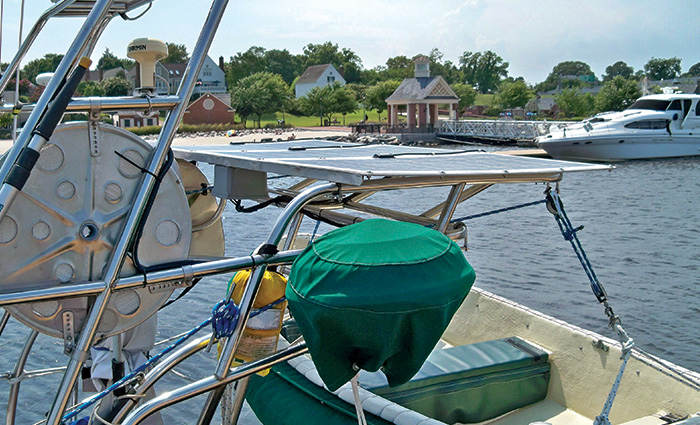
I first embraced the idea of solar power while up a pole (literally) in the Atlantic Intracoastal Waterway replacing dead batteries. It was the early 1980s, and I was maintaining buoys, beacons, and other such Aids To Navigation (ATON) for the U.S. Coast Guard, replacing massive, nonrechargeable batteries with rechargeable solar-powered ones. The higher-ups said the solar rechargeables would last six years – twice as long as the one-shot batteries. As the deck-ape in charge of lugging all those batteries up and down the ladders, my back and I immediately appreciated the whole “free power from the sun” thing, a concept I continue to embrace.
The strategy behind s olar energy onboard is simple: A solar panel converts sunlight into electricity, after which wiring conducts it to your batteries for storage until needed. Solar panels are used to keep batteries or banks charged rather than to power equipment directly. This arrangement allows the panels to store generated power whenever produced, while providing a steady source of power to a piece of equipment even when the panel is producing no power.
While they do require an initial outlay, solar panels can easily pay for themselves in money saved and independence gained over their service life. They’re noiseless, have no moving parts, and they provide free electricity for years with minimal maintenance. Solar panels also have the benefit of being modular, letting you start small and add more as your power requirements increase.
The benefits of solar
Almost any boat can benefit from solar power. Whether at a slip, mooring, or on a trailer, boats can keep their batteries topped off without the need for external power. You can also use solar power to supplement or even replace other onboard charging sources, reducing or eliminating the need to run engines or generators to keep batteries topped off (a wasteful practice that burns fuel while wearing down the costliest pieces of equipment onboard).
While underway, it’s a plus to be able to recharge a dead battery in an emergency – say, to operate a VHF radio or navigation gear. While dockside, solar panels keep batteries charged and vital systems (such as bilge pumps) up and running without the need for shore power.
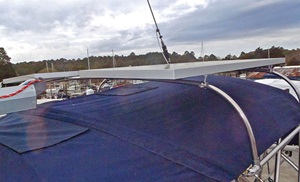
Just about any boat can benefit from solar power, whether it’s to keep batteries topped off or supplement other onboard charging sources.
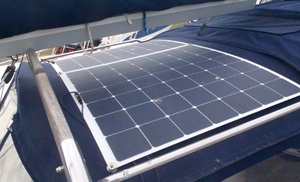
Mount solar panels where they are exposed to maximum sunlight but do not interfere with operation of the vessel.
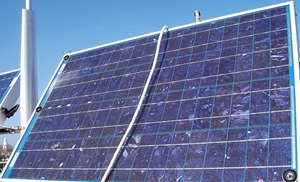
Bottom: Something as simple as the shadow of a line or shroud can reduce or halt output.
Types of panels
Solar panels contain photovoltaic cells – small silicon semiconductor devices that convert sunlight into electricity. Each cell generates between 0.45 and 0.5 volts, depending on exposure to direct sunlight. Cell size determines amperage, with a 3-inch cell producing roughly 2 amps, a 4-inch cell a little over 3 amps, and a 5-inch cell around 5 amps.
Construction-wise, the three main types of solar panels are monocrystalline, polycrystalline, and amorphous (or thin-film) technology.
Monocrystalline panels have been around the longest and remain the most popular. The panels are constructed of thin slices of crystal silicon (each cell is cut from a single crystal) housed in a rigid, aluminum frame and covered with tempered shatterproof glass. The panels have a uniform black, blue, or gray appearance and are generally quite rugged, although they can be cracked or broken if subjected to extreme abuse.
Monocrystalline panels have the longest service life of the three types. With a conversion efficiency of around 17%, they’re also the most efficient and have the highest electrical output per area, but they are also the most expensive.
Polycrystalline cells are sliced from a cast silicon block and have a shattered glass appearance. Built in much the same way as monocrystalline panels, they’re rectangular, giving the panel itself a tiled look. Their life span is similar to monocrystalline panels, and while their conversion efficiency is lower (by 14%), they’re also a bit less expensive.
Amorphous panels are made by placing a thin film of active silicon on a solid or flexible backing (such as stainless or aluminum sheeting) depending on whether the panel is to be rigid-framed and glass-fronted or flexible. Flexible amorphous panels, in which cells are sandwiched between rubber and polymer covers, are light and tough enough that you can walk on them and, in some cases, even roll them up for storage.
This type of solar panel is also better if shade is an issue. With crystalline panels, even the thin shadow of a rope or shroud across one cell can reduce or halt output of an entire module. Amorphous panels have “bypass” diodes that essentially turn off shaded cells and provide a current path around them. Some monocrystalline panels also have bypass diodes, but this feature comes at an increase in cost.
Amorphous panels are the least expensive of the three types, but their efficiency is also lower – around 8%, or roughly half that of a monocrystalline type. This lower output is somewhat mitigated in newer panels, however, which use three-layer construction. Each layer absorbs different colors of the solar spectrum, so the panel will deliver more power longer each day and during lower light conditions than the other two types.
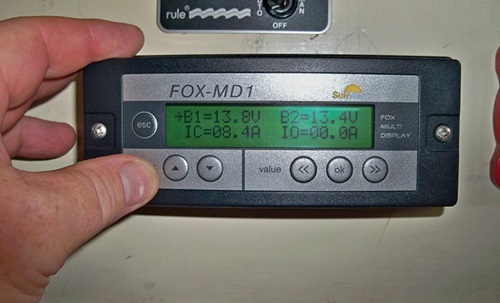
The charge controller should be mounted below decks and as close to the battery as possible.
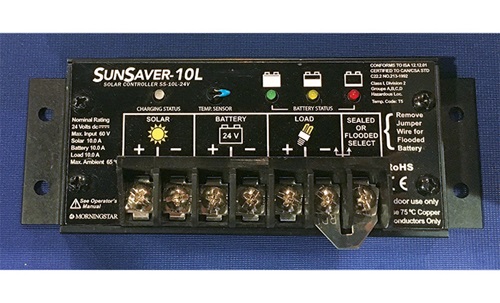
Follow manufacturer instructions for wire connections.
Planning the system
While factors such as cost, mounting options, and output are important, a successful installation depends on knowing what you want the system to accomplish. Is the goal to float-charge a single battery or supplement an overall vessel energy plan? Answering these questions up front will help determine the type, size, and number of panels required.
To understand the process better, let’s walk through the basic steps to determine power requirements and installation considerations for a single solar panel installation. While the example itself is simple, the steps are the same used to plan more complicated installations.
For our example, the goal is to install a solar panel to provide charging for a single 12-volt, 100-amp-hour wet-cell battery used to power an automatic anchor light on a moored vessel.
The first step is compiling a daily power consumption estimate to determine how much solar power is needed.
The daily self-discharge rate for a wet-cell battery is roughly 1%, meaning our 100-amp-hour battery requires one amp every 24 hours just to maintain the status quo. The anchor light draws 50 milliamps per hour of operation, and we’ll assume it operates 10 hours each night. Multiplying current draw (50 milliamps) by hours of daily operation (10) generates a daily energy expense of 500 milliamps or .5 amps.
This means our solar panel must meet a minimum daily energy tab of 1.5 amps – one amp of battery self-discharge rate plus .5 amps of power draw for the anchor light.
Next up is figuring out panel size and the best mounting location. For our example, let’s assume the panel will be a horizontal, fixed-mount installation. A 10-watt horizontally mounted panel should generate between 3- and 5-amp hours per day.
We’ll need at least 13 volts to fully charge our 12-volt battery. As most solar cells generate at least 0.45 volts, you’ll want a panel with a minimum of 33 cells, which should provide around 14.85 volts.
Keep in mind that’s the minimum needed, which may not be enough once you factor in a few cloudy days. Most panels are designed to generate between 15 and 20 volts to overcome problems like cloudy days or inherent electrical resistance within the panel or installation components. While this higher voltage lets you make up for less electrically productive days, it also means you’ll want to install a solar charge controller (voltage regulator) to avoid battery damage due to overcharging.
Attempts to plan a system that tries to use the output of the panel and capacity of the battery to prevent overcharging (and avoid the installation of a charge controller) is false economy and should not be done. The system will never meet its full output potential and, worst case, can damage the battery due to overcharging.
A word on ‘charge controller confliction’
If your vessel has multiple charging sources, such as solar panels and a wind turbine, a crucial but often overlooked consideration is “charge controller confliction.” In short, this is an issue where the charge controller for your solar panel and the charge controller for your wind turbine are internally adjusted to the same maximum charge voltage set point. This means they are constantly fighting each other to be the dominant power source, which results in diminished overall charging output and performance. An in-depth article on this issue can be found at missioncriticalenergy.com (in the website footer, click “Superwind Turbine Manuals & Technical Bulletins.” Under the header “Charge Controllers,” select the document “Resolving Charge Controller Confliction”).
While this article addresses charge controller confliction at remote, off-grid sites, the information provided is also applicable to vessel installations. — F.L.
Location and mounting
Solar panels should be mounted in a location where they are exposed to the maximum amount of sunlight but do not interfere with operation of the vessel or the movement of passengers and crew. Solar panels will typically be either fixed or mounted on some type of movable bracket that allows you to actively point the panel toward the sun for maximum output. Both methods have their pros and cons. Fixed panels (which are normally mounted horizontally) don’t produce as much power as a panel that can be adjusted to face the sun. The downside is that adjustable panels must be aimed throughout the day to maximize their output.
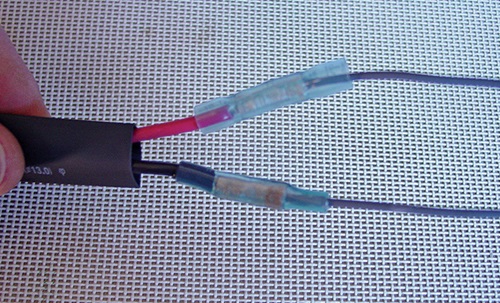
Use good quality, marine-grade heat shrink connectors (top) and liquid electrical tape (right) to create airtight, waterproof seals and reduce corrosion.
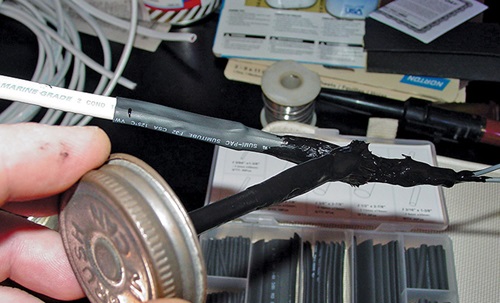
Installation
After choosing and mounting your panel, it’s time to connect it. The first thing you need to determine is the size (gauge) of the wiring to be used. Multiply your panel’s rated amp output by 1.25 (which adds a 25% safety factor). Then measure the length of the entire wiring run, panel to battery, and multiply by 2. Once you have these two numbers, refer to the American Boat and Yacht Council’s (ABYC) 3% voltage-drop table for wire size. Ancor Products offers a handy wire calculator on its website ( ancorproducts.com/resources ).
Always use good quality marine grade connectors and tinned, multi-stranded copper wire with vinyl sheathing. The wire will run from the solar panel to the charge controller first, then to the battery. Try to keep the wire run as short as possible, and if it transits an external deck or cabin house (it likely will), be sure to use an appropriate weatherproof deck fitting.
The charge controller should be mounted below decks and as close to the battery as possible. You’ll always want to follow the manufacturer’s instructions for connections, but in a typical installation you’ll connect the solar panel’s positive (red wire) lead to the charge controller’s positive input wire or terminal and the negative (black wire) lead to the charge controller’s negative input wire or terminal.
Next, connect the charge controller’s negative output to the battery negative terminal and the controller’s positive output to the battery’s positive terminal via an appropriately sized in-line fuse (or circuit breaker). ABYC recommends these be installed within 7 inches of connection to the battery or other point in the DC system. To reiterate, the installation of the charge controller can vary among models, so follow the manufacturer’s installation instructions.
Finally, ensure all connections are waterproof and secure any loose wire runs with wire ties and cable clamps for a neat installation. Then get ready to lean back and soak up some free sun.
Related Articles
The truth about ceramic coatings for boats.
Our editor investigates the marketing claims of consumer-grade ceramic coatings.
Fine-Tune Your Side Scan Fishfinder
Take your side-scanning fishfinder off auto mode, and you’ll be spotting your prey from afar in no time
DIY Boat Foam Decking
Closed-cell foam flooring helps make boating more comfortable. Here’s how to install it on your vessel
Click to explore related articles
Frank Lanier
Contributing Editor, BoatUS Magazine
Capt. Frank Lanier is a SAMS Accredited Marine Surveyor with more than 40 years of experience in the marine and diving industries. He’s also an author, public speaker, and multiple award-winning journalist whose articles on boat maintenance, repair, and seamanship appear regularly in numerous marine publications worldwide. He can be reached via his YouTube channel “Everything Boats with Capt. Frank Lanier” and website captfklanier.com.
BoatUS Magazine Is A Benefit Of BoatUS Membership
Membership Benefits Include:
Subscription to the print version of BoatUS Magazine
4% back on purchases from West Marine stores or online at WestMarine.com
Discounts on fuel, transient slips, repairs and more at over 1,200 businesses
Deals on cruises, charters, car rentals, hotel stays and more…
All for only $25/year!
We use cookies to enhance your visit to our website and to improve your experience. By continuing to use our website, you’re agreeing to our cookie policy.

9 Best Solar Panels for Sailboats
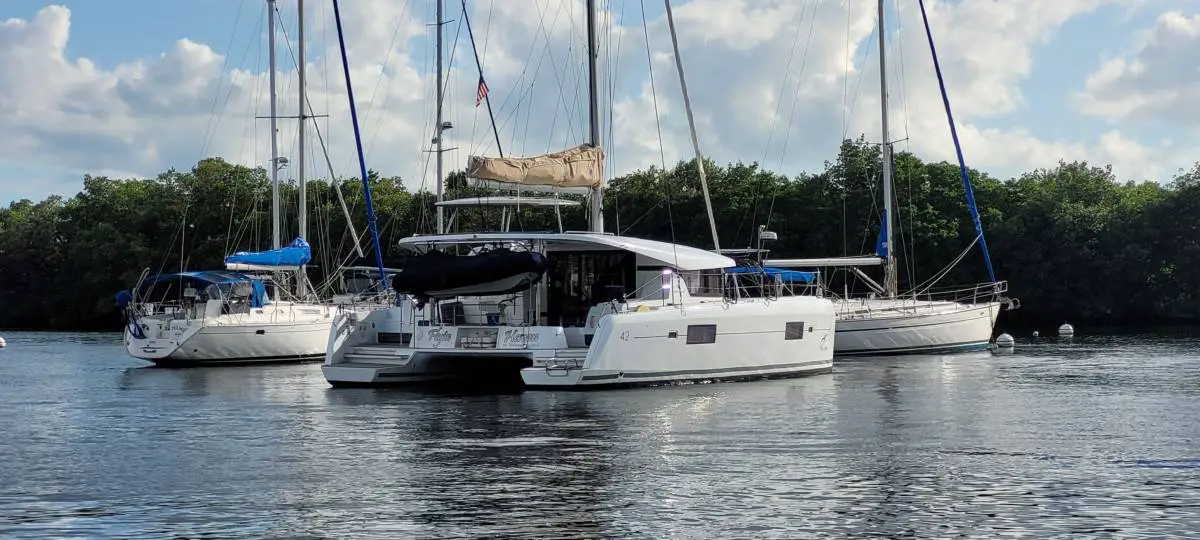
As an Amazon Associate, we earn from qualifying purchases. We may also earn commissions if you purchase products from other retailers after clicking on a link from our site.
Solar panels have become game changers when it comes to supplying power while off the grid. Marine solar panels can charge anything from batteries to computers to bigger electronic appliances. What are the best solar panels for sailboats?
The 9 best solar panels for sailboats are:
- Renogy Flexible Solar Panel
- Newpowa Solar Panel
- SunPower Flexible Sol ar Panel
- Eco-Worthy Off-Grid Solar Panel
- Rich Solar Polycrystalline
- Topsolar Flexible Solar Panel
- HQST Monocrystalline Solar Panel
- WindyNation Solar Panel Complete Off-Grid
- DOKIO Solar Panel Kit
This article will explore everything you need to know about the best marine solar panels.
Table of Contents
Solar Panels on Sailboats: An Overview
Before exploring the best solar panels, it is helpful to consider how solar panels on sailboats work and how many you need. Solar panels sit on different parts of a sailboat’s surface and absorb the sun’s rays, converting them into energy. This energy is used to power chargers, fridges, cooking stoves, and other electronics you need for self-sufficient sailing.
Worth noting is that today we will only discuss solar panels and not the batteries, which of course is an essential part of a complete system; we will also not discuss charges or charge controllers.
The products in this post will get you started in the right direction, but if you’re looking for a high-output system, then I suggest you contact someone that can help you calculate your energy requirements.
How Many Solar Panels Do I Need for My Sailboat?
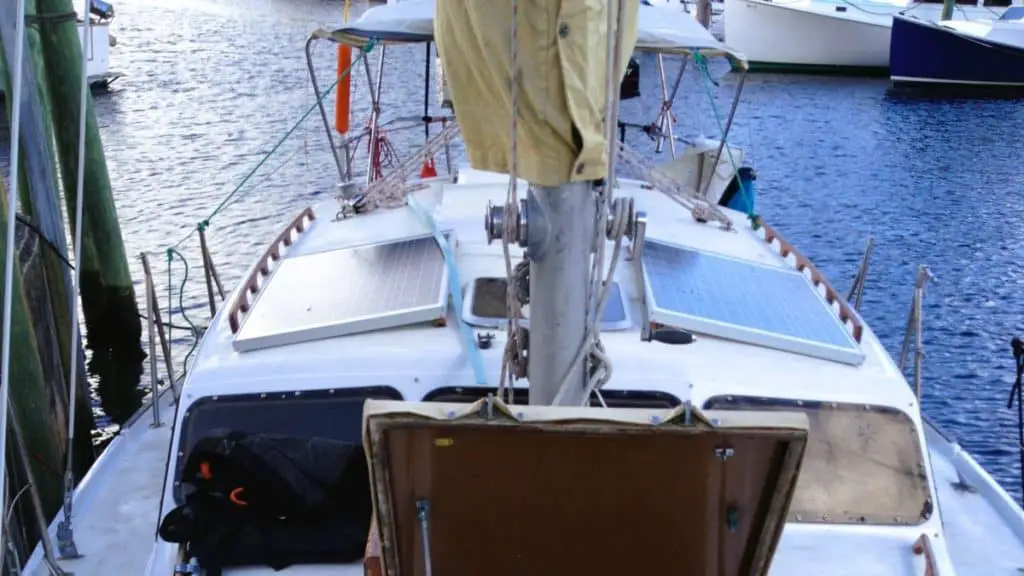
You will need between 2-8 solar panels for your sailboat. The exact amount depends on your sailboat’s space and how many electronics you need to power. Most solar panels can absorb between 100-300 watts per hour. On average, you will need approximately 1500 watts of power each day.
If your solar panels absorb 1500 watts daily, here’s what they can power on your sailboat:
- A laptop charger
- A microwave
- A coffee maker
- An induction cooker
If you want to power more heavy-duty electronics like a washing machine or a television, look for solar panels that absorb 400 watts. For heavy-duty electronics, try installing 5-8 solar panels.
Flexible vs. Rigid Solar Panels
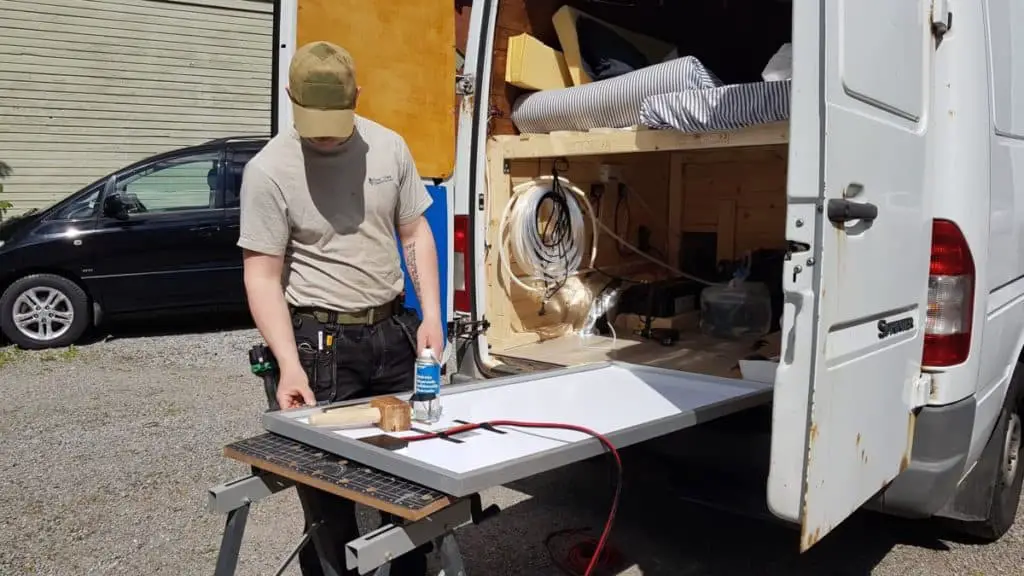
The three main types of solar panels are rigid panels, flexible panels, and semi-flexible panels.
Rigid panels are surrounded by aluminum and made with sturdy tempered glass. They are resilient against various weather conditions but require flat space to install.
Semi-flexible panels can be slightly bent to fit the shape of the installation surface. However, they can’t absorb a lot of power.
One very common type of solar panel used on boats is the flexible panel . Flexible panels are thin and lightweight, and, as their name suggests, they can be added to a wide variety of surfaces.
Here are the pros of flexible panels:
- They are thin and light. Flexible panels are approximately one-eighth the weight and size of rigid and semi-flexible panels. This allows you to add them to various sailboat sizes and surfaces. It also reduces the load on your sailboat.
- They are easy to install. Flexible panels are easy to work with and can be self-installed by following the instructions that come with the panels. Meanwhile, rigid and semi-flexible panels may require expert installations.
- They’re sturdy. Despite being light, flexible panels can bear a lot of pressure – you can easily walk over them.
However, there are also some drawbacks to using flexible solar panels:
- May fly away . As flexible panels are fragile, they can easily be dislodged and fly away, especially in strong winds.
- Vulnerable to scratches . While flexible panels can bear much weight, they may get scratched more easily. Over time this may affect their functionality.
- Not easy to reposition. Flexible panels are generally adhered to the surface of a sailboat using a specially prepared adhesive. Because of this, it is challenging to reposition the solar panels when there is a change of season.
- Less efficient. Flexible solar panels don’t convert energy to electricity or rigid panels. It may be harder to power heavy-duty appliances from a flexible solar panel.
How Many Panels Can I Fit on a Sailboat (Catamaran and Monohull)?
The amount of panels you can fit on your sailboat depends on the size of the panels and the surface space you have available.
You can fit at least two 400W panels on a Monohull and at least four on a Catamaran around 35ft in length. You will be able to fit 4-8 more solar panels if you add a solar panel bracket at the stern.
Renogy Flexible Solar Panel 100W
Renogy is a popular solar panel producer that designs high-quality solar panels. The Renogy Flexible Solar Panel is specially designed for marine vehicles, including sailboats.
Here are the best features of this solar panel:
- Flexibility . These solar panels are fragile, making them flexible and easy to mount on served surfaces.
- Easy to install. These are made with high-quality Monocrystalline, allowing them to be easily bent and easy to install.
- Lightweight. One solar panel weighs only 4 pounds, ensuring that no extra pressure or weight is displaced on your boat.
- Durability . User reviews have noted that these panels are highly durable and can last you a few years.
- Users have noted that these panels do not have the best outputs. They also can’t be stacked, which impacts their accessibility. To ensure that these panels can be connected, you may purchase extra extension cords.
Newpowa Rigid 160W Solar Panel
The Newpowa Right Solar Panel is a new design with a maximum power of 160W. It is weather-resistant and can be used on various surfaces and vehicles.
Here are the pros of the Newpowa Solar Panel:
- Weatherproof . The design features of this solar panel ensure that it survives under a range of different weather conditions. It has a heavy-duty frame preventing it from strong wind and waves. Its mainframe has a further layer of protection for the Junction box.
- Long warranty . Newpowa offers a 25-year transferrable output power warranty.
- Easy to install . These solar panels are made with mono cells and bypass diodes. Consequently, the solar panels can be immediately unpacked and are ready to install.
- High wattage. As these solar panels have 160 Watts of power, you need less of them to power all the devices on your boat.
- If you are planning on buying the Newpowa Solar Panel, you should note that they only make rigid panels. As a result, you may find it to be difficult to install them on curved spaces.
SunPower 110W Flexible Solar Panel
SunPower’s Flexible Solar Panels are made with high-quality materials ensuring durability. They are especially ideal for sailboats as their warranty also covers saltwater damage.
Here are the standout features of the SunPower 110W Flexible Solar Panel:
- Flexibility . This solar panel can be bent up to 30 degrees, making it easy to install on various surfaces.
- Easily portable. These solar panels are incredibly lightweight (4.4 pounds or 2 kilograms) and can be easily uninstalled and transported.
- Extended warranty . SunPower offers a five-year warranty on power and a two-year warranty on the product. The warranty includes damage caused by saltwater which many other solar panel warranties do not.
- Some users have noted that the output quality of these solar panels deteriorates over time. However, you can use the extended warranty to address any quality deterioration.
ECO-WORTHY Rigid 25W Off-Grid Solar Panel
This is a rigid, 25-watt solar panel that is waterproof, making it ideal for your boat. It is highly durable and has inbuilt indicators that highlight the battery’s status. Its low output makes it only suitable for charging phones or smaller electronics.
Here are some notable features of the Eco-Worthy Solar Panel:
- Ease of use. This solar panel is easy to install and requires no maintenance.
- Warranty. Eco-Worthy offers one year of warranty on all of its products and free maintenance if needed.
- USB control. This solar panel is attached to a USB control panel, preventing it from overcharging and getting damaged.
- Waterproof. All solar panel parts are entirely waterproof and can handle exposure to both saltwater and freshwater.
Some of the drawbacks to this solar panel include:
- Low watt absorption. Unlike many of the other solar panels on this list, this one can only absorb up to 25 watts of power at a time. So, it can only power smaller devices like batteries.
- Instruction manual. Some users have noted that the instructions to set up the Eco-worth solar panel are confusing for beginners. If you have never installed solar panels before, it’s best to call in an expert to help.
RICH SOLAR 100W Rigid 12V Polycrystalline
This 100W rigid solar panel is designed to absorb energy even in low light conditions. It is easy to install and ideal for marine environments.
Here’s why you should consider buying Rich Solar Panels:
- Works well in low light. This solar panel has been tested in various low light conditions, including cloudiness and during sunrise and sunset. It is certified to be able to harvest energy in low light conditions.
- Extended warranty. Rich Solar Panels offers a 25-year warranty on limited power output and a five-year warranty on quality.
- Water and weatherproof . The Rich Solar panels have used selective design elements to ensure they are water-resistant. They have high transparency and are made with tempered glass to withstand high winds and water pressure.
- Cost-effective . These are significantly cost-effective, making it easy to equip your sailboat fully.
- While solar panels can easily resist strong winds and water, they can be vulnerable to hail. Hail storms can cause dents on the solar panels, which can eventually cause damage.
Topsolar Flexible 100W Solar Panel
Topsolar provides premium flexible solar panels that are easy to move and install. They are ideal for installing on water vessels like sailboats with waterproof materials.
Here are some of the pros of choosing the Topsolar Flexible Solar Panel:
- Flexibility . The arc radius of this solar panel is 16 inches (40 centimeters) and can be bent to fit several curved surfaces allowing your solar panel to harvest the most sun.
- Efficiency . These solar panels are made with ETFE (ethylene tetrafluoroethylene) materials. They are extremely energy efficient and can rapidly convert energy.
- Some users have noted that these solar panels don’t have as long a life as other panels. In addition, some panels may only be able to absorb up to 75 watts of power at a time.
HQST Rigid 100w Monocrystalline Solar Panel
This is a 100-watt solar panel that has been specially designed to perform well in low light. It is made with high-quality materials and is ideal for sailing boats as it is durable even in unfavorable weather conditions.
Here are the pros of installing the HQST Solar Panel:
- Durability . These solar panels are designed to withstand strong winds and snowfall. They’re made with tempered glass and aluminum and are resistant to corrosion, ensuring longevity.
- Testing and warranty. Each solar panel is quality tested before it is distributed. It also comes with a three-year warranty.
- Easy to install . While these are rigid solar panels, they have pre-drilled holes, making them easier to install.
WindyNation 100W Solar Panel Complete Off-Grid
As its name suggests, this solar panel is designed for off-the-grid living and is helpful if you need to access power when you’re in the middle of the sea.
Here is why you should consider the WindyNation Solar Panel:
- Includes a charge controller. This controller lets you quickly see the amount of power the solar panel has absorbed.
- High power. Several positive user reviews have indicated that this solar panel is highly efficient in absorbing and converting power.
- This solar panel is more expensive than many others on the market.
DOKIO 300W 18V Portable Solar Panel Kit
If you are looking for a heavy-duty solar panel, the Dokio Solar Panel Kit is excellent. It can absorb a lot of energy and power a wide range of appliances on your sailboat.
Here’s why you should consider this solar panel:
- Versatile and flexible. While this is a rigid solar panel, it can be folded, making it easy to transport and install.
- High efficiency. This solar panel is highly efficient at converting energy into power. As it absorbs up to 300 watts, you can install just two of these panels to get significant energy.
- Some users have noted that this solar panel does not work well in low-light conditions. You may want to have a backup solar panel for days when it’s rainy and windy.
Here are Some of My Favorite Catamaran Cruising Resources
Thank you for reading this article. I hope you found it helpful as you hopefully start your sailing adventures. Here are some resources that I use as a sailor that I hope you’ll also find helpful. These are affiliate links, so if you do decide to use any of them, I’ll earn a commission. But in all honesty, these are the exact things that I use and recommend to everyone, even my own family. Sailboats: If you’re looking for the best boat to suit your needs, I would recommend a catamaran. If you’re interested, I can show you the differences between catamarans and other types of sailboats .
Books: For getting started, I really like Cruising catamarans made easy . It is actually a textbook from the American sailing association; it is used to get a cruising catamaran certification. There are some other great books, and I have compiled a list of books about cruising catamarans that you will find useful.
Communication: Being out on adventures, whether it be sailing or climbing mountains, good communications are essential to being safe. I recommend two things Google fi (incredibly simple cellular data all over the world) and Garmin inreach mini (for text and voice in remote areas without cell coverage)
Sailing courses: Online sailing courses are great for beginners starting out their sailing career; it’s an efficient way of learning the basics of navigation, throttle controls, and maritime safety. I suggest starting with two free courses from NauticEd .
To see all my most up-to-date recommendations, check out this resource that I made for you!
Owner of CatamaranFreedom.com. A minimalist that has lived in a caravan in Sweden, 35ft Monohull in the Bahamas, and right now in his self-built Van. He just started the next adventure, to circumnavigate the world on a Catamaran!
Leave a Reply Cancel reply
Your email address will not be published. Required fields are marked *
Save my name and email in this browser for the next time I comment.
Recent Posts
Must-Have Boat Gear for Catamaran Sailors!
Sailing is probably the most gear-intensive activity I've ever done; there are so many decisions to be made about what gear to buy now, for tomorrow, and what to definitely never buy. The gear on...
6 Best Trailerable Trimarans For Bluewater and Coastal Sailing
Having a boat costs a lot of money, even when you are not using it, marina fees, etc. And once it is in the water most sailors never go very far from their "home marina" and sailing will be somewhat...
- Sign in / Register
- Comparison list
- Solar on the go
Picking the best solar panels for a sailboat: Buyer’s guide
- 18 Aug 2022

You might have already heard of brave sailors that conquer the oceans with nothing but wits and solar panels. For instance, this year 83-year-old Kenichi Horie became the oldest person to sail solo from the US to Japan on a solar-powered boat. These stories are inspiring, but picking panels for your boat yourself can be a small challenge in itself. That’s why we wrote a short article about the best solar panels for sailboats and how to recognize them.
Start from type of solar panels
When it comes to solar panels for sailboats, their weight and size matters more than with PV modules for residential systems. Efficiency is important but power — not that much, because the energy needs of a boat are relatively low. The first thing you’ll have to decide about your panels is their type.
Generally, you’ll choose between thin-film panels and monocrystalline modules. While polycrystalline panels are still around and they are indeed cheaper than mono panels, they are much less efficient, which means they’ll need more space and add more weight to your boat.

Thin-film panels are light and cheap
Thin-film or flexible solar panels bend well and they are very easy to install which makes them a great choice for boats with difficult configurations. Some sailors say that flexible panels are the best choice for fast boats because they don’t impact the aerodynamics of a vessel as much as rigid panels do.
The downside of flexible panels is their low wattage. If there are many appliances on board, you’ll need several panels and you’ll need to find the right place for each of them. They also age faster than rigid panels — a thin-film panel generally lasts for 10-15 years.
Monocrystalline panels are powerful and reliable
Rigid solar modules, monocrystalline and polycrystalline, are heavier and bulkier than thin-film panels. You can fix flexible panels with adhesives, but rigid panels require drilling. They are also more expensive than flexible panels.
On the other hand, monocrystalline panels are the most efficient type of panels which means that they provide more power for less space. Even one powerful mono panel can be enough for everything that you’ve got on board. They are also much more reliable and will survive any storm that is coming your way. A monocrystalline panel lasts for at least 25 years.
Panels for boat should be efficient and sturdy
The best solar panels for sailboats don’t have to be powerful, but they better be efficient — find the number in the datasheet. For rigid panels anything over 18-19% is fine. Panels also should be sturdy enough to withstand seastorms. You generally also want good shading tolerance since panels often get shaded by masts and sails. Finally, good performance in low-light conditions is appreciated.
Picking bifacial panels, 72/144-cell panels or larger, anything too powerful generally doesn't make a lot of sense. Performance at high temperatures matters less than it does with home systems. Warranties also play a lesser role. You won’t be able to make use of them because they generally have effect only for residential installations.
The markets of thin-film and rigid panels are different. Generally, a manufacturer of flexible panels doesn’t offer mono- or poly-panels. Canadian Solar, Q CELLS and Jinko Solar are good choices when it comes to monocrystalline modules for boats. Renogy , WindyNation and PowerFilm make fine thin-film panels.
Do the math before purchase
The amount of power for your boat depends on the number of appliances on your board. There are two main ways to determine the size of installation that you need. You can take a test trip and see how much of your battery’s charge you’ve spent in one day. You can also do the calculations manually: write down all the appliances on the board with their power rating and number of hours in use per day. You can read about it in detail in our article " How much solar power to sail the seas? " It doesn’t make sense to oversize a marine PV system, because all the excess power will just go to waste.
Keep in mind that adding photovoltaics doesn’t make your vessel a solar boat, unless you have a solar-powered motor. You can switch your boat to solar energy fully, especially if it’s small, but you’ll have to calculate your energy needs accordingly.

Once you’ve purchased your panels, you’ll have to install them properly. You can order professional service or do it yourself. The most popular places for solar panels on a boat are a stern rail, masts, deck and canvas. Thin-film panels can even go on the sails. Ideally, you want a place where panels wouldn’t be shaded by masts on any other parts of a boat.
List of solar panels for a sailboat
We’ve asked our engineer to pick the panels that would complement a small boat well. These are his choices:
ZNShine Solar ZXM6-NH120-370/M

Solar panels from ZNShine Solar are inexpensive and fit all kinds of applications, including boat systems. ZXM6-NH120-370/M provides 370 Watts of power with a 19.88% efficiency. It performs well in low-light conditions. Graphene coating increases power generation and allows self-cleaning. The only downside is a lower wind tolerance, compared to other models: it is rated to withstand 2400 Pa pressure which is comparable to 140 mph wind.
Mission Solar MSE345SX5T

MSE 345 is a simple solar panel for all kinds of applications, including boat installations. Mission Solar panels are manufactured in Texas. The module provides 345 Watts of power with 18.7% efficiency. It is certified for high snow (5400 Pa) and wind loads (4000 Pa). The model is resistant to salt mist corrosion.
Suntech STP 365 S

Suntech is a Chinese company that offers quality budget-friendly solar panels. The STP365S model stands out in line because of its great performance in weak light, such as cloudy weather and mornings. It is designed to withstand harsh weather conditions, and the module is certified to tolerate wind of over 170 mph. Half-cut design makes cells sturdier and improves shading tolerance. Overall, this panel earns a place among the best boat solar panels.

Andrey had been a news editor and freelance writer for a number of medias before joining A1SolarStore team. Climate change and its impact on people's lives has always been among his interests and it partially explains his degree in Philosophy and Ethics.
Solar monitoring systems: All under control
Inergy solar generators review: Taking charge
AC vs DC-coupled solar battery systems: Pros and cons
How to clean RV solar panels
Solar panel size range: From tiny to large
Learn about the latest arrivals and discounts first!
By clicking "Subscribe", I agree by electronic signature to: (1) receive marketing and other texts and messages from A1SolarStore, directly or from third parties acting on its behalf, at the email address I entered above; (2) the Terms and Conditions ; and (3) the Privacy Policy .
- Hiking Shoes
- Hiking Boots
- Hiking Sandals
- Trail Runners
- Base layers
- Hiking Shirts
- Fleece Jackets
- Softshell Jackets
- Rain jackets
- Down Jackets
- Hiking Pants
- Hiking Shorts
- Base Layers
- Rain Jackets
- Hiking Bras
- Baby Carriers
- Cookware Sets
- Water Filters
- Water Purifiers
- Sleeping Bags
- Sleeping Pads
- Hiking Poles
- GPS Devices
- Solar Chargers
- Dive Regulators
- Dive Computers
- Dive Watches
- Dive Wetsuits
- Dive Gloves
- Dive Lights
- Dive Knives
- Spearfishing Wetsuits
- Spearfishing Masks
- Spearfishing Fins
- Spearfishing Watches
- Freediving Wetsuits
- Freediving Masks
- Freediving Fins
- Freediving Watches
- Sit On Top Kayaks
- Inflatable Kayaks
- Fishing Kayaks
- Tandem Kayaks
- Touring Kayaks
- Kayak Paddles
- Kayak Seats
- Kayak Roof Racks
- Kayak Carts
- Stand Up Paddle Boards
- Touring SUPs
- Inflatable SUPs
- Fishing SUPs
- SUPs For Yoga
- SUPs For Surfing
- SUP Paddles
- Climbing Boots
- Belay Devices
- Climbing Shoes
- Women's Climbing Shoes
- Bouldering Shoes
- Approach Shoes
- Climbing Pants
- Bouldering Pants
- Mountain Bikes for Men
- Mountain Bikes for Women
- MTB Handlebars
- Bike Saddles
- Bike Computers
- Bike Lights
- MTB Jackets
- Bike Helmets
- Bike Packing Gear
- Fat Biking Gear
- Ski Bindings
- Ski Helmets
- Ski Goggles
- Ski Jackets
- Snowboarding Bindings
- Snowboarding Boots
- Snowboard Helmets
- Snowboard Goggles
- Snowboard Pants
- Snowboard Jackets
- Snowshoe Poles
- Avalanche Beacons
- Avalanche Probes
- Avalanche Shovels
- Ski Backpacks
- Surfboards For Beginners
- Surfboards For Kids
- Surfboard For Small Waves
- Soft Top Surfboards
- Foam Surfboards
- Body Boards
- Boogie Boards
- Kiteboarding Kites
- Kitesurfing Boards
- Kiteboarding Harnesses
- Surfing Wetsuits
- Men's Rash Guards
- Women's Rash Guards
- Board Leashes
- DLSR Travel Cameras
- Mirrorles Travel Cameras
- Point and Shoot Travel Cameras
- Fuji Travel Lenses
- Nikon Travel Lenses
- Tripods for Travel
- DLSR Landscape Cameras
- Mirrorles Landscape Cameras
- Point and Shoot Landscape Cameras
- Fuji Landscape Lenses
- Nikon Landcape Lenses
- Canon Landcape Lenses
- Tripods for Landscape Photo
- Wildlife Cameras
- Wildlife Lenses
- Wildlife Tripods
- Wildlife Monopods
- Birdlife Cameras
- Birdlife Lenses
- Surfboards For Small Waves
Best Solar Panels For Sailboats of 2024
Sailing uses the power of the wind to move, so why not use the power of the sun to charge your batteries? Solar panels offer the best way to charge boat batteries. This method can also save the engine from being used just for charging. Getting the best solar panels for sailboats means choosing the right size and power for your boat.
But, how much power will you need? Will your panels be able to keep up even on cloudy days? Do you plan to sail in cold water or deep in the tropics? Do you need the panels to sit on a curved surface? There’s a surprising amount of factors to consider when purchasing sailboat solar panels.
Whether you’re replacing old panels or buying for the first time, let us do the hard work of comparing the best solar panels for your boat.
For more of our top sailing gear recommendations, check out the Best Wind Generators for Sailboats .
QUICK ANSWER – THE BEST SOLAR PANELS FOR SAILBOATS
- Nature Power Monocrystalline
- Nature Power Rigid
- Renogy Starter Kit (4 panels)
- Newpowa Poly Solar Panel
- Acopower Polycrystalline
- Nature Power 90W Rigid
- Newpowa 150W
- Suaoki SunPower
- Eco-Worthy Semi-Flexible
SAILBOAT SOLAR PANEL REVIEWS
Nature power monocrystalline.
Check out the latest price on: Amazon | West Marine
BEST FOR: Efficient high-power use
WEIGHT: Unspecified
WATTS/AMPS: 120W/6.6A
SIZE: 45.1” x 33.6” x 3”
PROS: Foldable for easy storage and portability, pop-out legs that allow it to easily sit at an angle, sturdy design
CONS: On the upper end of the price spectrum, short warranty
NATURE POWER RIGID
BEST FOR: Energy-hungry boats
WATTS/AMPS: 165W/9.4A
SIZE: 57.8” x 26.3” x 1.4”
PROS: Powerful and efficient, scratch resistant and anti-reflective coating, well-built aluminum frame, easy-to-use connections
CONS: Powerful but expensive, only suitable for larger boats with a big flat space to set it up on
RENOGY STARTER KIT (PACK OF 4 PANELS)
Check out the latest price on: Amazon
BEST FOR: Large boats needing lots of power
WEIGHT: 18.0lbs
WATTS/AMPS: 400W/22A
SIZE: 4 x 47.0” x 21.3” x 2.0”
PROS: Includes x4 100W panels along with a charge controller and everything else needed to set up, ideal for sailors looking for a lot of power, easy mounting system, great price for a comprehensive kit
CONS: Rigid solar panels can only be on flat surfaces or mounted on rails, included charge controller might not be the charge controller for your needs
NEWPOWA POLY SOLAR PANEL
BEST FOR: Keeping small battery banks topped up
WEIGHT: 6.3lbs
WATTS/AMPS: 30W/1.7A
SIZE: 27.0” x 14.3” x 1.9”
PROS: Sturdy design, small and slim making it ideal for stern rail, wattage should be enough to trickle-charge medium battery banks, very affordable
CONS: Rigid design means placement is limited, heavy for a small panel
ACOPOWER POLYCRYSTALLINE
BEST FOR: Larger sailboat trickle-charging
WEIGHT: 6.9lbs
WATTS/AMPS: 35W/2A
SIZE: 29.9” x 16.1” x 1.7”
PROS: Looks neat with silver aluminum frame, should be able to easily keep batteries topped up and contribute to energy requirements when boat is in use, very affordable and slim, other wattages available
CONS: Weighty, aluminum frames can have sharp corners
NATURE POWER 90W RIGID
Check out the latest price on: West Marine
BEST FOR: Permanent mounting
WEIGHT: 15.2lbs
WATTS/AMPS: 90W/4.9A
SIZE: 33.7” x 26.5” x 1.0”
PROS: Sturdy frame can be mounted on gantry rails permanently, good power output and small enough to be mounted alongside an identical panel for double power, long warranty, reputable brand
CONS: Awkward to move about the deck so not ideal for portable panel, fairly heavy
NEWPOWA 150W
BEST FOR: Medium to large sailboats
WEIGHT: 24.4lbs
WATTS/AMPS: 150W/8.3A
SIZE: 58.4” x 26.6” x 1.2”
PROS: Great for permanent mounting, powerful and well-built,
CONS: Very heavy, only comes with 3ft of cable which may well be too short and require extension
SUAOKI SUNPOWER
BEST FOR: Smaller, lightweight sailboats
WEIGHT: 4.8lbs
WATTS/AMPS: 100W/5.6A
SIZE: 43.3” x 22.4” x 0.1”
PROS: 30-degree curve possible making this ideal for boat coach roofs, very thin makes for less dirt buildup and less wind resistance, good price for a powerful panel
CONS: Cable connections are on the top of the panel which may encourage corrosion and UV damage
ECO-WORTHY SEMI-FLEXIBLE
BEST FOR: Coach roofs and curved deck areas
WATTS/AMPS: 100W/5.5A
SIZE: 47.4” x 21.6” x 0.1”
PROS: Capable of a 30-degree curve making it suitable for coach roofs and curved decks, thin and durable construction
CONS: Connector on top allowing salt build-up and accidental damage
COMPARISON TABLE – THE BEST SOLAR PANELS FOR SAILBOATS
How to choose the best solar panels for sailboats, 1. required energy.
Buying solar panels for your sailboat involves more than going over a few models at random. You need to know how much power you’ll need daily. Also, you need to determine whether you will rely solely on solar power or use the engine as well.
SOLAR AND ENGINE
Will you use solar power most of or all the time? If yes, then you will need higher power, larger or more solar panels. If you plan to use the engine more, then you won’t need as much solar power.
Your sailing goals come into play in this decision. If you want to cruise the intercoastal waterways, chances are you’ll be using your engine a lot. If you plan on cruising the Caribbean, you can often rely on good winds for sailing.
Once you’ve worked out how you plan on powering your sailboat – solar and engine, or just solar – you’ll need to work out your daily amp draw . If you’ll be running a fridge, freezer, water maker, VHF and SAT NAV all day long, you’re definitely going to need a lot of power!
It can be difficult to determine how many amps your sailboat will need, especially if you still don’t have all the electronics you plan to bring on board. Some products will give you an idea of their power draw in their technical specifications. For others that don’t provide that information, you may have to settle for an estimate.
Once you have an idea of your daily amp draw, then you can work out the solar output required to keep up with that power draw. But there are other considerations too, namely, actual output vs maximum output.
ACTUAL OUTPUT VS MAXIMUM OUTPUT
While a 90W solar panel might sound like it’ll give out 90W, remember that this is its maximum output. That is, it refers to a clean panel in full sunshine. It won’t be giving anywhere near that output on cloudy days. In the case of a fixed panel, ask yourself if the sail will be casting a shadow over it on one tack.
Unless you plan on running the engine to top up the batteries on cloudy days, you will find yourself needing enough solar panel output for these times. Make sure to also consider the times when your panels aren’t giving out their optimum performance.
TEMPERATURE CHANGES
If you’re starting in Nova Scotia, your fridge won’t take much power to keep it at a cool temperature. But, what happens when you sail south to go diving in Mexico ? Suddenly, the water temperature is higher and the fridge would have to work twice as hard to stay cool. While good insulation is a bonus on a sailboat, it’s important to remember that atmospheric changes like temperature may mean an increase (or decrease) in your power requirement.
ARE WE TALKING AMPS OR WATTS?
While you need to know how many amps your sailboat will draw on a daily basis, solar panels are sold by watts. There’s no need for that to be confusing though, as we’ve also provided the amps in the chart. You can read more about watts and amps to get a better understanding.
2. HOW MANY SOLAR PANELS DO YOU NEED?
Many sailboats have more than one solar panel. This means you won’t need to move the panels to follow the sun or as the boat shifts at anchor. Having multiple solar panels also allows you to have smaller panels, which tend to get in the way less. Your required power output can be divided among them as well.
If you need 200W a day, then you could have three 90W solar panels on different parts of the boat and be covered power-wise, even on different tacks.
How much space do you have on deck? Where you place your solar panels is very boat and sailor dependent. Day-sailing in hot places? Solar panels on the bimini rack are an easy solution. Long-distance cruising? You’ll need solar panels that are efficient yet out of the way to improve windward performance.
If you spend a large amount of time on board, your energy consumption will be higher. You’ll need your solar panels to be as efficient as possible. Many cruisers have panels on top of gantries on the stern to keep them in sunshine all the time. This is terrible for sailing performance, so you have to think about where you want to compromise. Don’t forget to consider the other on-deck items, such as your paddle board , as well.
Solar panels generally come in two types: mono- and multicrystalline and amorphous thin film silicone. However, all solar panels listed in this article will be mono- or multicrystalline as they are the most effective.
MONO- AND MULTI-CRYSTALLINE
Efficient and sturdy, these panels will probably make up your core solar panel collection. For everything on board like lights, fridge, radio and navigation electrics, mono-and multicrystalline are your best bets. They aren’t forgiving on cloudy days though, and even a shadow over the corner of a panel will pull down the output by a lot.
AMORPHOUS THIN FILM SILICONE
Not as efficient as crystalline panels, amorphous panels are cheaper and flexible. They’re good for trickle-charging batteries while the boat is left unattended.
Solar panels are expensive, but their prices have been dropping over the years. If you only use your sailboat for summer weekends, chances are you won’t need pricey, hyper-efficient panels. You just need enough to keep up with your power consumption for two days a week and let the trickle-charge solar panel do the rest.
Take your solar panel budget and split it between the number of solar panels you think you’ll need. Keep in mind though that you’ll most likely need to buy a charge controller as well.
For more of our top sailing gear recommendations, check out these popular buyer's guides:
Sailboat Anchors
Sailboat Winches
Sailing Shoes
Solar Panels for Sailboats
Bilge Pumps

The best of EcoWatch right in your inbox. Sign up for our email newsletter!
- About EcoWatch
- Contact EcoWatch
- Terms of Use
- Privacy Policy
- Learn About Solar Energy

Top 5 Best Solar Panels for Boats (2024 Marine Buyer’s Guide)
In this guide, you’ll learn:
- Why photovoltaic (PV) equipment is great to have on your boat
- Which panels are best suited for use on the water
- What qualities make for a great boat solar panel
Each product and or company featured here has been independently selected by the writer. You can learn more about our review methodology here. If you make a purchase using the links included, we may earn commission.
Why Should You Install Solar Panels On Your Boat?
Before we dive into the best panels to bring your boat into the world of clean energy, it’s worth discussing why you’d want a solar panel system on your boat in the first place.
There are a few use cases that are important to consider. These not only dictate whether or not you need panels on your boat, but they can also help you decide which system is the best and most cost-effective for you. We’ll discuss the different reasons to go solar on your boat below.


Blue Raven Solar

Regional Service
EcoWatch rating
Average cost
- Industry-leading in-house financing
- Competitive pricing
- Excellent reputation
- Doesn't offer solar batteries (coming 2022)
Charging Emergency Equipment
For anyone who has run into issues out at sea, the need for reliable emergency equipment is well understood. Whether you run out of gas, your boat breaks down or you have some other issue that precludes you from getting back to shore, having a way to reach out for help will keep your mind at ease.
Depending on the type of boat you have and how well it’s equipped, you may have a radio system, a satellite phone, a regular phone or some other communication device for emergencies. All of these require power, and having a solar system on your boat ensures that you’ll always have access to these devices.
Charging Recreational Equipment
Even if you’re not running into problems at sea, you might want the ability to charge recreational equipment. It’s always nice to have the ability to charge smartphones, e-readers, speakers and other devices you might use for entertainment.
This is especially important if you plan on spending a few days at sea and don’t want to rely on your boat’s batteries. Keeping those well charged for lighting, navigation tools and starting your boat’s engine is more important than getting your phone up to a full charge.
Quality of Life at Sea
For a lot of people, there’s a lot of joy in upgrading life at sea and making things just a little more comfortable. One of the perks of installing a solar system on your vessel is that you don’t have to worry about using your boat’s batteries for non-necessities.
For example, many recreational boaters connect their solar array to an electric cooler. Others use their solar modules to power electric water heaters for hot showers and constant hot water.
The possibilities for improving your at-sea experience with solar are really up to you, which is part of what makes bringing renewable energy to your boat so exciting.

What Are the Top 5 Best Solar Panels for Boats?
If you’re convinced you want to install solar on your boat, but you don’t know much about the available options, you might be overwhelmed by the choices. You’ll have access to seemingly countless brands and models.
To help you narrow down your options and choose panels that will meet your needs, we’ve done extensive research and chosen just a few product lines that we recommend. We’ll provide a quick breakdown of the different options below, and we’ll dive deeper into the specifications in later sections.
SunPower 170W Solar Panel
SunPower is a leader in the residential solar industry, so it’s no surprise that we found that the company also makes the best solar panels for use on boats.
This panel is pricey, but it’s significantly more powerful than most other options. At 170 watts, you can use these panels to charge your boat’s main battery, provide backup power for emergencies, or live large on the water by powering coolers, hot water heaters and much more.
This panel doesn’t come with a solar charge controller like many other options do, so not only is it expensive, but you’ll have to lay out more money for a controller, inverter and battery. However, we believe the efficiency and power output are well worth the investment.
These panels are also rated with a waterproof rating of IP67, which means they can withstand immersion in water up to about three feet for around half an hour. If you need more protection than that, you have bigger problems on your hands than losing a panel.
- High-efficiency panel for maximum power
- High-quality, durable materials
- Trusted and reliable brand
- Waterproof up to a meter for 30 minutes
- Doesn’t include any equipment other than the panel
Renogy 100W Flexible Marine Solar Panel
The Renogy Flexible solar panel designed specifically for use on the water is our pick for the best bang for your buck. It’s about half the price of the SunPower panel, although it does have a little more than just half the power capacity.
At 100 watts, this panel is great for middle-of-the-road power. It can serve as a reliable backup source of energy, or you can use it to recharge phones, GPS devices, e-readers, laptops and other electronics. It’s possible to use it for the quality-of-life items mentioned above as well.
This panel also has an IP67 waterproof rating, which is ideal for maintaining peace of mind on the water. Although it’s less expensive than our top pick, it includes a controller and wiring to connect your panels. You’ll just need an inverter and a battery to complete your setup.
- Excellent power output
- IP67 waterproof rating
- Includes controller and wiring
- Reliable brand name
- More expensive than many other options
- Doesn’t include a battery or inverter
EcoWorthy 25W Solar Panel Kit
The EcoWorthy solar panel kit is one of the easiest photovoltaic (PV) systems to install, so it’s our top pick for those looking to get started with clean energy. You can purchase this kit with a 10 amp-hour (AH), 12-volt battery, and the MC4 connectors are plug-and-play for a quick and painless installation.
This panel has a much smaller output than our top two picks, so it’s best reserved for backup power or for charging cell phones and other small electronics.
This kit has a waterproof rating of IP65, which means it can withstand being submerged in around five feet of water for up to a half hour, and it will also be protected from sprays of water. This is a great option for maintaining peace of mind when you’re on the water, especially if conditions are rough.
Lastly, the kit includes a panel, a controller and wiring, so you’ll just need to add a battery and an inverter to complete your kit.
- IP65 waterproof rating
- Includes a controller and wiring
- Very affordable
- Significantly less power than our top picks – Only ideal for light-duty use
NewPowa 30W Solar Panel Kit
This 30 watt solar panel kit from NewPowa includes a panel, a controller and wiring. If you add a backup battery and an inverter, you can create a complete off-grid solar kit for less than $150 without leaving your home (thanks to Amazon).
With an output of 30 watts, this is the best marine solar panel for light-duty use, although you could use it for non-essential electronics like an electric cooler or a small solar water heater. Those more demanding devices should be low-use, though.
The panels and controller are IP67-rated, so they’re suitable for use on just about any boat.
Best of all, the partial solar kit is just $60, so this makes our list as our top budget pick for going solar without breaking the bank.
The kit has pre-drilled mounting holes and is compatible with a wide variety of mounting brackets. As such, your installation process should be relatively straightforward.
- Includes a controller and plug-and-play wiring
- Relatively low wattage
TopSolar Monocrystalline Solar Panel Kit
The off-grid solar kit from TopSolar is a great affordable option, and it’s what we’d recommend as a starter kit for backup energy for beginners. It only puts out 20 watts, so this is not the best option if you’re looking for something to charge your recreational devices or quality-of-life equipment. However, it’s an affordable and easy-to-install kit for emergency power.
Unfortunately, this kit doesn’t include a specific ingress protection (IP) rating, but the manufacturer does note that the product is waterproof. Based on customer reviews, it appears that this product is safe for use on the water.
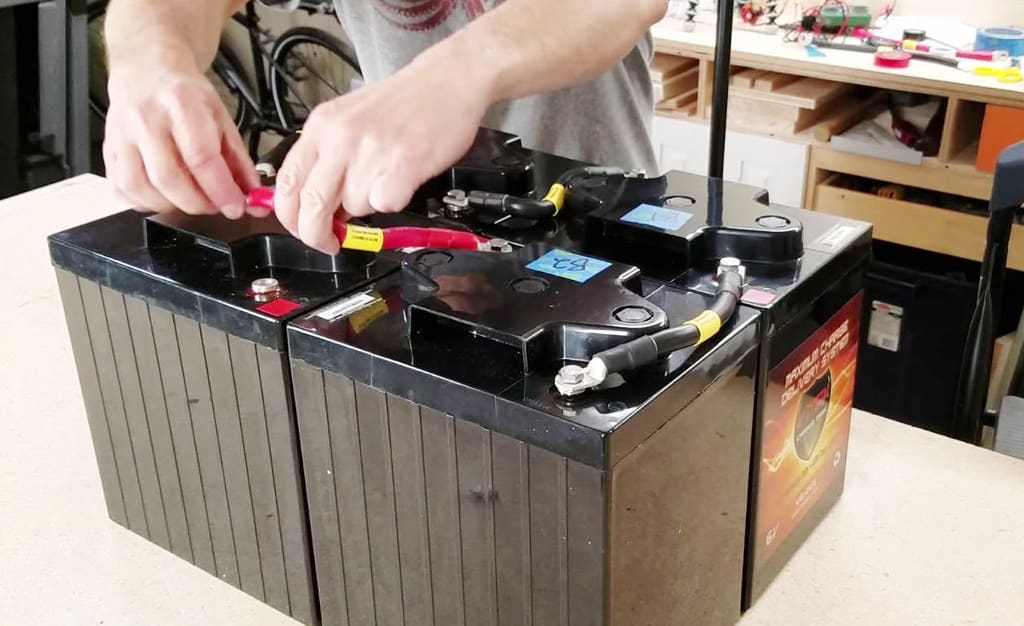
The kit includes a small PV panel, a controller and wiring, so you’ll need to buy an inverter and battery separately if you want AC power or backup power.
Best of all, the kit is super easy to install. It has pre-drilled holes and is compatible with most mounting brackets and clips.
- Great option for backup power
- Easy to install
- No official IP rating
- Low wattage
What Should Boat Owners Look for When Buying Solar Panels?
Solar panels can be a great option for marine use, but not all panels and solar kits are suitable for use around water. Additionally, the panel you choose needs to be selected based on how you want to use your solar power system.
In the sections below, we’ll include a few key things you’ll want to consider when choosing a solar module for your boat.
Energy Needs
One of the first things we recommend thinking about is how much energy you need your panels to generate. This will help guide you to what size panel and how much energy output you need.
If you’re just looking for reliable backup power for your boat’s internal 12-volt battery, or you want your panels to provide power for emergencies only, you’ll probably only need a panel of around 20 watts.
If you use your boat frequently for entertaining guests, or you spend days at a time on your boat, you might want something above 100 watts to provide backup power plus electricity for electric coolers, water heaters and more. Consider everything you’ll use your solar array for and size your system accordingly.
The chart below provides a quick breakdown of what size solar panels you need for different purposes on a boat.
If you plan on using your panels to replace an on-board generator, you can calculate how much electricity your boat uses and then size your system accordingly. It’s always advisable to go a little bigger than you think you need, as cloud coverage and the angle of the sunlight hitting your panels can cause fluctuations in solar power production.
If you have high energy needs, we also recommend considering a Maximum Power Point Tracker (MPPT) controller, which is more efficient than a Pulse Width Modulation (PWM) controller, which is more common.
Space Available for Installation
Just like residential solar systems are limited by available roof square footage, marine solar systems are limited by the available space for installation. This is an important consideration to make to ensure you don’t buy a panel that you won’t be able to mount or use in your vessel.
Before you buy any equipment, we recommend checking the measurements of the panel and deciding where on your boat you can install it. Some portable, foldable panels come with kickstands for temporary setups, but the smaller of our top picks can be set up just about anywhere without mounting brackets as well.
Type of Solar Panel
You’ll have a few choices for the type of panel you purchase for your boat as well.
First, you’ll need to decide between thin-film solar panels, polycrystalline solar panels and monocrystalline solar panels.
- Monocrystalline panels are the most efficient, so they’re the best suited for use on boats. The higher efficiency ratings will let you produce more energy per square foot, which is essential on a boat where space is limited. All of our recommendations above are monocrystalline.
- Polycrystalline solar panels can also work, but they won’t provide as much solar power.
- Thin-film panels are the most affordable, but they generate even less electricity and aren’t ideal for use where available space is minimal.
Second, you should think about whether you want a rigid solar panel with an aluminum frame or a semi-flexible one. Flexible panels contain special solar cells that can be a bit pricier, but they’re easier to install and are a bit more versatile. They can be mounted on curved surfaces, giving you more placement options.
Waterproof Rating
Since you’ll be using your panels on the water, it’s essential that you choose one with a good waterproof rating. Some of the best options are IP67 and IP65. These will ensure your panels and charge controllers or regulators remain safe and at low risk of fire even when exposed to moisture and direct water contact.
Accessories
Finally, you should consider what your kit comes with. Some come with only panels, so you’ll need to buy a controller, an inverter and a battery to complete your setup. Some come with a combination of these parts, although batteries and inverters aren’t commonly included. Some panels also include mounting brackets, although this is also uncommon.
Thinking about the additional equipment you’ll need to purchase after buying your panels will help you budget more effectively for your entire system.
How Do Solar Panels Work With Boats?
PV panels for boats work just like panels for residential use — they collect sunlight and route the energy either to a storage or use system.
Since boat solar systems are entirely off-grid, most require the following:
- Solar panels
- A charge controller
- An inverter
- Mounting brackets or other mounting hardware
- A backup battery for energy storage
We’ll explain what each of these components does in the section below, and then we’ll get into how to set up and maintain your system.
Equipment for a Marine Solar System
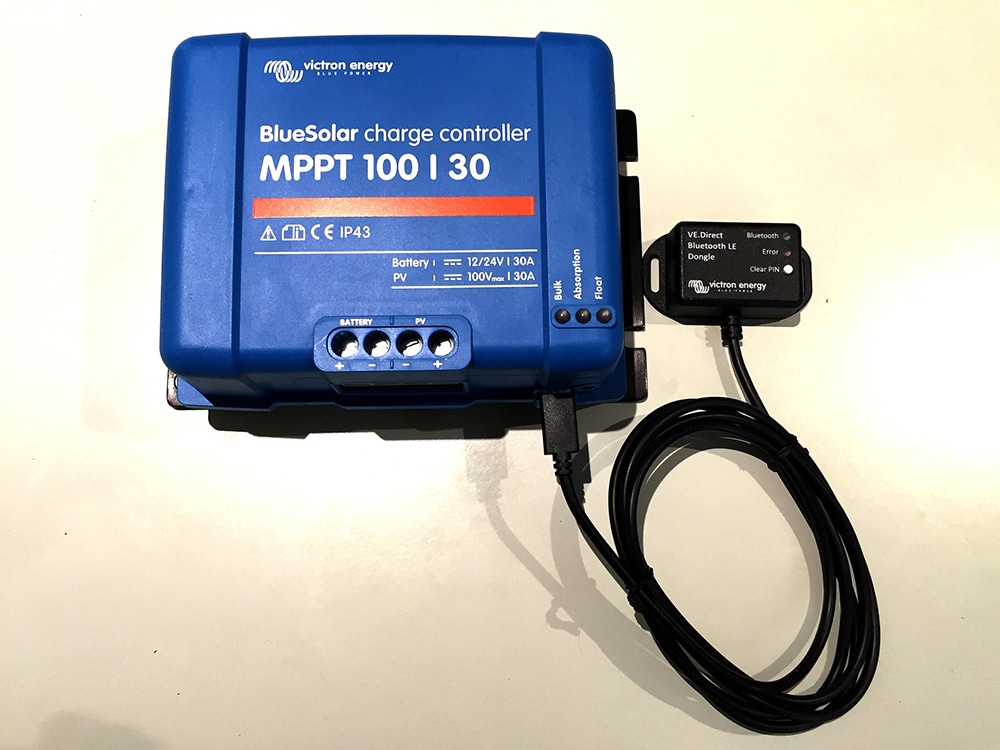
The main components you’ll absolutely need for your boat solar system are PV panels and a controller. If you plan to store energy or use it to charge common electronics, you’ll also need a battery and an inverter.
The panels are the pieces of the system that collect energy from the sun. The electricity generated is then passed to your controller, which limits the amount of power that flows through the wires to your battery or device.
The charge controller helps prevent overcharging batteries or electronics when production is high, and it also prevents battery drainage when production is low. Some panels are equipped with bypass diodes to provide the same safety features.
The solar energy that’s collected is direct current (DC), while most electronics, including standard light fixtures, use alternating current (AC) power. An inverter is used to convert DC current to AC so that you can use your solar power to power devices directly. If you don’t have DC lights in your boat, for example, an inverter might be necessary to provide lighting.
A battery storage system is exactly what it sounds like: it’s a battery bank that stores solar energy for later use.
Solar batteries are useful for two main reasons on boats.
- First, if you ever experience cloudy days, your solar production might very well drop below what you need to provide power to your devices. In that case, having a battery to pull stored energy from can be helpful in maintaining charging capability or electricity.
- Additionally, a battery on board can be useful for maintaining backup power for emergencies. If your boat’s built-in battery ever fails or you need to charge emergency communication or navigation devices, a battery will come in handy.
Installation
Since you want your solar panels to be exposed to as much sun as possible, it’s best to install them at or near the highest point on your boat — often the bimini. This will prevent them from getting shade from other parts of your boat during the day, regardless of which direction your vessel is moving.
It’s also typically best to install your panels as close to parallel with the surface of the earth as possible. Since your boat will be moving around a lot, it’s not realistic to install them facing the path of the sun in the sky as you would on a home. Laying them flat gives you the best chance of always collecting at least some sunlight.
You, of course, need to consider available space as well, so remember to take measurements of your installation site and compare them to your panels before beginning the process.
Finally, you should consider where your batteries will be — if applicable — and where your wiring will run once your installation is complete. Keeping these things in mind will help ensure that the installation process goes as smoothly as possible.
Below, we’ll include a brief step-by-step guide on how to install a solar system on your boat.
- First, take measurements of where your panels will be installed, the path the wiring will take to all components and where your battery, inverter and controller will be placed. Making sure you have enough room for all of your components will help avoid headaches once you get started.
- We recommend mounting your batteries, inverter and controller first. These are generally the easier components to mount, so they’re the easiest to move once installed.
- Next, mount your panels. The process for this will depend on the panels you choose and where you plan to install them. You should follow the installation instructions for the mounting brackets or hardware you purchase.
- Finally, you can wire your system, beginning with the connection between the panels and the controller and then the connections to the inverter and battery.
- You can test your system by using a voltmeter or by checking to see if your powered devices function as intended. Some controllers will also show you if your panels are providing energy and how much they’re producing.
For more guidance and information on how to set up your boat solar system, you can check out the video below:
Maintenance
Thankfully, solar systems are relatively maintenance-free once installed, although you should carry out routine system checks and cleaning to ensure you continue to enjoy maximum safety and energy production.
You should spray down your panels with water about once every six months to get any accumulation of dirt or salt off of them. This will help maximize energy generation. Around the same time, you should also check the wires and connectors for corrosion, which is more likely to occur if you use your boat in saltwater.
After major storms, it’s a good idea to ensure that none of the connections between components were lost. A simple disconnect could lead to your battery charging issues, which could be an issue if you ever need backup power.
Lastly, it’s worth mentioning that solar systems on boats are generally considered safe. There is a small risk of fire but provided you carry out the proper maintenance, you should avoid any serious issues.
Are Marine Solar Panels Worth It?
The answer to this question really depends on who you ask. For some boat owners, PV panels are essential. Not only can they provide backup power for emergencies, but they can also improve your quality of life at sea and the enjoyment of your boat.
For many people, these things are indispensable, so solar systems are well worth the investment. For certain types of boats — like small fishing boats and sailboats — solar panels will be the only source of electricity.
Other boat owners feel comfortable relying on generators if they have them, and some use their boats only for short durations, which makes having an on-board solar array less valuable.
For most people, though, having at least a small solar system to provide backup power for emergencies is worthwhile. From there, opting to up the size of your system to improve your time at sea isn’t hard to get behind.
FAQ: Marine Solar Panels
Below, we’ll answer a few of the most common questions we get about solar panel systems made for boats.
What are the best marine solar panels?
In our opinion, the best solar panels for boat use are the SunPower 170W solar panels. These are flexible panels that allow for easy and versatile installation.
They are some of the most efficient panels suitable for boat use, and they provide an incredible 170 watts each. This is enough power for just about anything you need electricity for on your boat and for emergency equipment in low-light conditions.
These panels are a bit expensive, and they don’t come with any additional equipment. However, the junction boxes have a waterproof rating of IP67, come with a five-year warranty for equipment and high efficiency and are made from high-quality, durable materials for years of use.
Will solar panels keep my boat battery charged?
Yes, solar panels can be hooked up to keep your boat’s 12 volt battery charged. However, you need to make sure you install a system that is sized appropriately for your boat’s needs.
You can check how much power your boat draws from its battery system by looking at the loads (in amps or watts) of each device. You can also use your battery monitor if you have one to check the energy demand of each individual component pulling power. Then, choose solar panels that produce a bit more energy than your system needs.
If you live in an area that experiences a lot of cloudy weather, you might want to size up your system even more to ensure your system generates enough electricity.
How much does it cost to put solar panels on a boat?
The cost to install a solar array on your boat can range from around $150 up to well over $1,000. Where in this range your total falls depends primarily on how much energy you need to produce.
If you’re looking for portable solar panels to take on and off a small boat with you for emergency use only — which is typical for sailboats and smaller boats that don’t normally have electricity — you’ll likely be looking at the $150 end of the spectrum.
If you have a much larger boat and want to be able to maintain power for your essential equipment and some non-essentials, then you’ll likely push your all-in cost closer to the higher end of the range.
What are the benefits of solar panels on boats?
Installing solar panels on your boat can provide quite a few key benefits, although the perks you’ll actually experience depend on your situation and your specific boat.
Perhaps most importantly, solar panels can charge your boat’s battery and maintain electricity for emergencies. Most systems — even small ones — can serve to charge your phone, GPS or other emergency devices in case you run into problems out on the water.
Larger systems can also provide power for recreational use, like charging phones, powering speaker systems, keeping beer cold and more.

Related articles
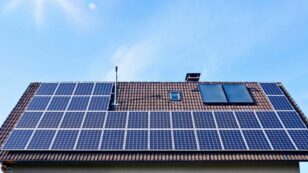
Calculate Your Solar Panel Payback Period (How Long To Recoup Costs?)

Solar Panel Cost In 2024 (Homeowner’s Installation Savings Guide)
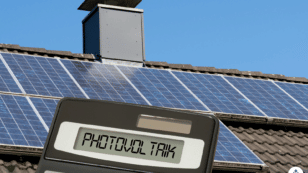
Solar Calculator
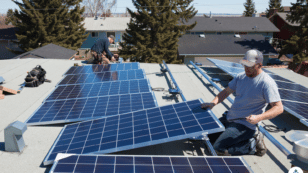
Top 6 Best Solar Companies Review
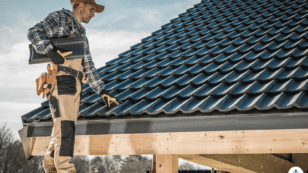
Solar Roof Shingles 2024 Cost and Buying Guide
Related Solar Panel Guides
- Buyer’s Guide: Best Solar Panels for Camping (2022)
- 7 Best Solar Panels for Mobile Homes (2022 Guide)
- What Are the Best Solar Panels for Farming Solar for Agriculture Guide (2022)
- The Best Solar Panels for Portable Solar Generators
- 5 Best Flexible Solar Panels (2022 Reviews and Buyer’s Guide)
Comparing authorized solar partners
Having trouble deciding? Click below and use our process to receive multiple quotes instead:
You are using an outdated browser. Please upgrade your browser or activate Google Chrome Frame to improve your experience.
- Commercial & industrial PV
- Grids & integration
- Residential PV
- Utility scale PV
- Energy storage
- Balance of systems
- Modules & upstream manufacturing
- Opinion & analysis
- Opinion & analysis guidelines
- Press Releases
- Technology and R&D
- Sustainability
- 50 States of Solar
- pv magazine UP initiative
- pv magazine Hydrogen Hub
- Magazine features
- US module maker directory
- pv magazine Roundtables & Insights
- pv magazine Webinars
- Event calendar
- Past events
- Special Edition Las Vegas 2023
- OMCO Solar white paper
- Print archive
- pv magazine test
- pv magazine team
- Newsletter subscription
- Magazine subscription
- Community standards
This yacht sets sail with solar
The 60 square meters of solar panels produces 30-50 kWh of energy per day, enough to power all of the onboard electronic equipment for around seven hours.
- Commercial & Industrial PV
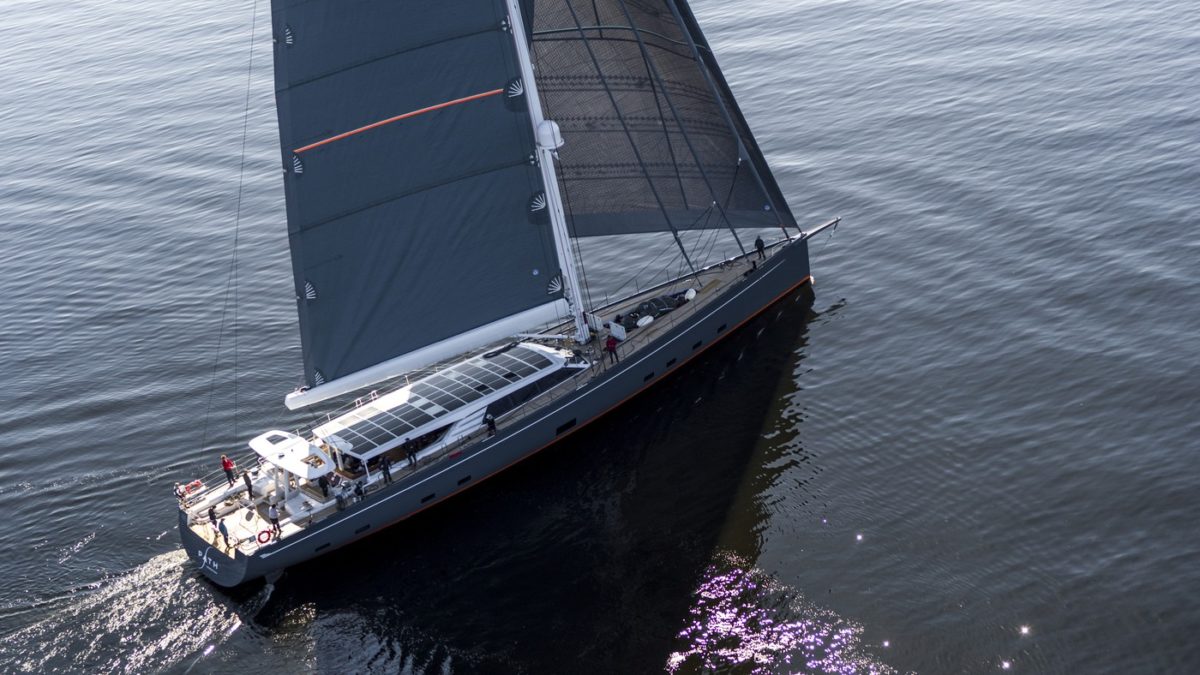
Solar-powered Baltic yacht.
Image: Solbian Solar
Baltic Yachts began delivery in July of its Baltic 146 Path, which includes an 8,714 watt solar rooftop and energy storage system designed by Solbian Solar using the company’s walkable solar modules.
Recently, some of the yacht’s technical work has been shared online. Built from 1,742 monocrystalline solar cells, many of the 86 solar panels were custom cut to fit the deck’s shape by the Solibian team in Italy. The units were based on the company’s Super Rugged (SR) Series .
The SR series has solar cell busbar technology developed by Merlin Solar. In one video, the Merlin team drives over the solar panel, throws bags of cement on it, and even shoots it with a bow and arrow in an effort to prove the product’s resilience. The company said its busbar technology makes this kind of abuse possible.
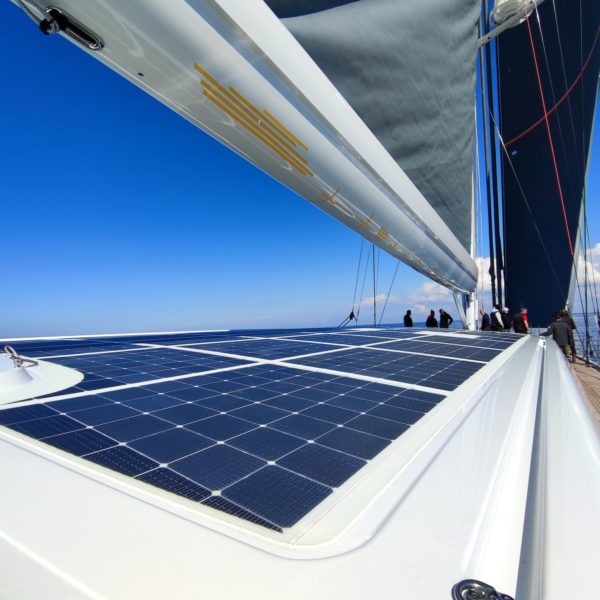
The 60 square meters of solar panels produces 30-50 kWh of energy per day. The company said that’s enough to power all of the onboard electronic equipment–including navigation, autopilot, lighting, and entertainment–for around seven hours.
Once the sun goes down, a Mastervolt MLI 44kWh LiFePO4 battery pack allows the diesel generator mostly to stay off, providing generally silent operation for 14-18 hours.
Baltic Yacht’s solar system is roughly half the size of the Silent 60’s 16.8 kWdc solar plus storage system. The Silent 60 is a solar-propelled yacht less than half the lengthBaltic yacht and price, which reaches 6-8 knots on solar power alone. The Path does not feature electric propulsion and therefore relies on diesel engines when the wind dies down.
Since the Path uses a sail for propulsion, the team installed 154 bypass diodes and 12 solar panel strings and trackers – Mastervolt SCM-60 MPPTS – in an effort to maximize power output and minimize the effect of the sail’s shadows on the panels. The entire solar system, including wiring, controllers and small parts, weighs less than 300kg, the company said
The 146 Path has an overall length of 146 feet. The yacht can accommodate eight in addition to the ship’s owner, as well as eight crew members. Path carries two tenders, an 8hp Torqeedo electric outboard-powered RIB, and a 6.5m twin-engined RibEye. There are also two ultra-lightweight Reverso Match sailing dinghies.
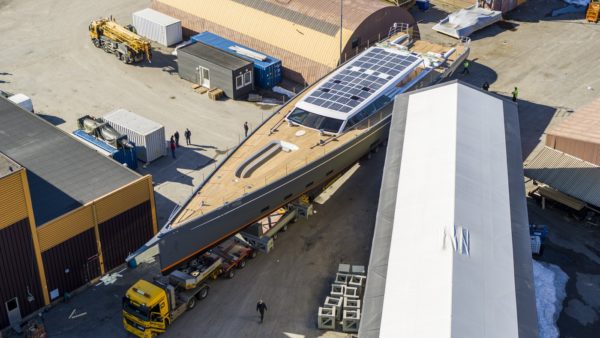
When the front tender is deployed, its storage container can be turned into a pool.
The ship’s main diesel engine is a 405kW (550hp), six-cylinder Scania. The specific model isn’t listed, however the “ DI13 092M IMO Tier III, EU Stage IIIA ” lines up with all of the stats and looks like the unit in a video of the engine being installed.
The owner’s suite includes a sleeping cabin, and an en suite lounge with a glass divider doubling as a movie, tv, and sailing information screen. An upper lounge features a 2.7m-long video wall.
This content is protected by copyright and may not be reused. If you want to cooperate with us and would like to reuse some of our content, please contact: editors@pv-magazine.com .
John Fitzgerald Weaver

More articles from John Fitzgerald Weaver
People on the Move: ACORE, Sunnova Energy, Lighthouse bp, and more
Sandia offers public access to csp archives, related content, elsewhere on pv magazine....
Since it is E propulsion all they have to do to change while sailing is use the motor in regen it’ll generate power back into the pack at much larger amounts. And a small RE fueled generator just in case. As a sailor who does solar, not a chance it’ll get that much from the solar from all the shading from the rigging. More likely 10-30kwh/day. On mine, I made the sails small with 2 masts so I can lower them to not shade the panels.
Any photos of your boat you can share?
Leave a Reply Cancel reply
Please be mindful of our community standards .
Your email address will not be published. Required fields are marked *
Save my name, email, and website in this browser for the next time I comment.
Notify me of follow-up comments by email.
Notify me of new posts by email.
By submitting this form you agree to pv magazine using your data for the purposes of publishing your comment.
Your personal data will only be disclosed or otherwise transmitted to third parties for the purposes of spam filtering or if this is necessary for technical maintenance of the website. Any other transfer to third parties will not take place unless this is justified on the basis of applicable data protection regulations or if pv magazine is legally obliged to do so.
You may revoke this consent at any time with effect for the future, in which case your personal data will be deleted immediately. Otherwise, your data will be deleted if pv magazine has processed your request or the purpose of data storage is fulfilled.
Further information on data privacy can be found in our Data Protection Policy .
pv magazine USA offers daily updates of the latest photovoltaics news. We also offer comprehensive global coverage of the most important solar markets worldwide. Select one or more editions for targeted, up to date information delivered straight to your inbox.
- Select Edition(s) * Hold Ctrl or Cmd to select multiple editions. Tap to select multiple editions. U.S. (English, daily) Global (English, daily) Germany (German, daily) Australia (English, daily) China (Chinese, weekly) India (English, daily) Latin America (Spanish, daily) Brazil (Portuguese, daily) Mexico (Spanish, daily) Spain (Spanish, daily) France (French, daily) Italy (Italian, daily)
- Read our Data Protection Policy .
Subscribe to our global magazine

Most popular
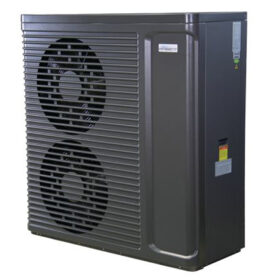
Keep up to date
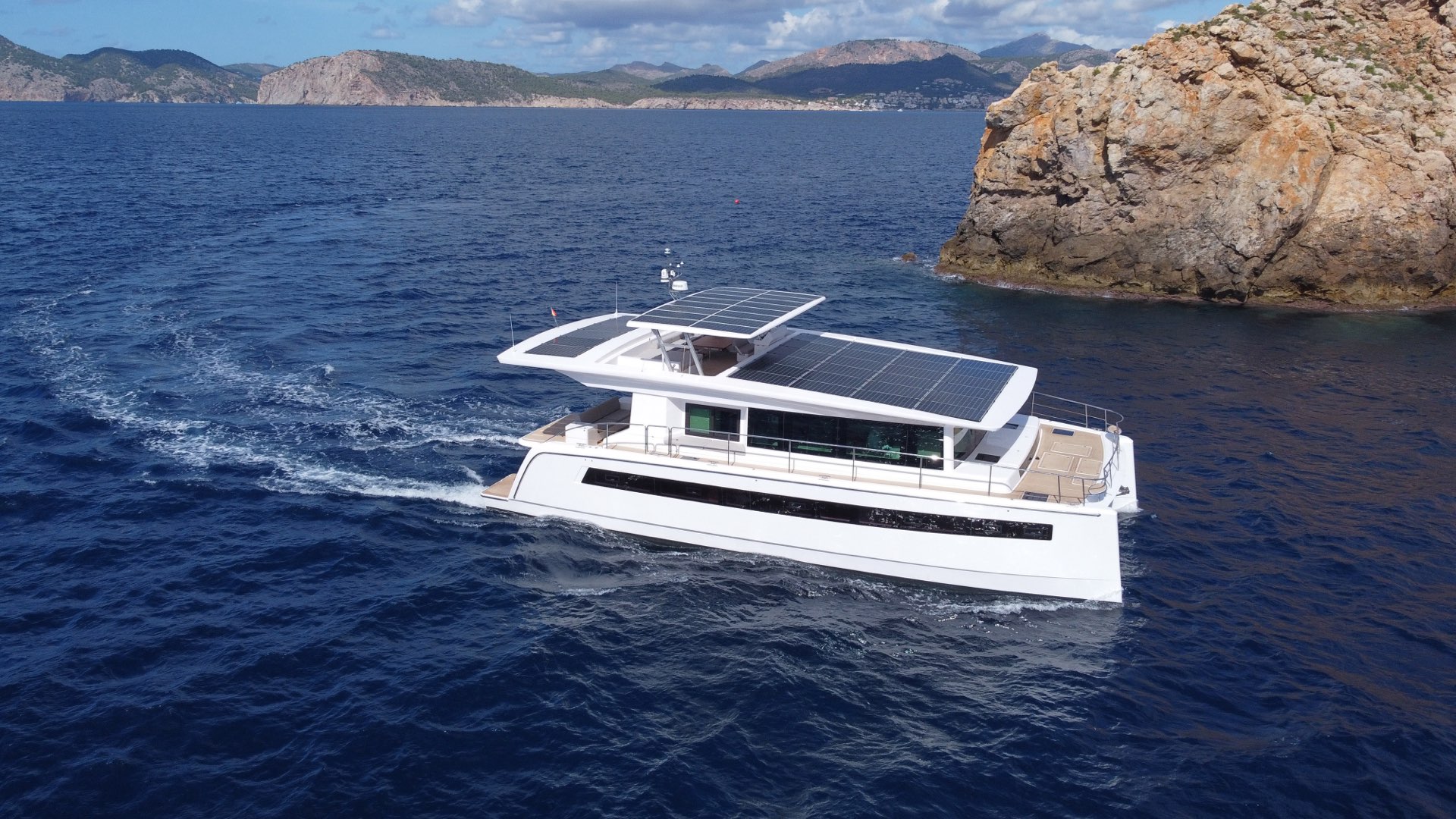
Silent Yachts
Creators of the world’s first series produced, solar-powered electric yachts.
Unlimited Range
Noiseless cruising, zero emission, minimal maintenance, pioneering solar powered yachting since 2009.
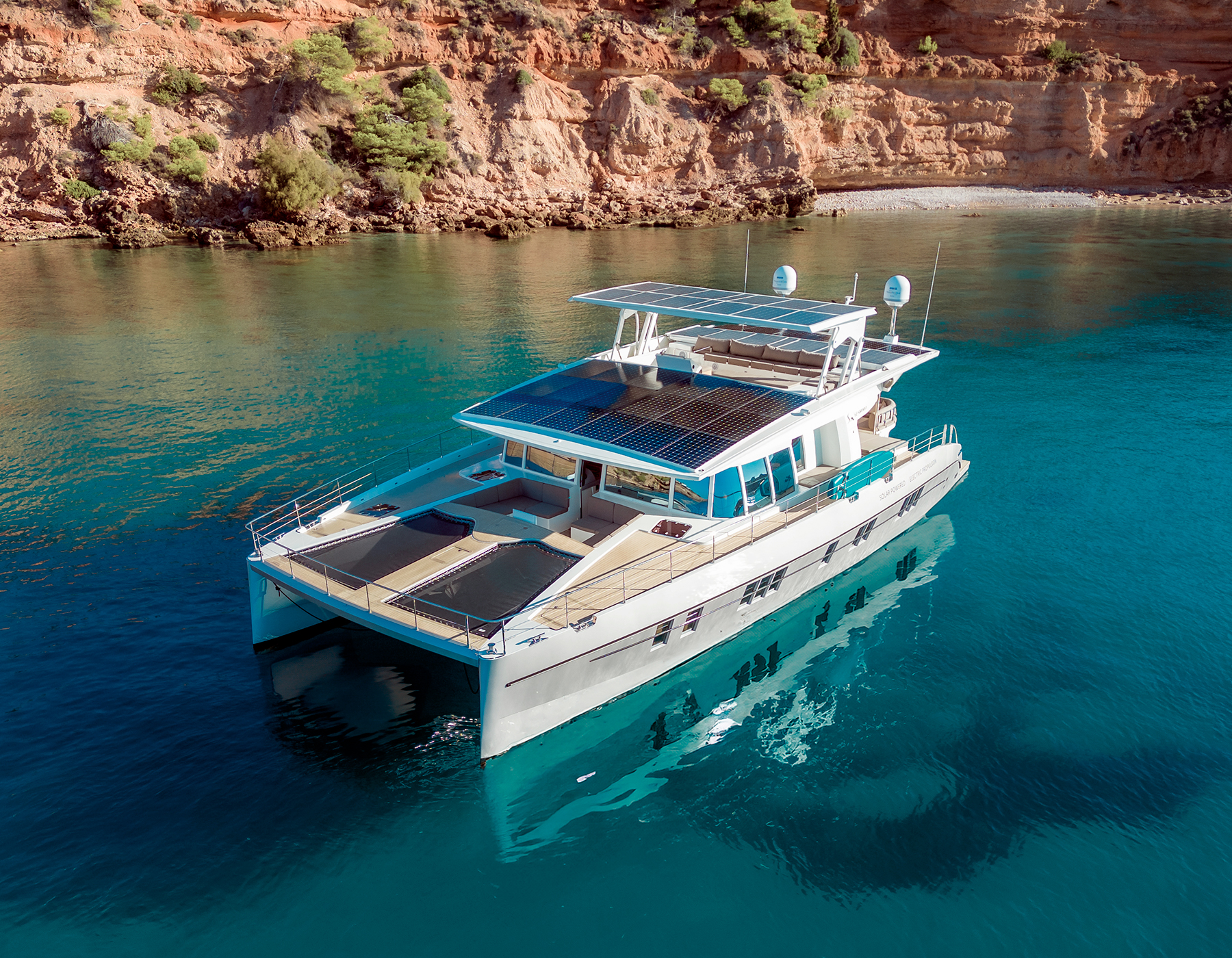
The Original Solar Yacht
As the original inventors of series produced solar-electric yachts, we pioneered this innovative approach. Our first model, the Silent 64, was launched to the market in 2016, several years before any other shipyard considered the possibility of going electric.
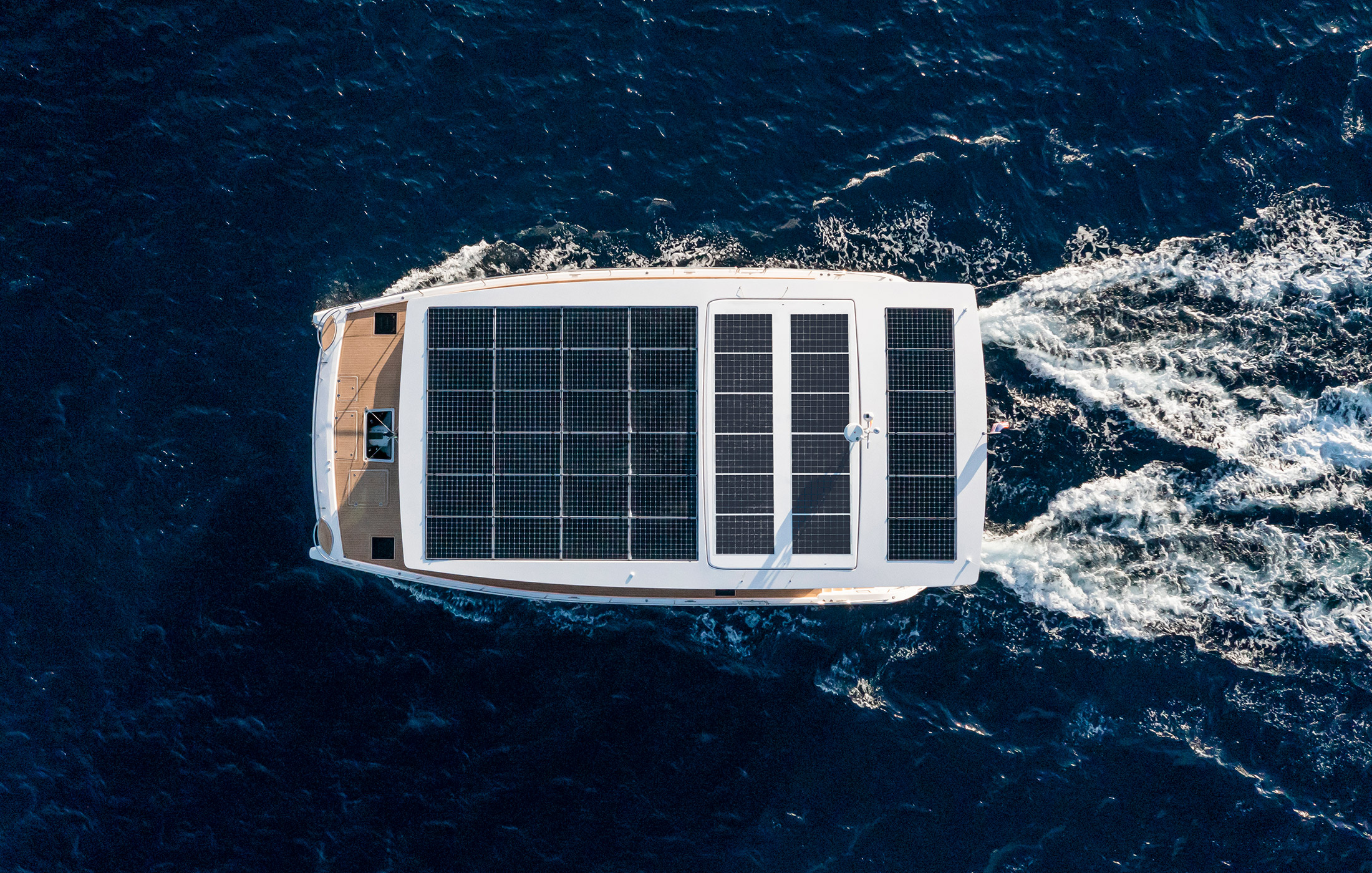
Leading Technology
Our founders began to research alternative energy sources to power yachts during the mid 1990s. Today, the technology of our in-house developed solar-electric drivetrain has been perfected and is multiple generations ahead in terms of reliability, performance and efficiency.
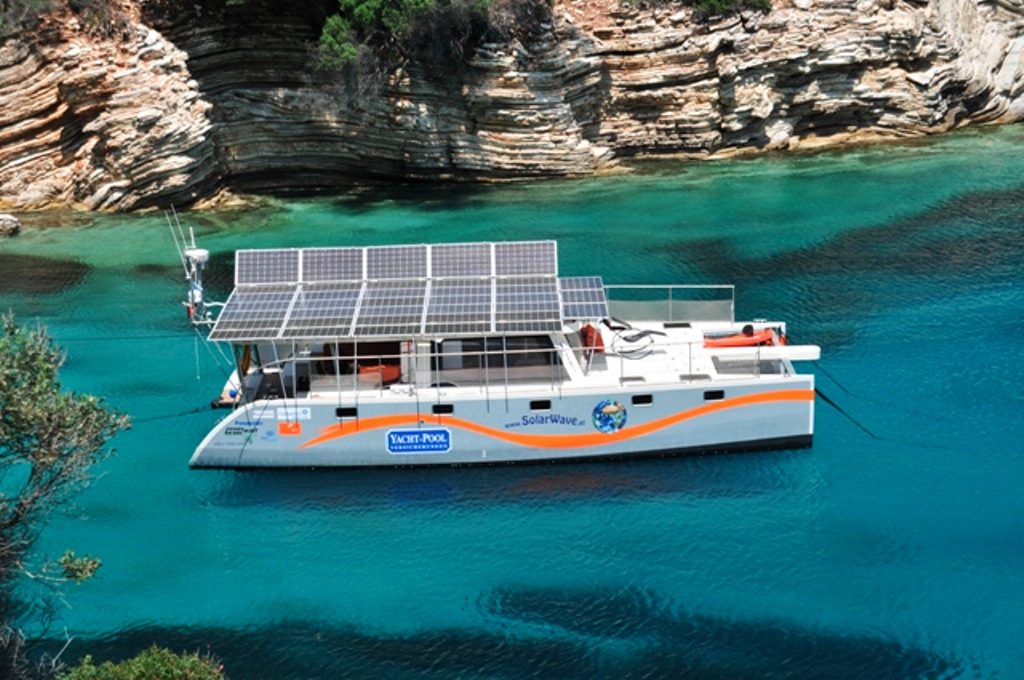
Historical Track-Record
In 2009, the Solarwave 46 was launched as our first prototype of a fully solar-electric, self-sufficient ocean-going catamaran. Since then, our electric yachts have cruised many 10.000s of nautical miles, performing flawlessly during a variety of weather conditions.
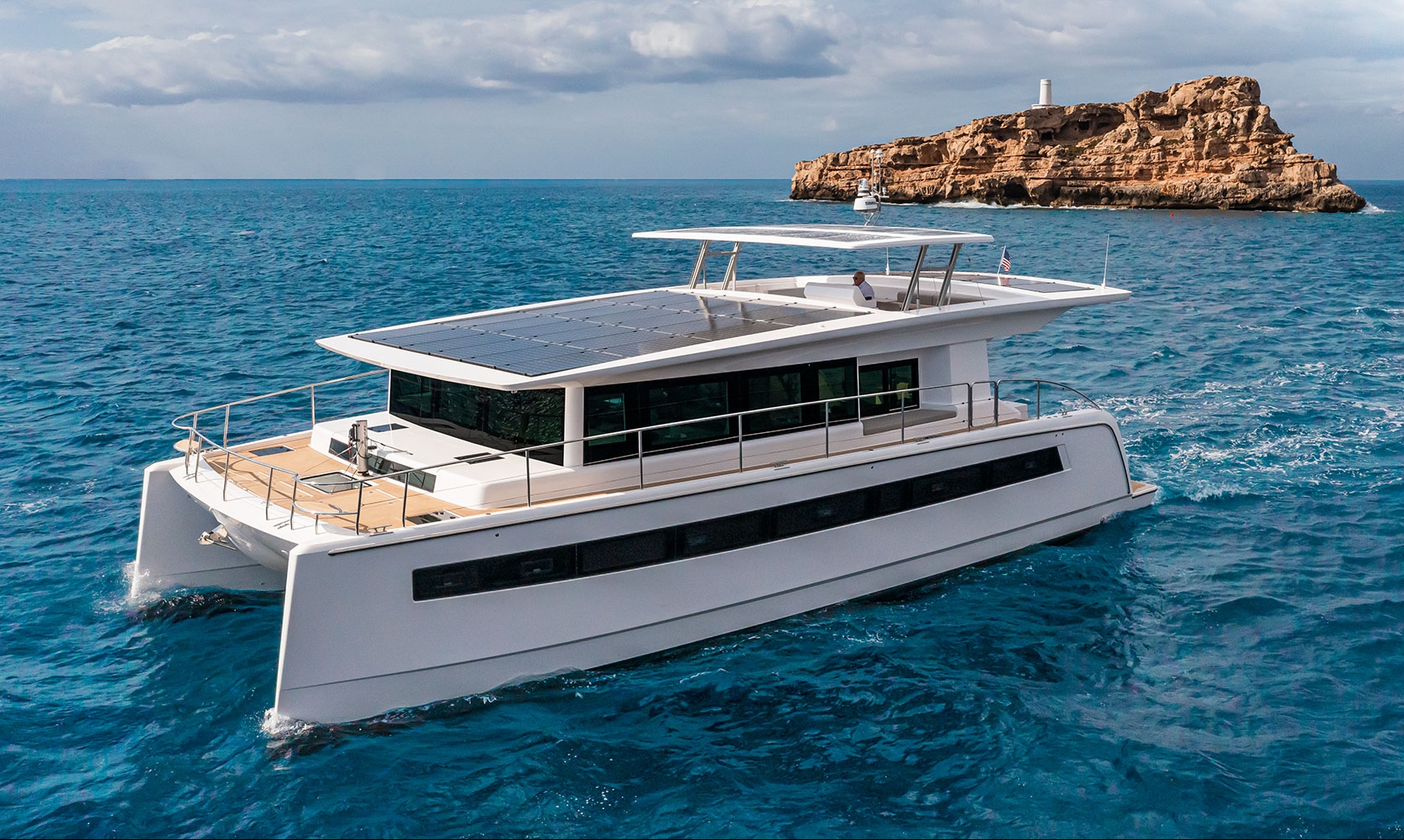
Enabling Self-Sufficiency
What differentiates a Silent is the unprecedented level of autonomy provided by our yachts. Being able to produce your own energy enables a fully self-sufficient lifestyle on board. Travel the oceans sustainably while making them your infinite playground.
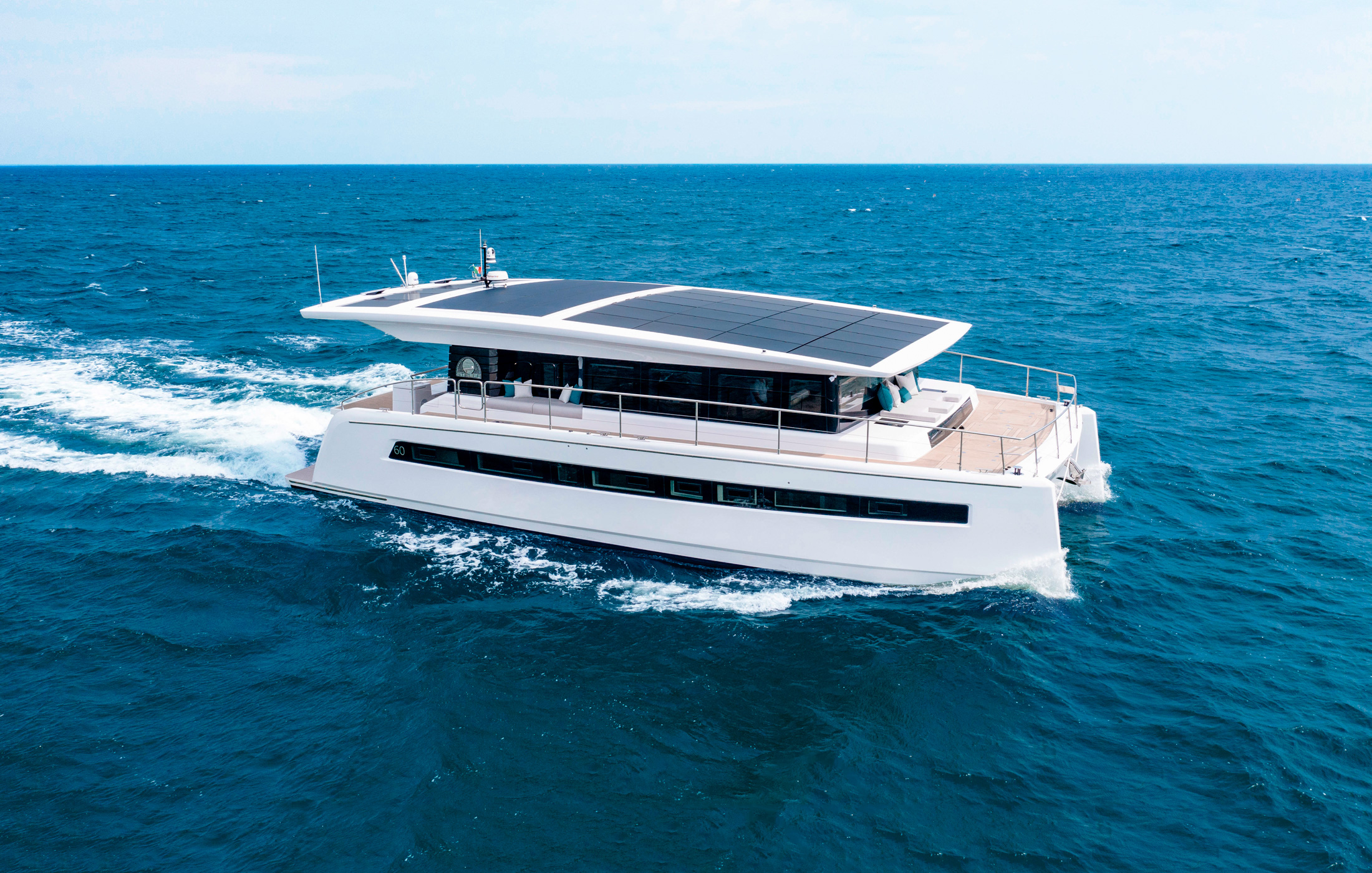
The award-winning entry to solar-electric yachts.
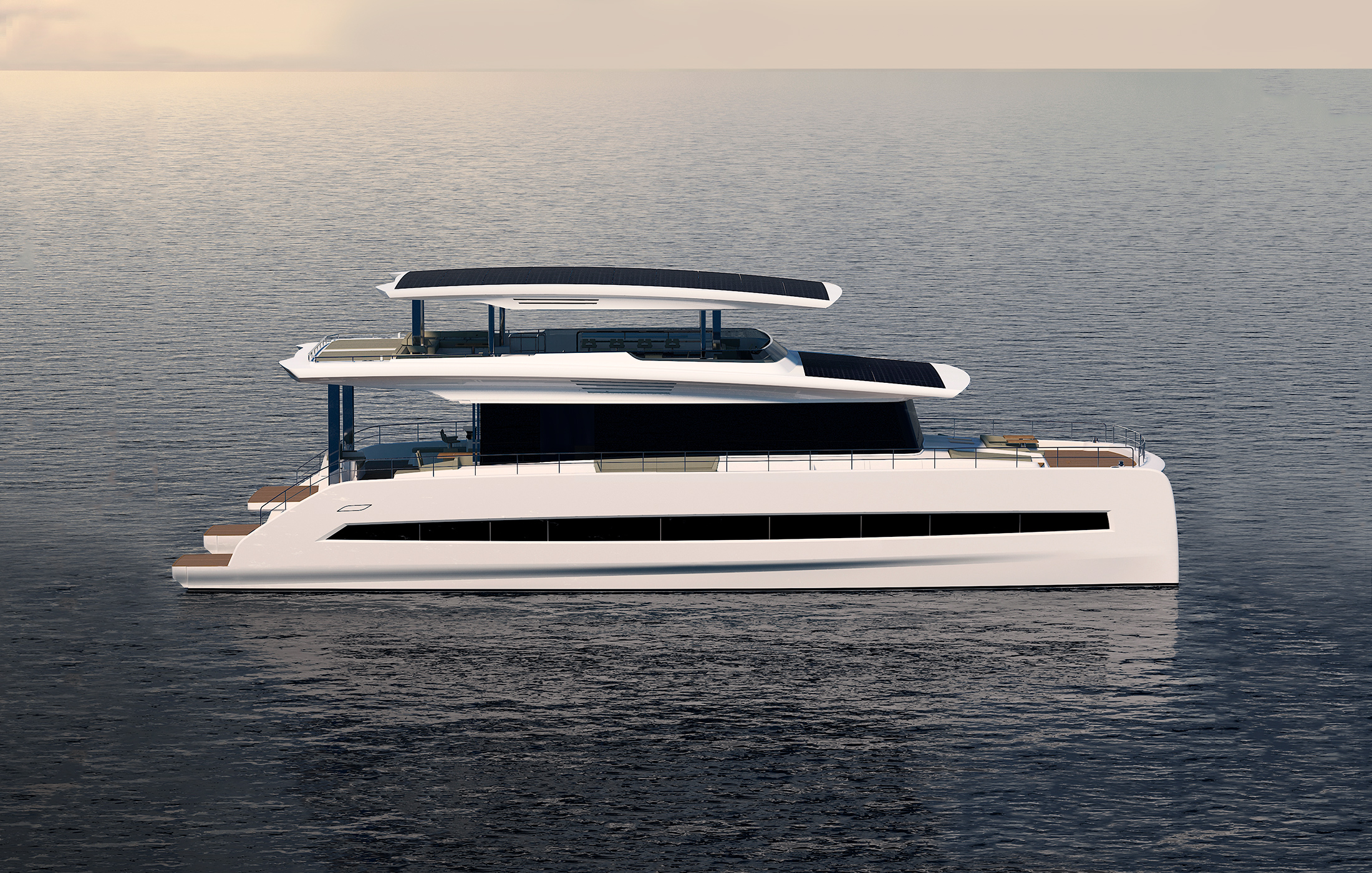
Timeless design meets state-of-the-art technology.
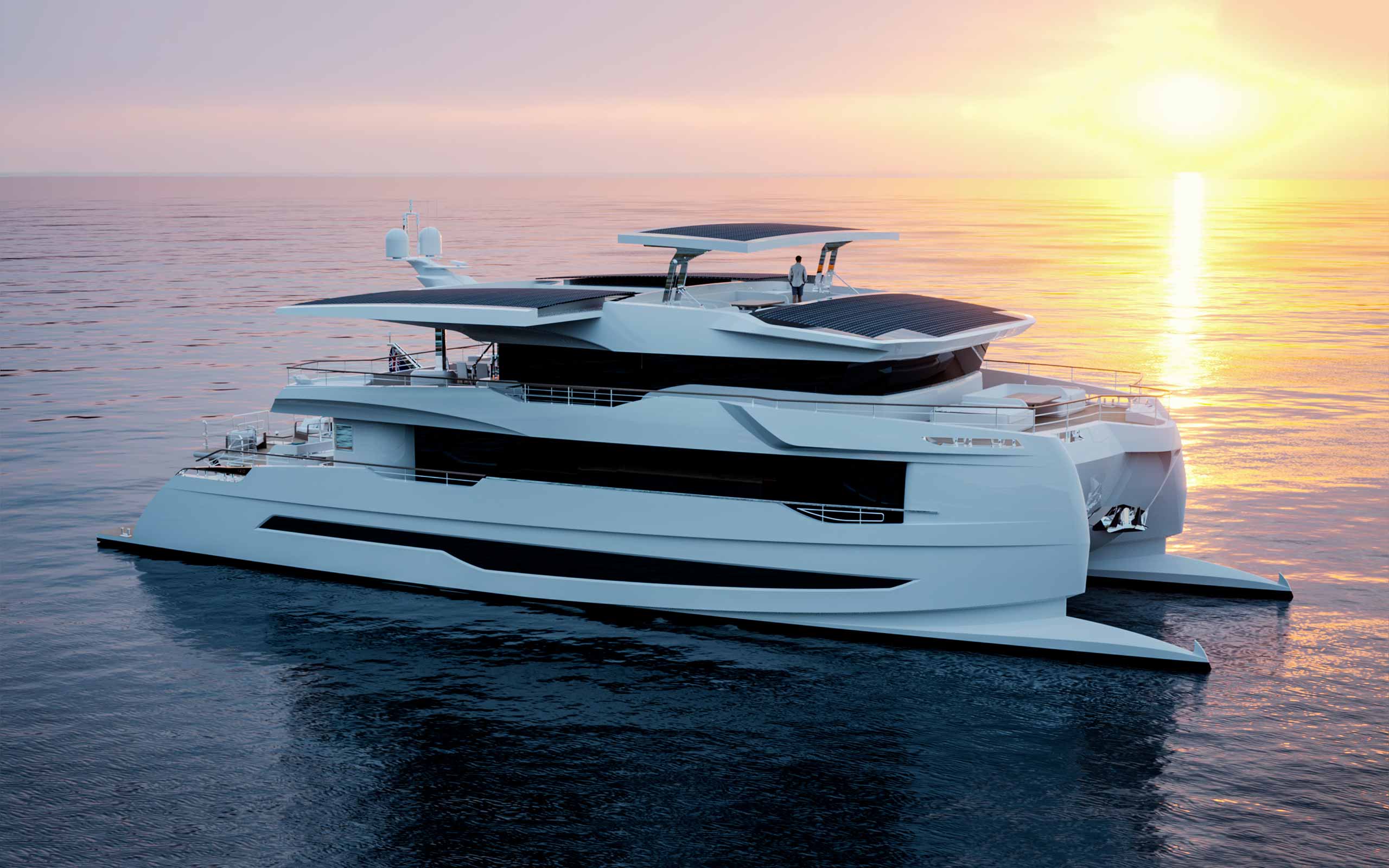
120 Explorer
The boldest expression of solar powered yachting yet.
What Makes Us Unique
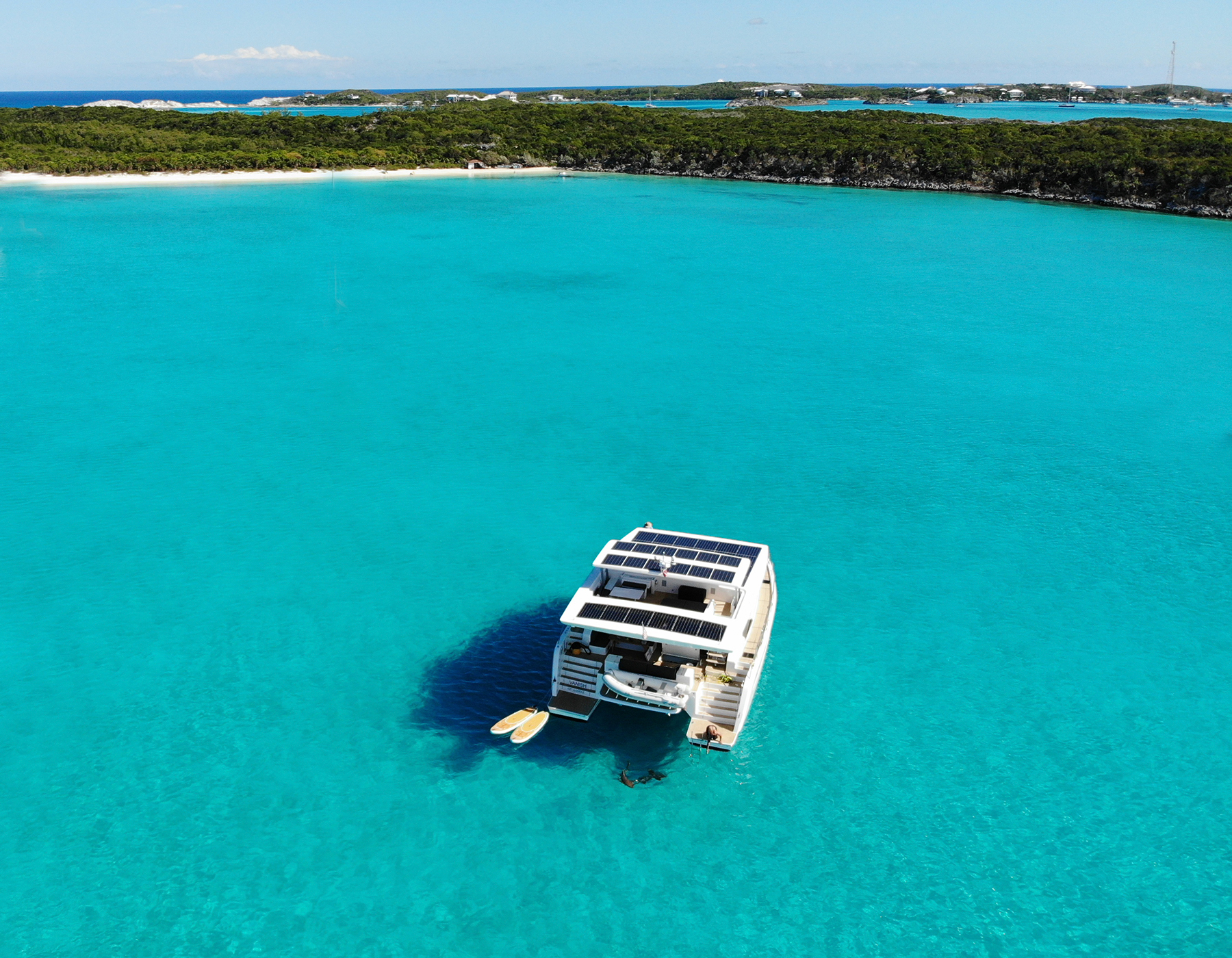
The tranquility on board of our yachts is unique. A lack of noise, fumes and vibrations create a deep connection with the sea. Luxury and sustainability finally merged into a holistic experience, working hand in hand with nature by minimizing the impact on the marine environment without compromising comfort.
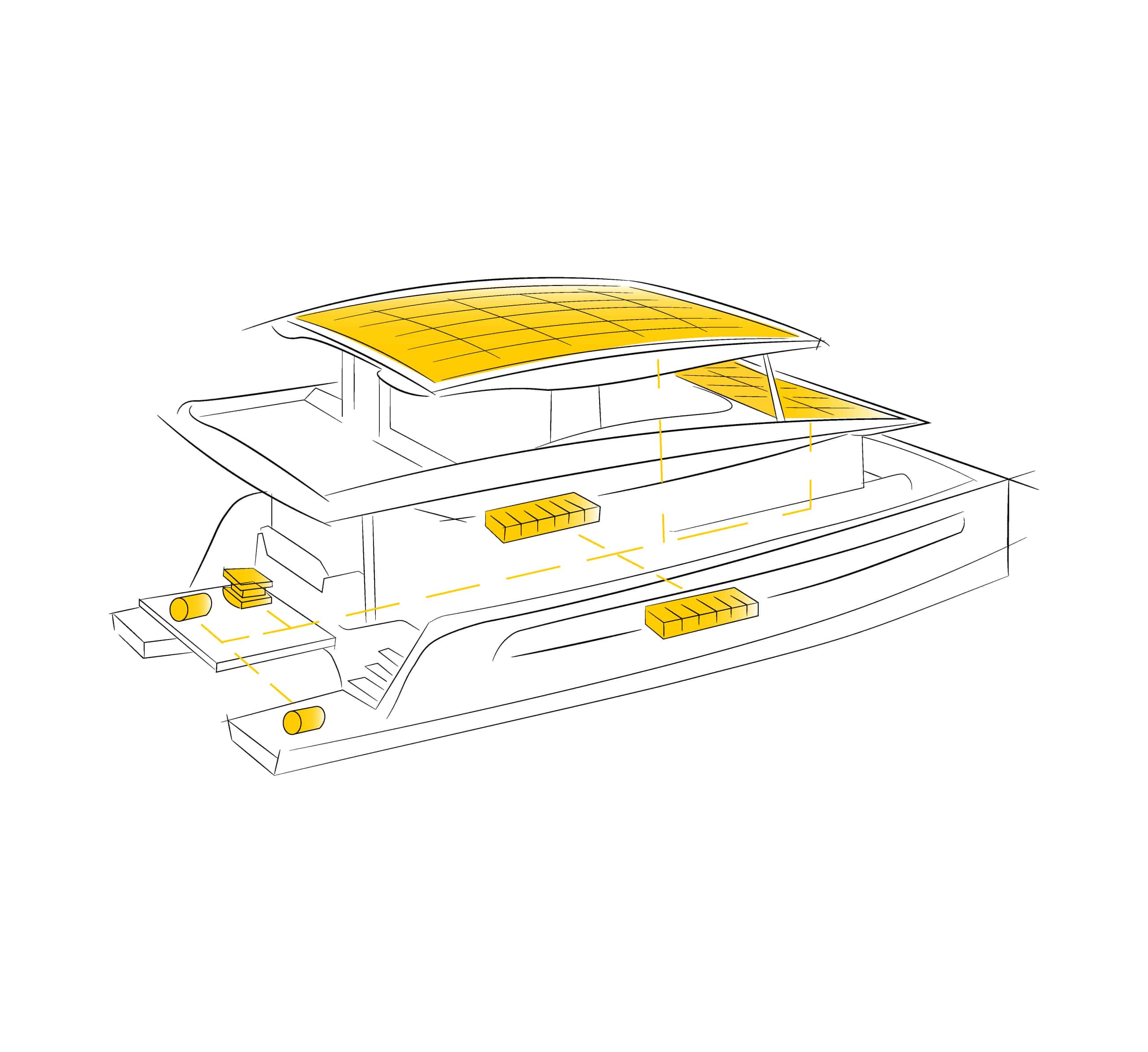
For optimal performance and efficiency, our solar-electric drivetrain integrates seamlessly with all onboard systems. Compared to fossil fuelled powertrains of motoryachts, electric powertrains have very few moving parts, resulting in minimal maintenance, maximum reliability and significantly lower running costs.
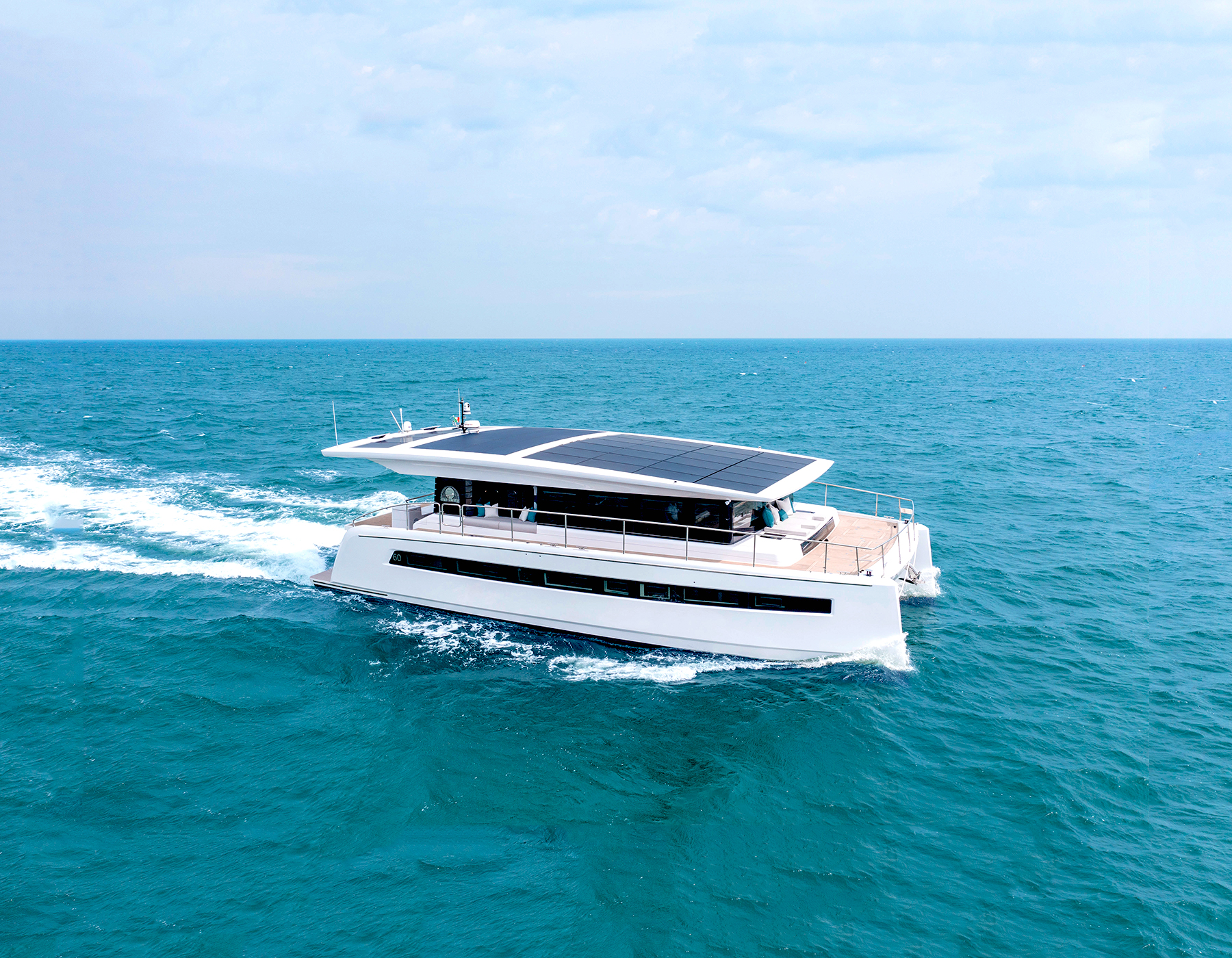
The ability to recharge your own batteries with the sun marks a new era of freedom. Depending on cruising speeds and weather conditions, a Silent has virtually unlimited range, enabling you to live a fully self-sufficient lifestyle on board. Unbound by the limitations of fossil fuels, you are free to explore the horizons.
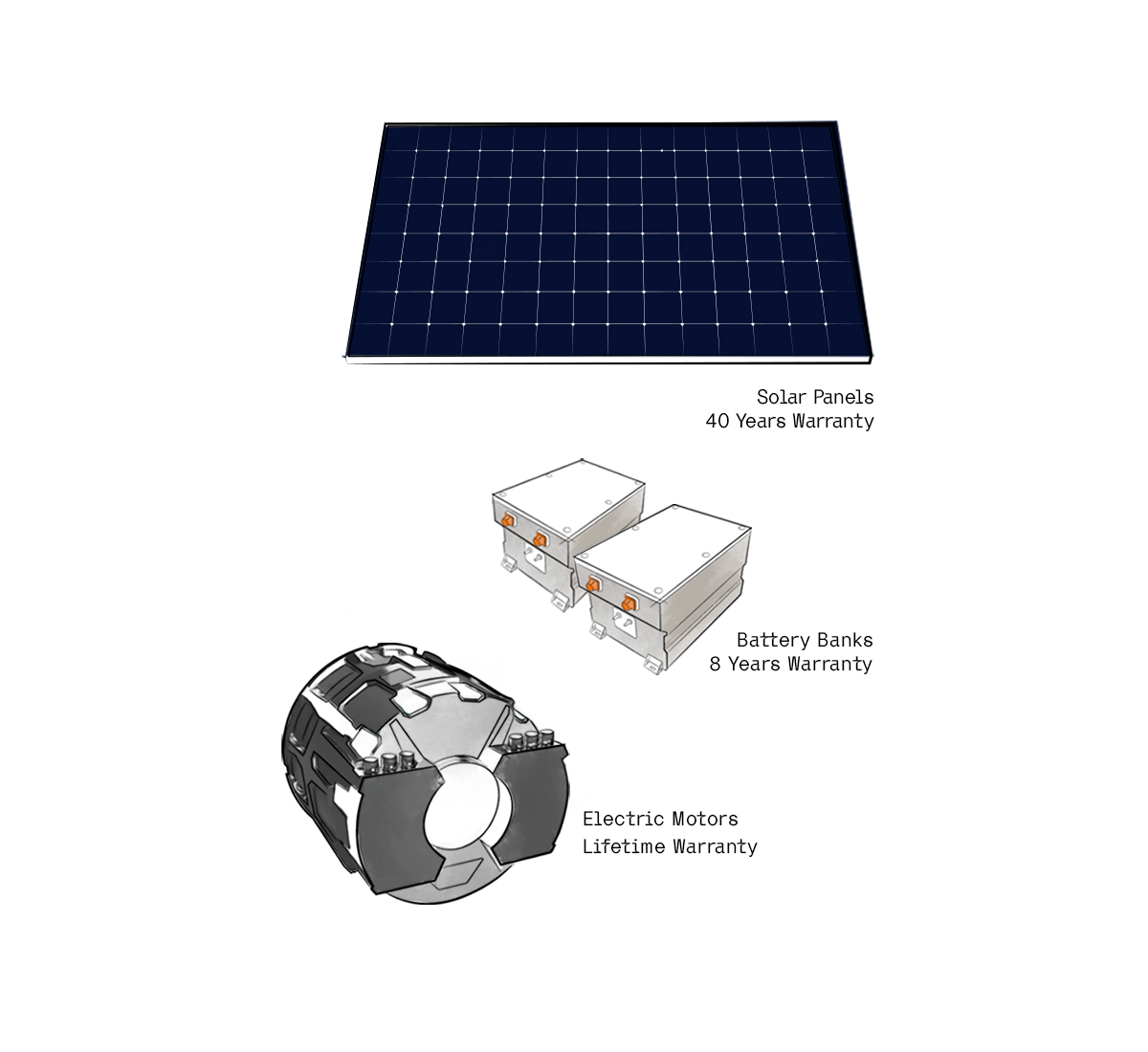
The technology powering our yachts today has been pioneered by our founders almost three decades ago. Continuous upgrading and steady optimization of the entire system are some of the key reasons our in-house developed solar-electric drivetrain offers a comprehensive portfolio of assurances and warranties.
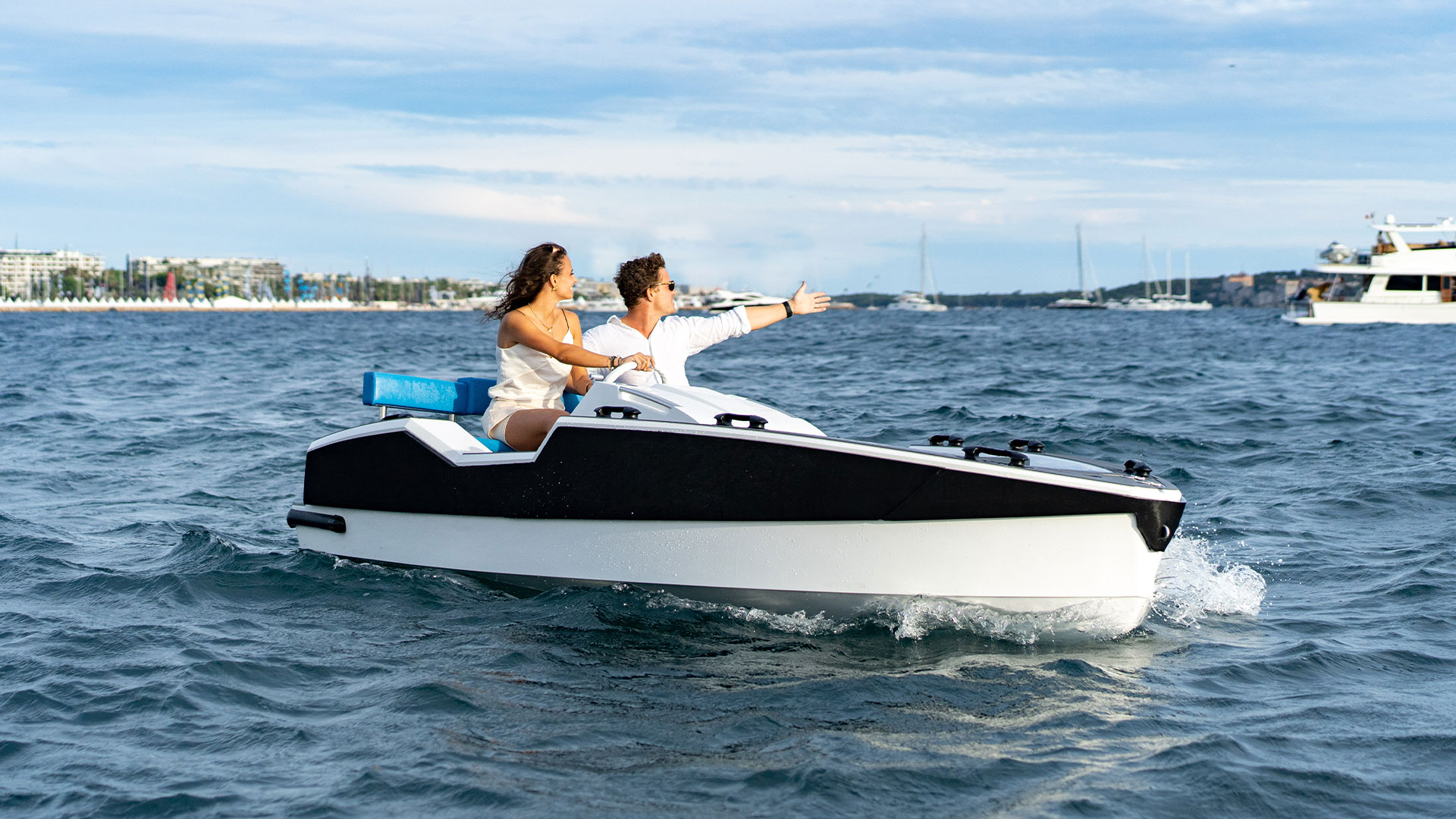
Powered by an advanced jet propulsion system, the fully electric Tender Series perfectly complements the experience on board of our catamarans. Following the same philosophy as our electric yachts, it was developed with a strong focus on being spacious, lightweight and efficient.
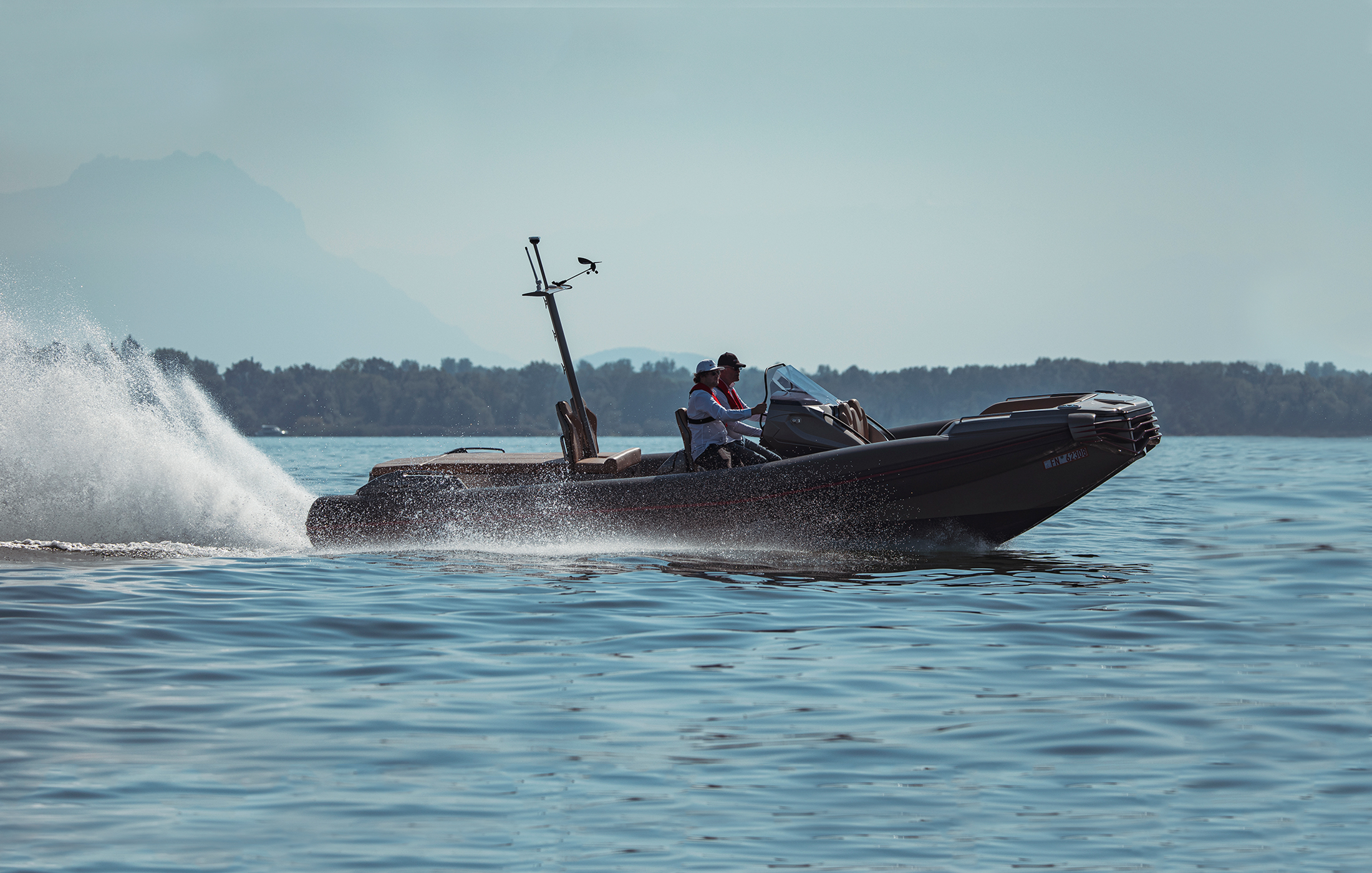
As a new breed of Silent, the Speed 28 combines futuristic design with blistering pace. Her high-performance drivetrain is supported by triple foils and embedded solar cells on the hardtop. Advanced hydrodynamics and latest AI management make for a stable ride which always remains comfortable.
Why Silent Yachts
A sensible approach to yachting which works in self-sufficient harmony with nature and creates a completely new experience on board.
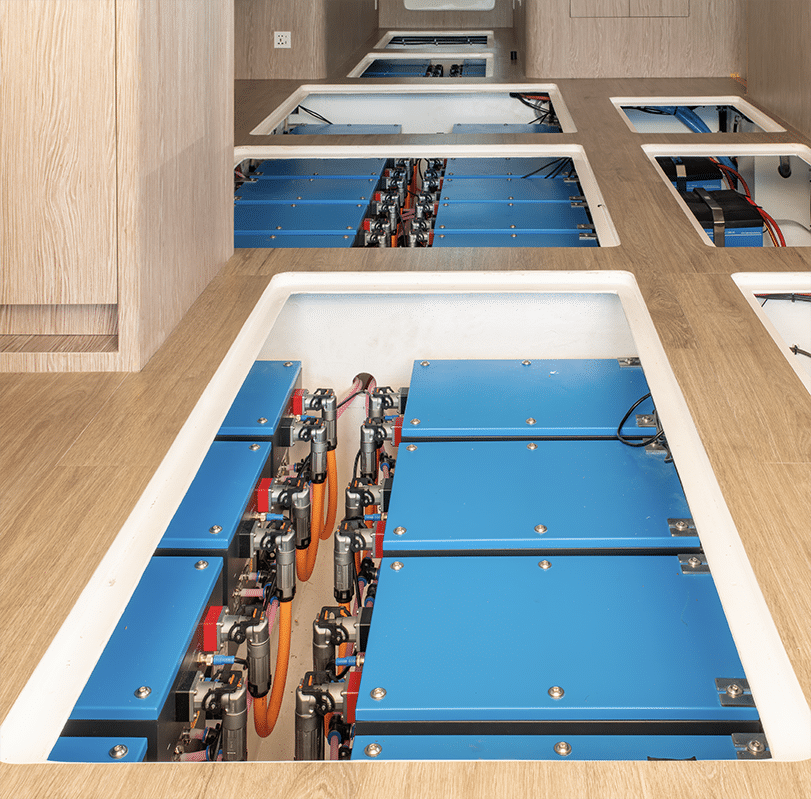
New Silent Drivetrain

Tech shorts 2023
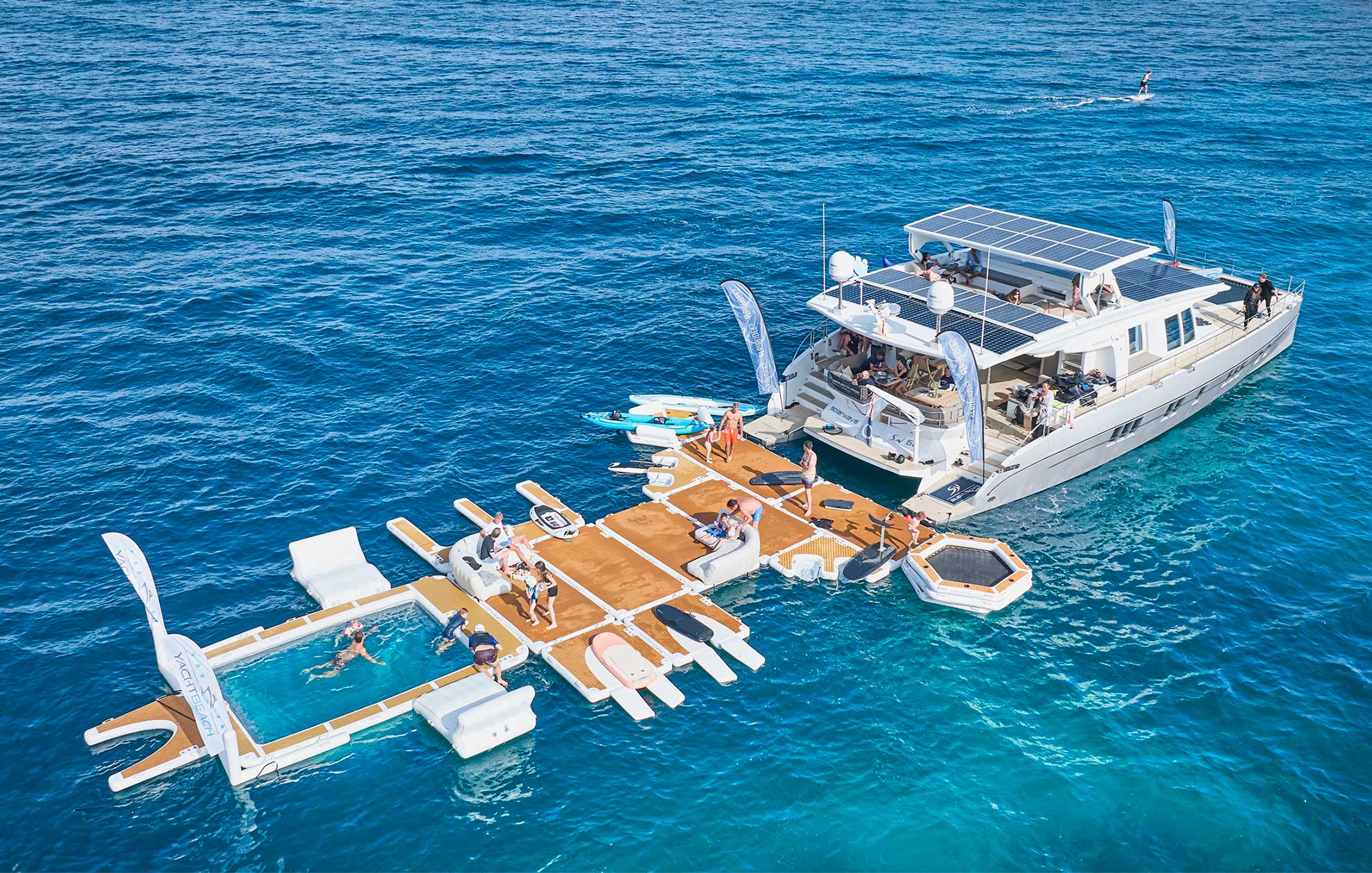
Electric power event on the water
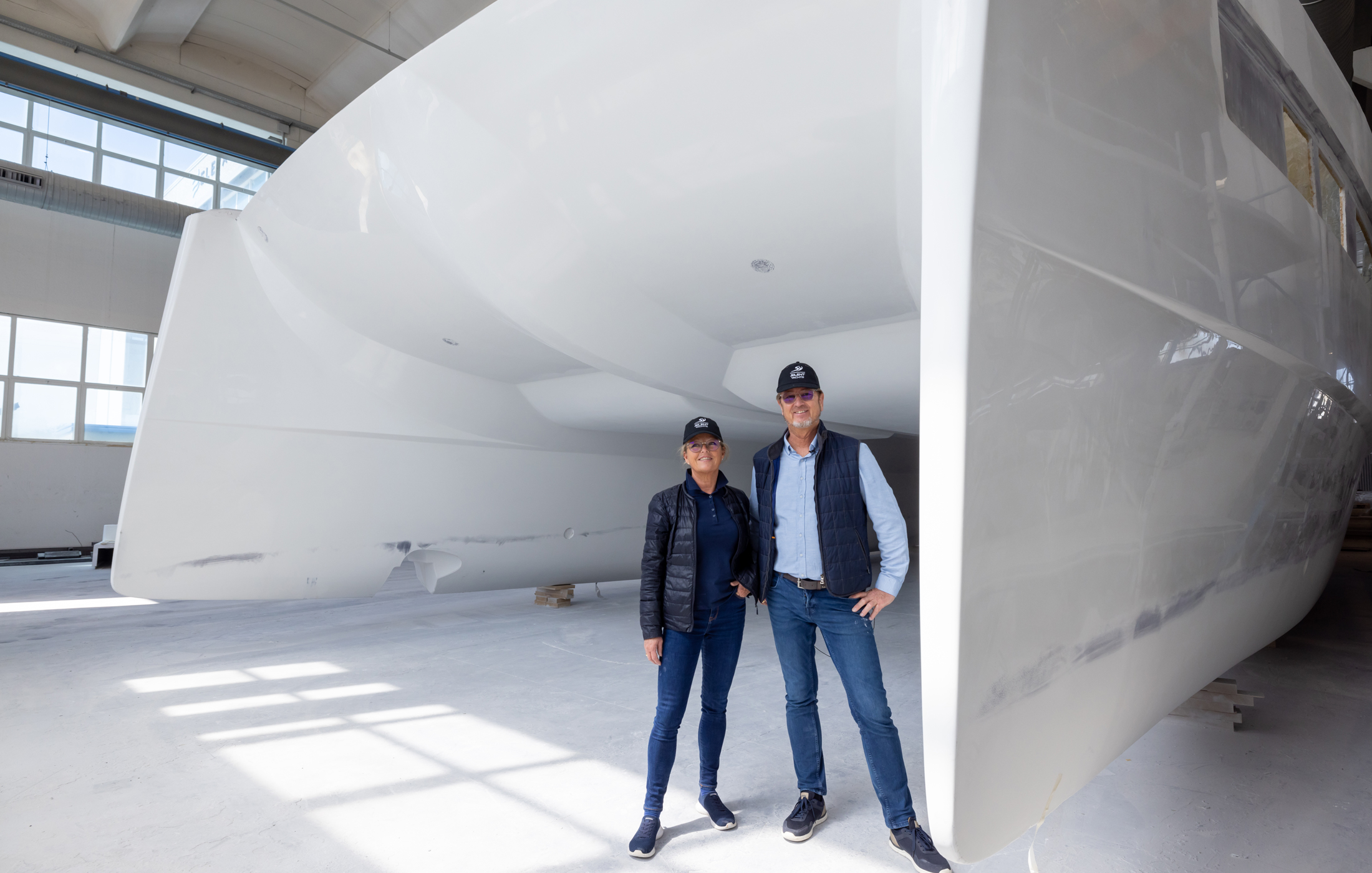
Shipyard tour Italy by Michael & Heike
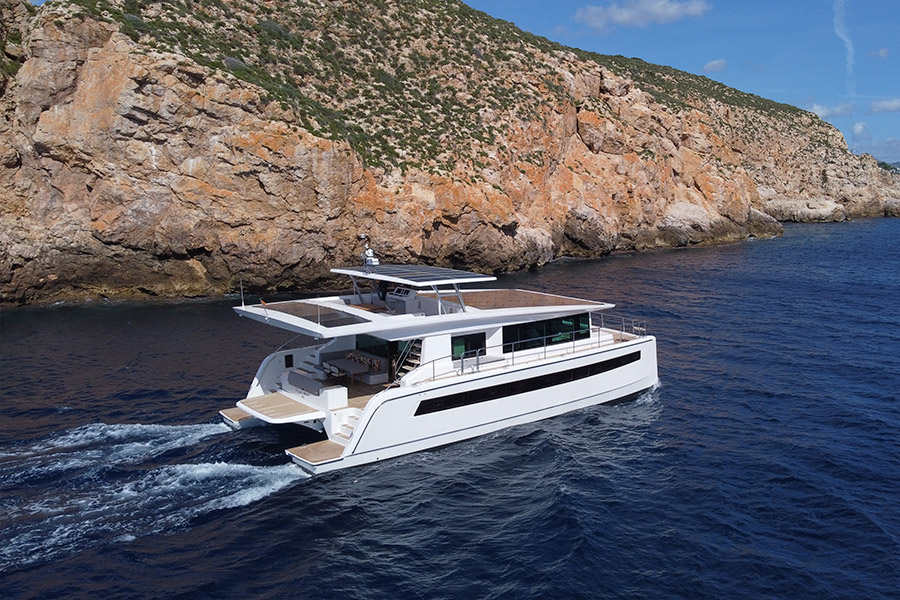
What is the range of a solar electric yacht?

Where are Silent yachts built?
“The Tesla of the seas! An amazing founding couple, a highly innovative product as well as a really cool story behind it. Furthermore, a lot of love and attention has been invested into every single detail – truly impressive!” Frank Thelen / TV Personality, Founder, Angel Investor & Disruption Expert
While the present has brought us the dawn of smart cars, I strongly believe the future will bring us solar powered smart boats – and I definitely want to be at the frontline of that journey. Michael Jost / Former Head of Group Strategy of Volkswagen Group
The idea of sailing while charging your own battery is super powerful to me – solar powered sailing is the perfect love story! Jochen Rudat / Former Tesla Central Europa Director, Advisory Board Silent Group
Elon Musk single handedly forced an entire industry to go electric, as a matter of fact if they don’t all go electric now they will soon die. I would like to see the same thing happening for boating. You are not just selling boats – you are the actual leading edge of a crucial and much overdue revolution to sustainable transport!” Klaus Obermeyer / Emmy Award Winner
I am completely excited about solar catamarans. I knew before they are great but now I truly believe this is the future. After so many boats I’ve seen in over 18 years with Boote Exclusiv, this yacht truly blew my mind. Such a silent and peaceful cruising experience – just the way it should be. Martin Hager / Editor in Chief for Boote Exclusiv - Yachts
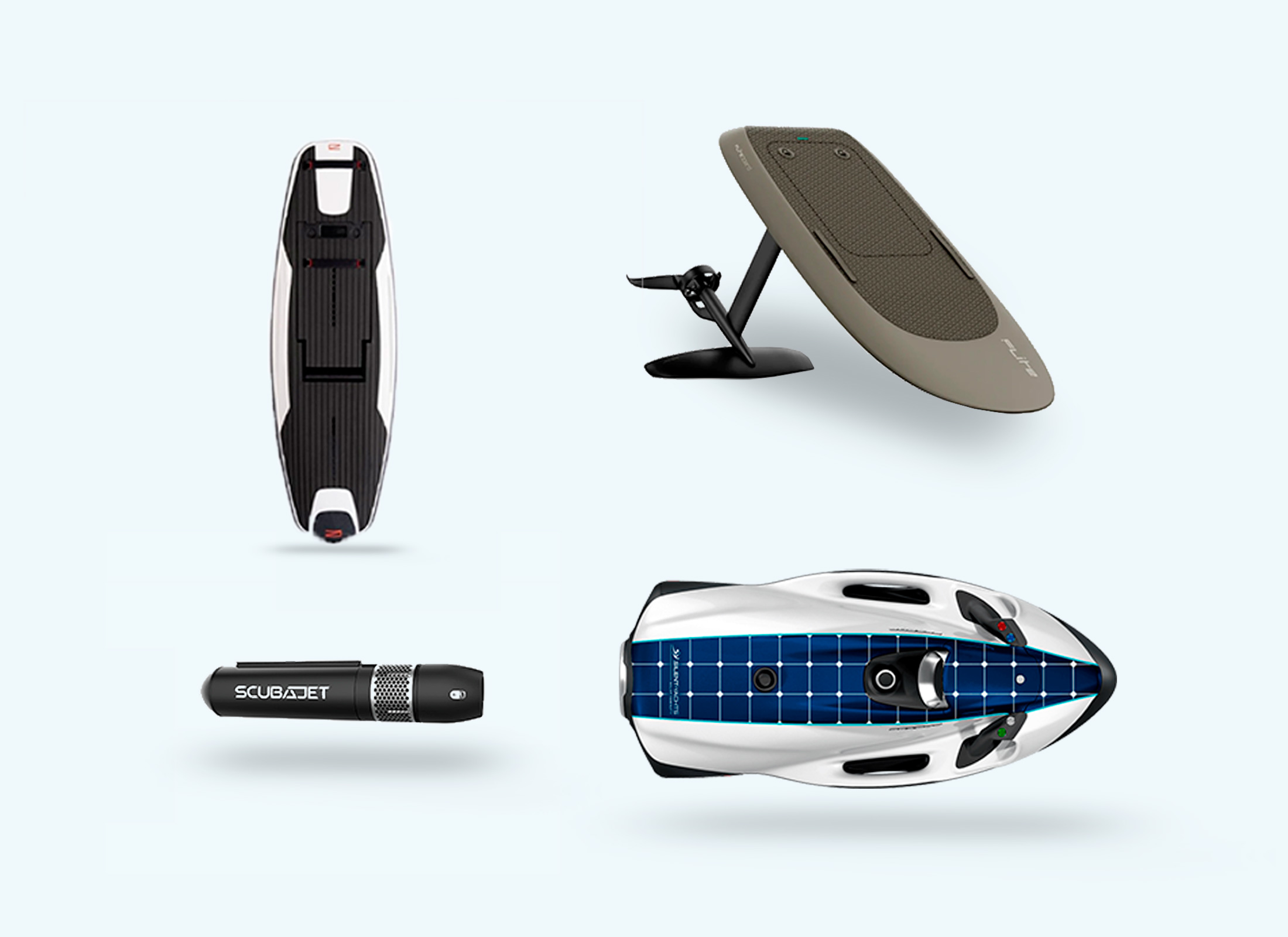
Recommended water toys, accessories and products to enhance every Silent voyage:


Solar Sailing
August 18, 2016 | By: Oceana
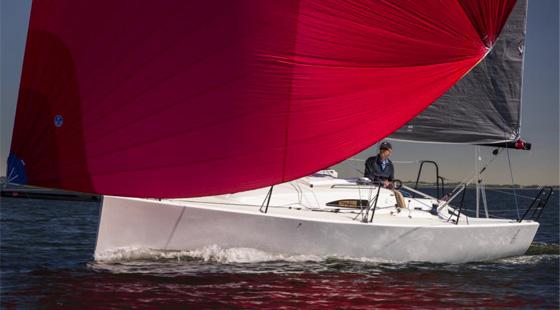
The wind is solar-powered. Quite literally, wind is convection currents created by sun heating the earth. Now 21 st century solar technology allows sailors to harness the sun, as well as the wind, to move us through the ocean. The J-88 day sailor is a leading example of a growing trend in integrating alternative energy technology into boatbuilding. We recently had the pleasure of test-driving the J-88 in Miami.
Driving the OceanVolt Electric Drive
Imagine having a quiet conversation on board when powering to the marina after a relaxing day sail, instead of revving up the internal combustion engine. No more choking on diesel exhaust going downwind, no more gasoline fumes in the bilge, no more fuel dock runs. The J-88’s solar package, built around an OceanVolt SD6 6kW 48vdc propulsion system and UK Sailmakers SolarClothSystem® solar panels on the mainsail and bimini, opened our eyes to those possibilities. With these innovations, fossil fuel propulsion may soon be a relic for “classic boat” aficionados.
The OceanVolt drive is indeed quiet. While not Hunt for Red October silent, the electric drive is a huge improvement over the diesel experience. When motoring at five knots, we had to ask whether the electric drive was on. Down below one can hear the drive humming when engaged, and there is of course the mechanical churning of the prop thru the water, but the contrast with diesel systems was striking. Perhaps the most surprising aspect of the electric drive was the brawny torque and “bite” on the water when accelerating or shifting into reverse. The electric drive ramps seamlessly from a standstill to full power like a Tesla Model S, noticeably more smoothly than a mechanical drive system.
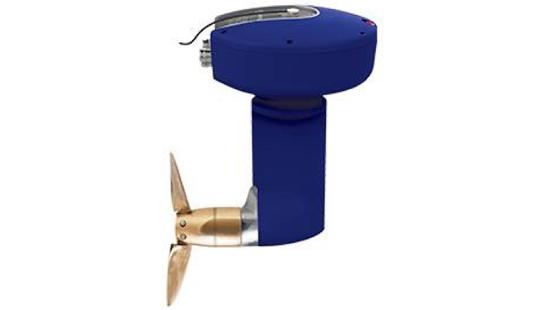
Photo: J-Boats
Minimizing our Environmental Impact
Sailing is already relatively clean, but the solar sailing package reduces the remaining environmental footprint dramatically. As stewards of the ocean, solar sailing is an inspiring opportunity to eliminate fumes from getting in the way of enjoying nature, make fuel spills a vestige of the past, and banish greenhouse gases that worsen climate change and ocean acidification.
Solar Panels in Sails
The electric drive is powered by an integrated system of Valence U24 lithium phosphate batteries and 600W solar panels. The solar panels are laminated right into the mylar sailcloth mainsail, allowing the batteries to charges while sailing, and another array of panels are sewn into the bimini for charging while at anchor or dockside. In the J-88 configuration that we sailed, the mainsail had 9 solar panels on each side, and the bimini has a zip-in 6-panel layout. The thin-film solar panels are as flexible as the sail itself, shape smoothly when hoisted and flake easily over the boom (see photo). The panels can be placed in the lower third of the main for racing configuration, or in the mid-third for a cruising main to allow for reefing while keeping the panels in the sun. Thin wires run down the luff along the mast into battery bank, similar to wiring from wind instrumentation.
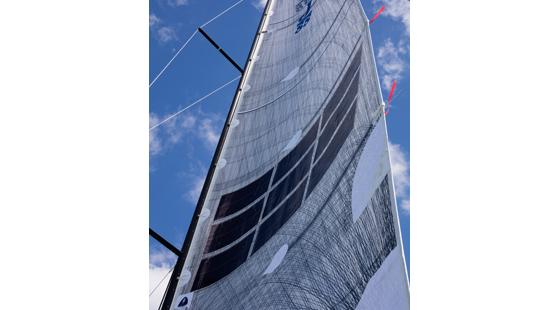
More ways to Power Up
Of course, the battery system can also be charged conventionally with shore power with a 5-6 hour recharge time from empty. But apart from the solar charging, the electric drive can actually power itself – if you have enough wind to cruise at 6-7 knots under sail, the prop will spin backwards to charge the batteries, serving as an underwater generator.
Practical Sailing
Previously, the challenge of solar-electric propulsion has been range, but this new technology is a breakthrough. On a full-charge there is enough battery power to motor up to 20 nautical miles with no sail or with solar power support depending on wind and sea state. In theory, on a sunny day, with the solar panels charging and 4 knots of wind for the sails, the J-88 can motor-sail at a cruising speed of 5 knots all day long! This estimate is based on perfect conditions, but considering even gas or diesel runs out eventually, the range is pretty impressive. We motored in Miami harbor for almost an hour and the battery charge scantly dropped from 93% charge to 86% with no solar charging. In any event, most recreational sailing is coastal and easily within the electric drive’s range. J-Boats and other manufacturers are also looking at adapting highly efficient and clean fuel cell technology (which generates electricity from propane or natural gas) for sailors who need blue water cruising range.
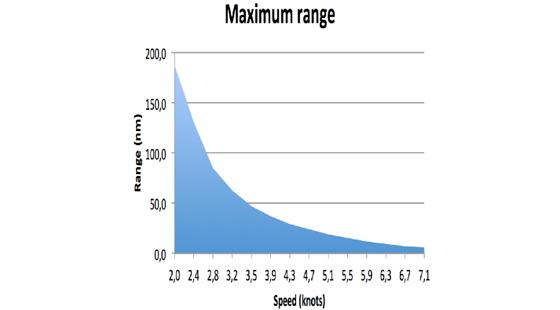
The electric propulsion system is fully integrated with high-tech power draw monitoring and other data systems to allow the crew to manage charging and propulsion options.
The solar sailing package, being innovative technology, does cost more than a conventional diesel engine, adding 10 to 15% to the purchase price for a full solar sailing package. But the cost is coming down rapidly and there are savings that one would not think of at first, such as not needing a muffler or fossil fuel storage system, and of course the savings (both financial and convenience) from not needing to purchase fuel.
The J-88 itself is a sporty day sailor with a nice mix of ease of sailing and race-ready performance — but others will write about that. What gets us excited as a Sailors for Sea board member and cruising sailors is J-Boat’s integration of several cutting-edge products creating a green and clean energy package. For more information, visit http://www.jboats.com/j88-oceanvolt
Check out Sailors for the Sea’s Green Boating Guide for more information on how to go green on your boat. Download your free copy by clicking here.

Max Williamson serves on the Board of Directors of Sailors for the Sea and boats on the Potomac River and coastal Maine with spouse Leslie and dog Talisker.
Spread the Word

Visit our Program Page
Learn more about our ocean conservation programs
The ocean is
more acidic due to absorbing excess CO2.
Sailors for the Sea is a 501(c)3 nonprofit organization. © 2024 Sailors for the Sea. All rights reserved.
News & press | contact us | terms of use | privacy policy.
Simple efficient solar solutions
FLIN solar GmbH develops and distributes solar modules and innovative solar systems for boats and yachts. Become independent through solar energy.
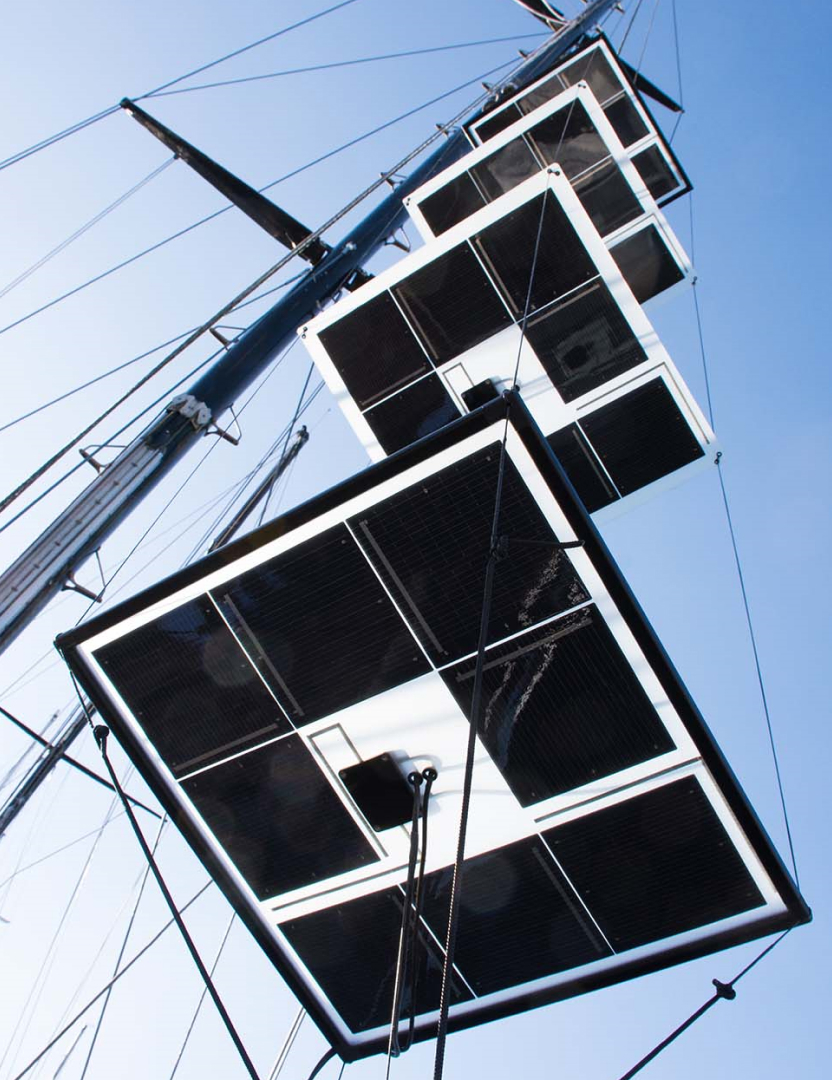
FLIN provides the optimal solution.
Are you looking for the right solar system for your boat? Whether you need a small solar panel for maintaining charge or a powerful solar system for large electrical loads - FLIN has the solution tailored for you.
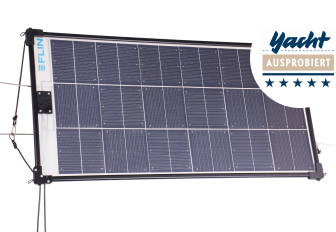
The FLINrail + can be easily hooked into the railing and tilted depending on the position of the sun.

If required, the FLINsail can be pulled into the mast instead of the mainsail and aligned to the sun.
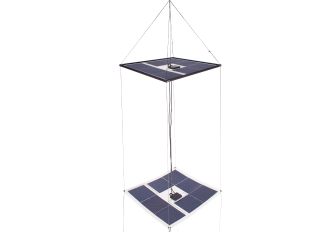
The FLINkite + is hoisted on any halyard and can be oriented towards the sun.
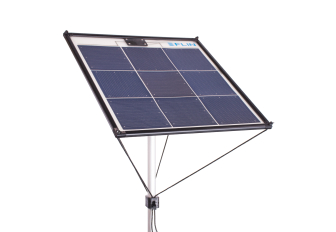
The FLINpole + is a solar panel that is mounted on the pushpit by means of an aluminum rod. It can be oriented in all directions.
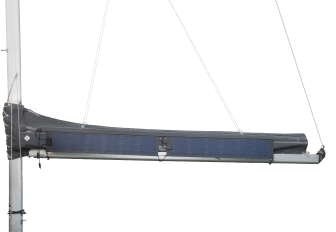
Our FLINstripes are attached to the tree tarpaulin using Velcro strips.

The FLINflex series offers solar modules of any size with different mounting systems.
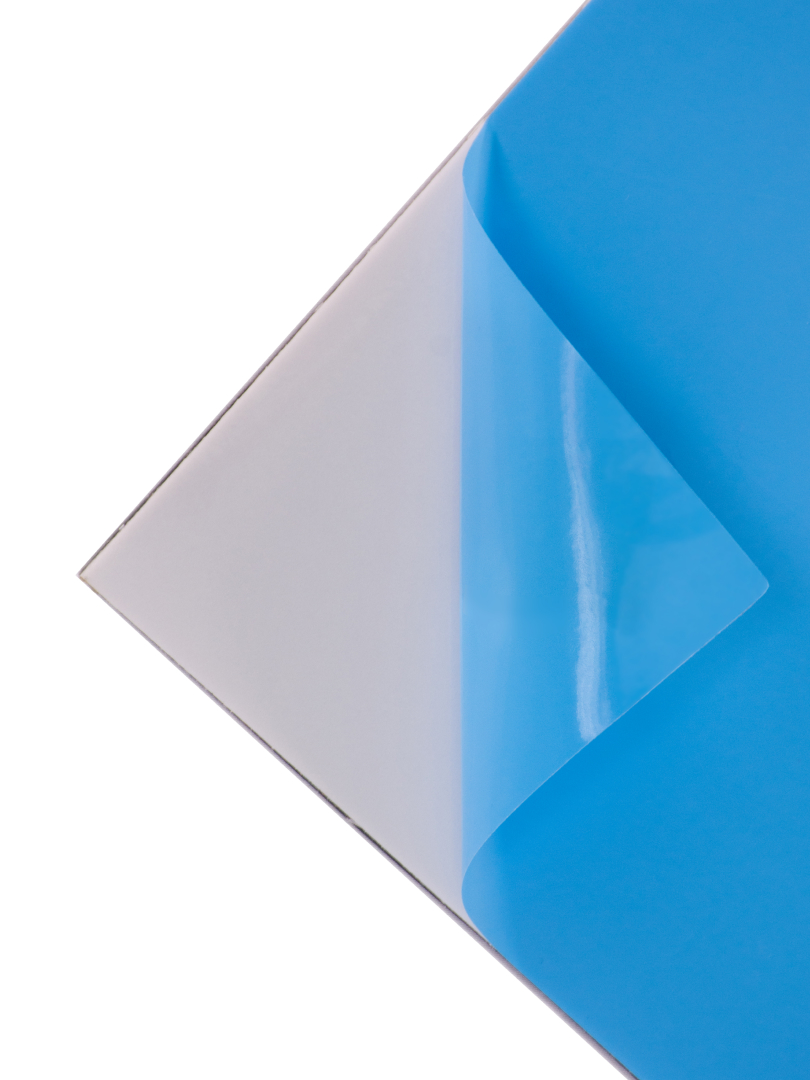
FLINfix is a solar module for fixed mounting on deck. It is attached by means of an adhesive film on the back.
Why do systems from FLIN deliver such good yields?
Decisive for the performance of a solar module is its alignment at the perfect angle. For maximum energy gain from solar radiation, the solar modules in the FLIN systems can be aligned to the sun. This enables maximum solar energy gain even in the evening hours when the sun is low in the sky.
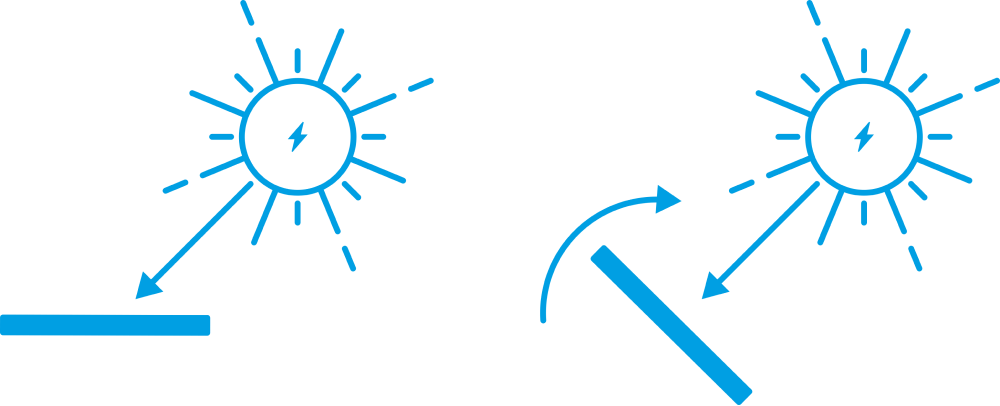
FLIN-Videos
Discover more about FLIN solar GmbH: FLIN's YouTube channel contains many exciting videos about our products as well as customer interviews and test results of various Torqeedo electric motors.
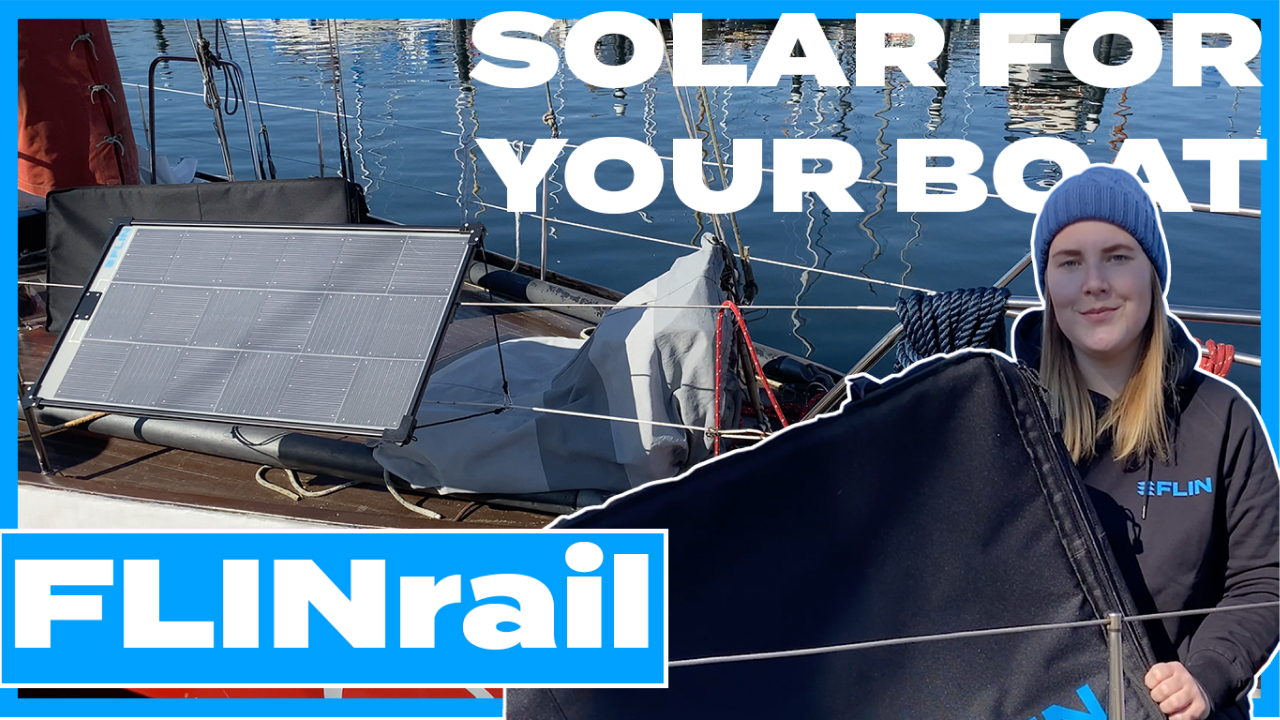
FLINrail - The simplest and most efficient solar module for the railing on board
How does the FLINrail + work? Simply hook it into the railing, point it towards the sun and harvest solar energy. Find out more in our product video about the FLINrail + !
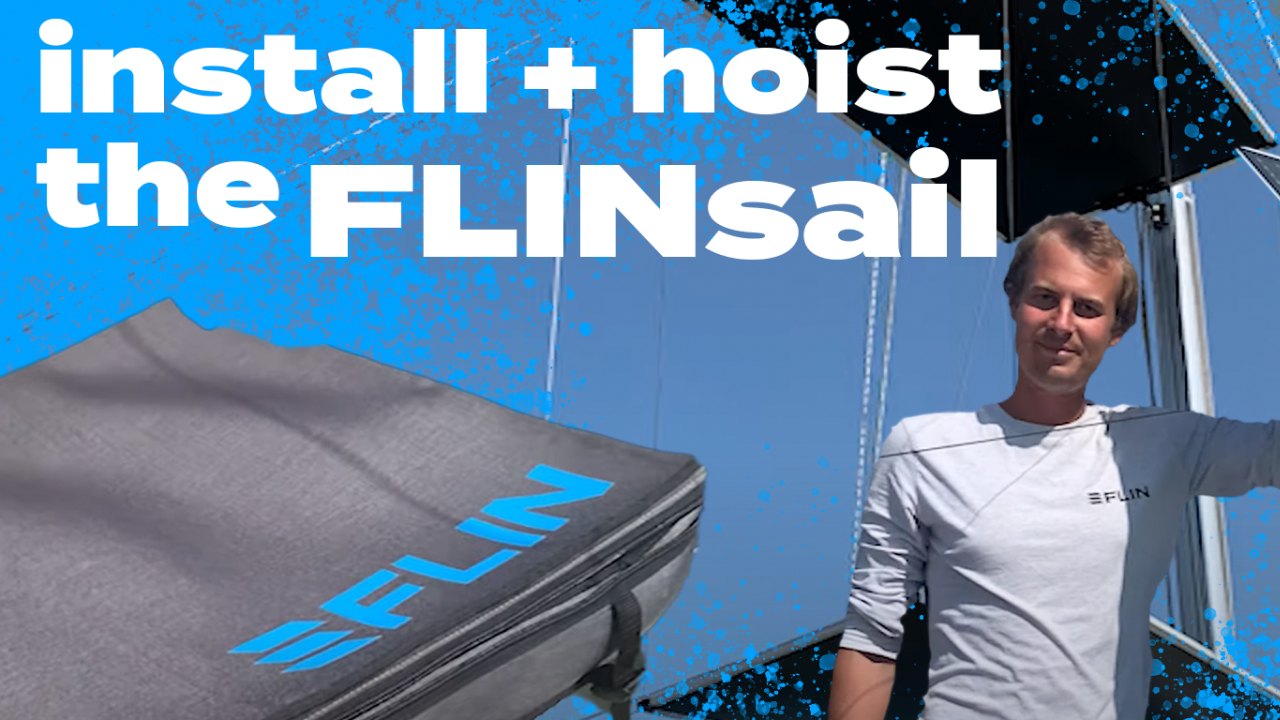
How to install the FLINsail solar system on your sailing yacht
It's very simple: In this video we show you step by step how to set up the FLINsail solar system on your sailing yacht.
FLIN for maritime e-mobility
We want to make existing energy usable. Our goal is to generate solar energy simply and highly efficiently on the water. In this way, we would like to contribute to advancing maritime e-mobility. In addition to reliable functionality, we place great emphasis on user-friendliness and sleek design.

Partner companies
Our solar modules and solar systems are interesting products for your customers and you would like to become a sales partner? Please feel free to contact us. Are you interested in a cooperation or are you looking for an innovative solar solution for your project? Please feel free to contact us.

FLIN solar GmbH Falckensteiner Str. 2 24159 Kiel
Lasse Hochfeldt:
+49 (0) 151 592 155 02
Malte Näthke +49 (0) 157 89173160
E-mail address info (at) flin-solar (dot) de
Social Media
Cookie settings
We use cookies on our website. Some of them are technically necessary, while others help us to improve this website or provide additional functionalities.
- Necessary cookies
Necessary cookies enable basic functions and are required for the proper functioning of the website.
Statistics Cookies collect information anonymously. This information helps us understand how our visitors use our website.

- Forums New posts Unanswered threads Register Top Posts Email
- What's new New posts New Posts (legacy) Latest activity New media
- Media New media New comments
- Boat Info Downloads Weekly Quiz Topic FAQ 10000boatnames.com
- Classifieds Sell Your Boat Used Gear for Sale
- Parts General Marine Parts Hunter Beneteau Catalina MacGregor Oday
- Help Terms of Use Monday Mail Subscribe Monday Mail Unsubscribe
Solar panel question/Recommendations
- Thread starter artleyt115
- Start date Jan 25, 2023
- Forums for All Owners
- Ask All Sailors
Attachments
- Power plan.pdf 54.7 KB Views: 67
You need to get a charge controller for the solar panel... then... yes... it would be okay to hook it up to your one battery. @Maine Sail has a few good writeups on this topic.
artleyt115 said: Hello everyone! It’s me again asking more power questions (Hooray!) so I have all my devices in the boat now and I drew up a little excel sheet of how much everything can consume and the hours we plan to run the devices. Now by my (poorly done) math I should expect around 4 day of battery usage of my one GEL 100ah battery with all electronic do-dads on the boat. Now some things (like the fridge) were put at the average consumption, though when I wrote the excel sheet, I put both the initial cooling wattage and the idle wattage (I plan to run that in the house over night before a trip to get the fridge to temp then put it in the boat). So, my questions; if I add another battery in parallel, in theory it should give me 4 days of capacity. If I add another battery, can I put a 200w solar panel on the boat and expect the batteries to be able to take the possible 30amp it can (potentially) produce. And can I put the same solar panel on just one battery for now (Until I buck up and buy the other one) and expect one battery to withstand it? Also (I know sorry) I have a 10a (2 bank) battery charger that I am hooking up, if I get two batteries in parallel can I put one bank on each battery? View attachment 212454 Click to expand

dlochner said: You're off to a good start. If you are unsure of your math, please post the spreadsheet so we can check the formulas, much easier than doing the math ourselves. A few comments: Pick one unit of power, either watt hours or amphours, it is much less confusing that way. Batteries placed in parallel should be of the same age and type to ensure the charges on the battery are balanced. This will lead to longer battery life. Lead Acid batteries generally have a maximum usable capacity of 50% of the total capacity, if the battery is fully recharged between discharges. Realistically, when cruising or when shore power is not accessible, they have a useable capacity of 40%. There are a few exceptions, carbon foam batteries and a couple of high end AGMs have a larger capacity, up to about 70%. Charging a battery is inefficient, it will take between 110% to 120% of the used ah to recharge the battery, i.e., for every 10 ah that is used, recharging will require 12 ah. Solar panels will average efficiencies can be expected to produce 3 times the nominal power each day. A 100 watt panel will produce about 300 watts (25 ah) on average per day, less on cloudy days, a little more on bright sunny days. High efficiency panels (expensive) panels can get close to 4 times. AGM batteries can generally absorb 20 to 40% of their rated capacity when charging in the bulk phase (constant current). This is written as .2C. A 100 ah battery can take a charge of 20 to 40 amps in the bulk phase. Reputable battery manufacturers will use the 20-hour discharge rate to label capacity. Less reputable ones will use the 10 hour rate which tends to yield a higher capacity rating, but less actual capacity in real life settings. A two bank charger can not deliver more than its rated capacity. When 2 batteries are connected, the charge current is divided between the two batteries. Your 10a charger will only put out 5a per battery, which will lead to under charging and very long charge times. Click to expand
dlochner said: You're off to a good start. If you are unsure of your math, please post the spreadsheet so we can check the formulas, much easier than doing the math ourselves. Click to expand
artleyt115 said: This is some really good information, from the sounds of it I should be able to use the 200W solar panel with no issues. (especially with a controller) I'll attach the sheet (though I did not use the formulas on the sheet I just hand did the math) I figured the charger was under powered for even one battery but I mainly figured it was a trickle charger to keep in the boat when I have it on a trailer. Though I didn't know about that absorption rate on the battery, that's awesome! Btw I heard through the grape vine that when a batteries are in parallel they have to be charged slower, is this true? (I don't think this is true but I thought I'd ask) Click to expand
Ralph Johnstone
artleyt115 said: The site wont let me post it :/ Click to expand
artleyt115 said: ... (especially with a controller) ... Click to expand
Timm R Oday25
A couple of thoughts . We also have 25 Oday . A 200 watt solar panel is going to take up an enormous amount of room . We mounted a 30 watt off the back of the rear pulpit . I ran the wiring inside the railing ,under the cockpit and into the regulator mounted on the back of the bulkhead . Most of the electronics you have listed most likely will only run randomly throughout the day . We actually have two solar panels, one for each battery . The "charging" we get from the outboard is maybe 3 to 4 amps . Normally ,we draw down one battery until we are at 12.3 volts . We then flip the battery selector switch to the other battery . While we don't have refrigerator, the auotpilot uses several amps at a time when in use. We've been able to stay out for as long as a week this way
Timm R Oday25 said: A 200 watt solar panel is going to take up an enormous amount of room . Click to expand
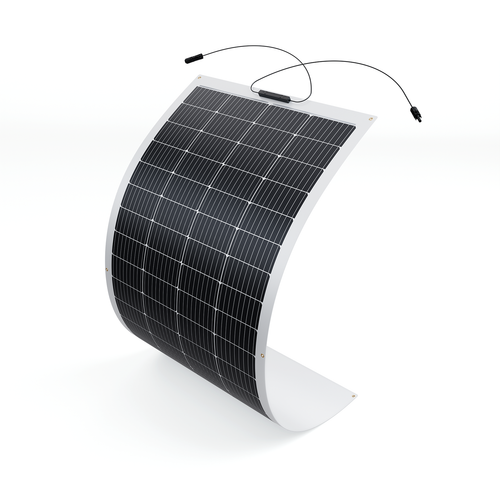
200 Watt 12 Volt Flexible Monocrystalline Solar Panel

Highest Efficiency (up to 25.4%)And Best Flexible, Rigid, And Walkable Marine Solar Panels For Your Boat in 2023. We'll help you decide on the right solar panels to meet your power needs.

Maintenance of Flexible Solar Panels
dlochner said: I didn't realize the site blocked excel files, probably because of macros that could hide malicious code. You must use a controller. The Victron controllers with Bluetooth are a good choice, easy to program and efficient. When batteries are in parallel or series they act as one large battery. Batteries in parallel will increase the ah capacity and the charge capacity will increase, but not the acceptance rate, it will still be .2C, but 20% of 200 ah instead of 100ah. Click to expand
Timm R Oday25 said: A couple of thoughts . We also have 25 Oday . A 200 watt solar panel is going to take up an enormous amount of room . We mounted a 30 watt off the back of the rear pulpit . I ran the wiring inside the railing ,under the cockpit and into the regulator mounted on the back of the bulkhead . Most of the electronics you have listed most likely will only run randomly throughout the day . We actually have two solar panels, one for each battery . The "charging" we get from the outboard is maybe 3 to 4 amps . Normally ,we draw down one battery until we are at 12.3 volts . We then flip the battery selector switch to the other battery . While we don't have refrigerator, the auotpilot uses several amps at a time when in use. We've been able to stay out for as long as a week this way Click to expand
rgranger said: Here are some more ideas and products... Highest Efficiency (up to 25.4%)And Best Flexible, Rigid, And Walkable Marine Solar Panels For Your Boat in 2023. We'll help you decide on the right solar panels to meet your power needs. Marine solar panels with best Sunpower cells, 23.7-25.4%+ efficient, A+ grade solar cells only. All info and consulting available to help you choose the ideal solar panels for your needs. Visit or call, we're more than happy to help. www.custommarineproducts.com Maintenance of Flexible Solar Panels maintenance of your flexible solar panels is easy, simply routinely keep them clean, check for structural integrity, and check the efficiency using monitoring functions in the charge regulators to ensure all is operating at optimum performance. coastalclimatecontrol.com View attachment 212460 View attachment 212461 View attachment 212462 Click to expand
rgranger said: You know.... this rabbit hole is deeeeep! We could start talking about electric outboards, LiFePO4 batteries etc. Click to expand
artleyt115 said: Yea it is, I dont plan to move to LiFEPO4 but I wanted an electric outboard originally just not too many good ones out there yet :/ Click to expand
Cruise – Electric Outboards with 6 to 25 HP – Torqeedo
rgranger said: Actually this Torqeedo Cruise is well reviewed and is equivalent to a 6 HP. My next pocket cruiser will get an upgrade to something like this... Cruise – Electric Outboards with 6 to 25 HP – Torqeedo Torqeedo Cruise outboard motors are state-of-the-art electric drive systems for boats up to 10 tons. With a respectable performance of 6 to 25 HP. www.torqeedo.com I go sailing for the silence and running an OB kind of ruins it for me. Click to expand
I'm confused by the 87w/12w rating on your fridge. You listed 288.0 WH, which is 12w * 24H. 12 watts seems too low. Let's assume 30w on average. Your inverter will draw power, even though you have N/A listed. A Victron Multiplus 2000 will draw anywhere from 3-9 watts depending on how search mode is configured. Let's assume 6 watts draw, 24 hours per day. Your depth meter is only used when sailing, not 24 hours. Call it 6 hours. Using your figures in addition to the assumptions above, I get a total of 3196.2 watts per day. A 200w panel will contribute around 800 watts per day. Figure in losses for voltage drop, battery efficiency and operating with an 80% depth of discharge, you'll need 227 AH of storage or 3 100AH batteries for 1 day away from shore power. Limit the PS4 to a couple of hours per day and you can eliminate 1 battery. But it might cause a mutiny. The numbers seem high but math is math.
mermike said: I'm confused by the 87w/12w rating on your fridge. You listed 288.0 WH, which is 12w * 24H. 12 watts seems too low. Let's assume 30w on average. Your inverter will draw power, even though you have N/A listed. A Victron Multiplus 2000 will draw anywhere from 3-9 watts depending on how search mode is configured. Let's assume 6 watts draw, 24 hours per day. Your depth meter is only used when sailing, not 24 hours. Call it 6 hours. Using your figures in addition to the assumptions above, I get a total of 3196.2 watts per day. A 200w panel will contribute around 800 watts per day. Figure in losses for voltage drop, battery efficiency and operating with an 80% depth of discharge, you'll need 227 AH of storage or 3 100AH batteries for 1 day away from shore power. Limit the PS4 to a couple of hours per day and you can eliminate 1 battery. But it might cause a mutiny. The numbers seem high but math is math. Click to expand
- This site uses cookies to help personalise content, tailor your experience and to keep you logged in if you register. By continuing to use this site, you are consenting to our use of cookies. Accept Learn more…

photo© www.svdelos.com
Let us help you go solar aboard, start enjoying c lean, quiet & renewable po wer.
At Sun Powered Yachts we hope to inspire and inform yacht owners on the benefits of going solar with SunPower & Maxeon. We're here to answer any questions you may have.
With a background in sailing & solar, and also from living off-grid for 11 years in Hawaii, we have the knowledge to help you with your solar install. Find out more about us
In 2021-2022 we spent 15 months as a family living aboard our sailboat, a Dufour 382 sailing from Corsica to Cancun and more recently to Florida & Bahamas . An intrepid adventure of over 7,000NM visiting 12 countries along the way. We're available for solar consultations with SunPower & Maxeon panels in stock in the USA ready to fulfill orders.
Aloha, Katie & Lyall
+1 808 825 2670
info@sunpower edyachts.com

Join over 5,500 people receiving our quarterly email updates
Thanks! You will receive our next email update . Follow us on Facebook & Instagram for latest news

SunPower ® 100 Watt
Maxeon ® a ir 3 30 watt.

SunPower ® 50 Watt

Maxeon ® 415 Watt -R (all black)

Maxeon ® 475 Watt

Maxeon ® 470 Watt
Choose your sunpowe r ® e-flex solar panel bundle, flexible panel bundles.

1x 50 Watt bundle

2x 50 Watt bundle

1x 100 Watt bundle
Free shipping in usa*, *at sun powered yachts we only sell premium cosmetic quality sunpower® e-flex panels. our inventory is warehoused in arizona, please visit our shipping policy for full details , 1% for the ocean, we are committed that 1% of your order with us goes directly to support the papahānaumokuākea marine debris proj ect ( pmdp ) in hawaii. the 2023 clean up season included 60 days removin g an incredible 212,410 lbs of marin e debris .

Federal Tax Credits

Have you heard about the Federal Tax Credits that you could take advantage of for going solar on your boat? Yes, your boat!
Do you have a head, galley & bunk aboard? Then you may qualify and t he Federal Tax Credit has now gone back up to 30% of the total cost to put your solar system in place.
This can include solar panels, controllers, wiring, labor etc. and can now more easily include batteries - maybe time for that lithium upgrade to Battle Born
SunPower Advantage s

Silent power
Solar panel systems burn zero fuel and have no moving parts. They are clean and silent, producing no atmospheric emissions or greenhouse gases that are harmful to the earth. Enjoy those quiet anchorages with no more noisy engine/generator running just to charge your batteries.

Easy install
The simple and easy installation of SunPower® E-Flex panels on your bimini, dodger, or deck, will reduce costs of adding an expensive davit or custom racking and mounting solution for traditional large & heavy fixed frame solar panels.

Highest quality
Incredibly reliable and easy to maintain. With no moving parts, visual checks and servicing easily keep systems operating. Solar panels are robust & durable with a junction box designed with a high level of protection from dust & water ingress.
SunPower Solar Panel Installs

Follow us on Instagram @sunpoweredyachts
News & reviews.

Maxeon to open new factory in USA
Great news! Maxeon recently announced (Aug 10th) that they will be opening a 3 Gigawatt factory in New Mexico. Construction will begin Spring 2024 and so by 2025 that's high efficiency Maxeon solar panels being made right here in the USA!
Read our news post for full details.

For sale - 'Blake' our Dufour 382
Are you looking for a boat already set up to go cruising? We have our 2016 Dufour 382 GL 'Blake' listed for sale on Yacht World . She is the adventure version with taller mast/deeper keel, 950W of SunPower flexible solar panels, a DC watermaker, new dinghy and plenty of safety gear. Currently hauled out in Freeport, Bahamas. For more details contact our broker Amanda Haley with South Florida Sailing
T: 954 444 2283

Check out our Install List
We have added an Install List page to our website which currently has over 130 installs from our customers. Get inspired by what other boat owners have added for SunPower & Maxeon solar panels.
Maybe you own a Lagoon 400 or a Morgan 41 and wonder what panels might fit aboard, check out the list to see how other owners have gone solar aboard.

Calico Skies 3x 410W
Bill & Grace sail Calico Skies , a Sabre 36, and whilst in Mexico they installed 3x410W SunPower fixed frame solar panels as part of a major upgrade to their arch/davit system.
Check out their YouTube episodes including #177 to see how they get on adding 1,230W (or 1.23kW) of SunPower solar panels.
Calico skies install details
"We made 7.2kWh yesterday out of our panels, what an upgrade!"
Bill & Grace

SV Delos 3x 410W + flex
Brian & Karin of SV Delos installed 3x410W SunPower fixed frame panels when on the hard in Mexico ( YouTube Ep.407 )
Combined with their SunPower E-flex panels, which have been aboard for ~3 years ( YouTube Ep.262 ) they now have just under 2,00W of solar keeping them powered up in the Pacific - awesome!
SV Delos install details
"Love our new 410W panels and they're the same size as the old 300W ones - woohoo!"
Brian & Karin

Sailing La Vagabonde 2x 470W + flex
Riley & Elayna of Sailing La Vagabonde have been working on their new Rapido 60' trimaran and added 2x470W Maxeon fixed frame panels.
They also have 6x170W SunPower flex panels they can deploy when needed. With a 48V battery bank these panels are wired in series YouTube episode
SLV install details
"Thank you, the solar panels have been absolutely incredible."
Riley & Elayna
Testimonials

"So now I generally
Don't bother hooking, up to shore power".
Thanks for all the help in planning my solar project for my boat. The two 170W flexible panels fit well on my Bimini and now I generally don't bother hooking up to shore power. Although I haven’t had any long trips since my installation I have done a few day trips. And even with fridge, radio, plotters, autopilot and occasional radar it seems that these panels are keeping up with my usage. The advice and service has been great. Thanks again.
Jeanneau Sun Odyssey 469

"It is by far the best decision I made "
I bought a solar system from Sun Powered Yachts in 2020. It is by far the best decision I have made for the electrical system on my boat. I would (and do) recommend Sun Powered Yachts to anyone looking to add solar to their boat.
Endeavour 33

"Terrific customer service, always responsive"
The process of researching a solar solution for my Beneteau 41 was simplified & clearly understood once I discovered Sun Powered Yachts. Terrific customer service, patient, always responsive with guidance and products that just work. Being a novice at setting up a solar system, I had many questions along the way, and the team at Sun Powered Yachts were always there to answers my questions and provide support.
Beneteau 41
Become a more sustainable sailor with SunPower® & Maxeon® solar panels
Sunpower® solar videos, our beautiful boat home (full boat tour).

Mastering OFF-GRID Living: 4 Key Things Every Sailor Should Know ⛵️ Sailing Vessel Delos Ep. 441

New Feature: Prioritising solar or wind when on shore power Victron Energy
GOING SOLAR - Video by Profiles in Dust (2023)

Custom Double Flexible Solar Panel Mounting System (No Drilling, Welding, or Permanent Adhesive)

Fundamentally different solar cells, chosen by champions

- Gear Directory
- Multihull Sailor
- Boats for Sale
- Real Estate
- Maintenance & Hardware
- Water Sports
Solar Power Boat: Are Solar Panels for Boats Worth the Investment?
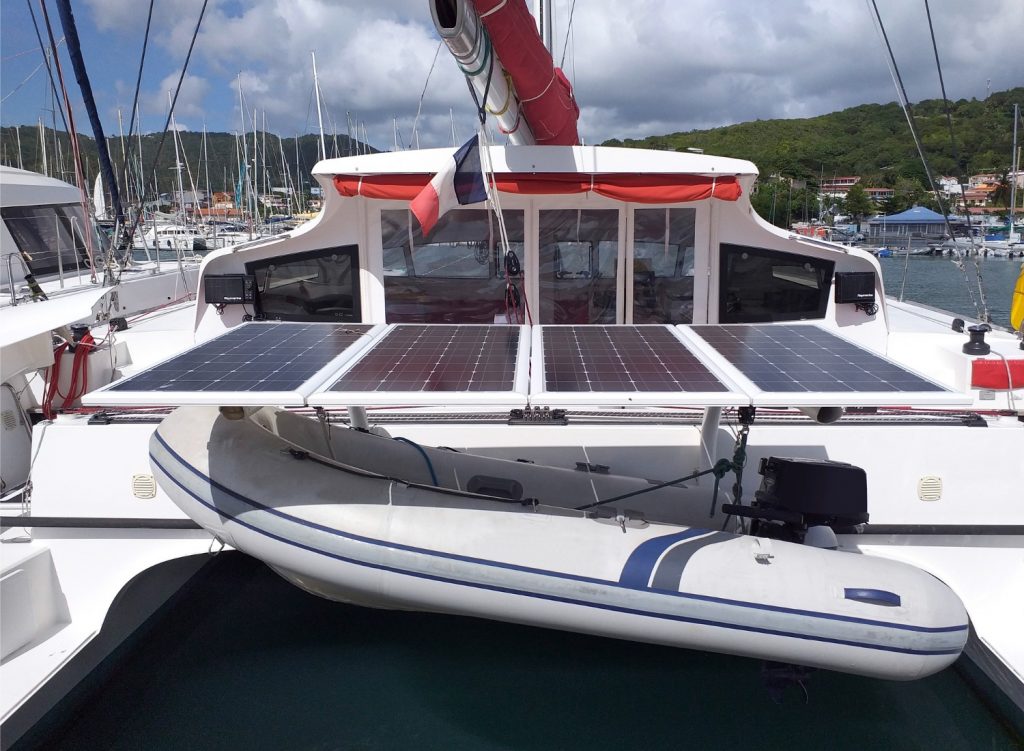
- 1 The Promise of Solar Power Boats
- 2 Considerations Before Investing in Solar Panels for Boats
- 3 Real-World Examples
- 4 Conclusion: The Future of Solar Power Boats
In today’s rapidly evolving world, where environmental consciousness is at the forefront of societal concerns, the maritime industry embraces innovative solutions to navigate a greener future. Among these innovations, solar power boats have emerged as a beacon of hope for eco-conscious boaters and enthusiasts. These vessels, equipped with solar panels that capture sunlight and convert it into clean, renewable energy, offer a tantalizing vision of sustainable marine transportation.
But as you stand at the threshold of considering whether to invest in solar panels for your boat, a pressing question looms: Are solar power boats worth the investment? The following exploration will delve into the advantages and essential considerations surrounding solar-powered boats. By the end, you’ll be better equipped to weigh the pros and cons, ultimately making an informed decision regarding this cutting-edge technology’s suitability for your maritime adventures.
The Promise of Solar Power Boats
Solar power boats, also known as solar boats or solar-electric boats, are vessels equipped with solar panels that capture sunlight and convert it into electrical energy to power various onboard systems, including propulsion, lighting, and appliances. The concept of solar-powered boats is appealing for several reasons:
- Environmental sustainability : Solar power boats produce zero emissions, making them a green alternative to traditional fossil-fuel-powered boats. By harnessing the sun’s power, they help reduce the environmental impact of recreational and commercial boating.
- Reduced operating costs : Once installed, solar panels generate free energy from the sun, which can significantly reduce the ongoing operating costs of a boat. This is particularly beneficial for long journeys or continuous use.
- Quiet and clean : Solar-powered boats operate silently, without the noise and pollution associated with internal combustion engines. This creates a more serene and enjoyable boating experience while preserving the marine ecosystem.
- Energy independence : Solar power boats can operate independently from shore-based power sources, allowing more freedom in choosing where and when to sail. This can be especially advantageous for off-grid or remote boating destinations.
Considerations Before Investing in Solar Panels for Boats
While the advantages of solar power boats are compelling, there are several important considerations to take into account before investing in solar panels for your boat:
- Initial cost : The upfront cost of purchasing and installing solar panels, batteries, and related equipment can be significant. However, viewing this as a long-term investment that will pay off through reduced operating costs and environmental benefits over time is essential.
- Energy storage : Solar panels only generate electricity when exposed to sunlight, which means you’ll need an efficient energy storage system (batteries) to store excess energy for use when the sun is not shining. Quality batteries can be expensive and require proper maintenance.
- Space constraints : The available deck space on your boat may limit the size and number of solar panels you can install. Careful planning and design are essential to maximize energy generation while maintaining a comfortable and functional onboard environment.
- Weather dependency : Solar panels are weather-dependent. Cloudy or rainy days can significantly reduce energy production, potentially affecting your boat’s range and performance. Backup power sources may be necessary for extended cloudy periods.
- Maintenance : Solar panels and associated equipment require regular maintenance to ensure optimal performance. This includes cleaning, checking connections, and monitoring battery health. Neglecting maintenance can lead to reduced efficiency and shorter equipment lifespan.
- Return on investment (ROI) : It may take several years to recoup the initial investment in solar panels through savings on fuel and electricity. Calculate the potential ROI based on your usage patterns and consider the long-term benefits to determine if it’s worth the upfront cost.
Real-World Examples
To better understand the feasibility and practicality of solar power boats, let’s look at a couple of real-world examples:
- PlanetSolar : In 2010, the PlanetSolar team achieved a remarkable feat by circumnavigating the globe with a solar-powered boat. The MS Tûranor PlanetSolar is covered with 537 square meters of solar panels, making it one of the largest solar-powered vessels in the world. While this project showcased the potential of solar boats, it also highlighted the challenges of designing and maintaining such a complex system.
- Local recreational use : On a smaller scale, many boat owners have successfully integrated solar panels into their vessels for local recreational use. These boats can operate quietly and efficiently for day trips and short excursions, reducing the reliance on traditional fuels.
Conclusion: The Future of Solar Power Boats
Solar panels for boats hold tremendous promise as a sustainable and eco-friendly solution for marine transportation. While the initial investment and technical considerations may deter some boat owners, the long-term benefits, reduced environmental impact, and the prospect of energy independence make solar power boats an exciting option.
Investing in solar panels for your boat ultimately depends on your budget, intended use, and commitment to environmental sustainability. As technology advances and becomes more affordable, the adoption of solar power in the boating industry will likely grow, making solar-powered boats an increasingly viable and attractive choice for recreational and commercial boaters. If you are willing to embrace this green technology and commit to its maintenance, a solar power boat could be a worthy investment in the future of sustainable boating.
Article Contributors
Sail magazine review team.
SAIL Magazine Review Team reports on best-selling products in sailing and boating. The SAIL Magazine editorial staff is not involved in the creation of this content. SAIL Magazine is reader-supported: When you buy through links on our site, we may earn an affiliate commission. The SAIL Review Team is composed of authors, editors, and sailors. Artificial Intelligence (large language models) may have been used in the research and creation of the content.
To ensure questions about product testing or a specific article are addressed, please contact [email protected]

6 Awesome Solar Boats for Eco Sailing in 2024 (Guide)
Liza pivoted from environmental consulting and doing impact assessments to writing about her two most counter-intuitive but passionate interests: sustainability and the importance of living an eco-conscious life; and marketing, martech, and AI. When she’s not writing, you can find her living a zero-waste-adjacent life in South Africa, falling down research rabbit holes on the internet, or out hiking with her dogs.
Introduction
Liza Shuttleworth pivoted from a career in environmental impact assessment and consulting to becoming a full-time writer, focusing on her most passionate (and diverse) interests: ecological conservation, sustainability, waste management and marketing, mar-tech, and AI.
Her professional portfolio reflects a diverse array of writing and consultancy roles spanning environmental science, marketing, and technology.
She has written for prestigious online and print publications on topics that include sustainability, climate change advocacy, waste management, and marine conservation, as well as marketing strategy, mar-tech, and the proliferation of AI tools for marketing.
Liza has an extensive professional background, having held management and consultancy positions within the environmental science, waste management, technology, and marketing sectors.
Her writing and editorial positions for both print and online publications have shaped content in ways that educate and inspire readers about sustainable living, climate change, and the power of innovative technology to overcome challenges in any setting.
Liza's academic background is rooted in a Bachelor of Social Science, focusing on Media and English. Beyond this, she has pursued tertiary qualifications in geography, psychology, and marketing, further enriching her knowledge base and contributing to her multi-faceted approach to writing and advocacy.
Solar boats are becoming a hugely popular choice for eco-friendly sailing. They’re quiet, can sail great distances without needing to stop for fuel, produce no carbon emissions, and do not rely on fossil fuels.
The popularity of solar-powered boats represents an evolution in marine transportation in favor of renewable energy and sustainability. Solar-powered boats provide a window into a future where clean, emission-free transport is not only possible but also preferred, due to developments in solar technology and design.
Solar boats are the ultimate of innovation and environmental responsibility, whether they are being used for peaceful journeys along beautiful canals or for bold ocean expeditions.
We reduce our dependency on scarce fossil fuels and lessen the ecological effect of traditional boating techniques by using the sun’s power to move us over the sea. Solar boats have the potential to completely transform the maritime sector and open the door to a more environmentally conscious and sustainable future for all, especially as the demand for eco-friendly alternatives keeps rising.
So, how do solar boats work? What are the benefits? And what are the best solar boats on the market?
In this guide, we explain how solar boats function, the advantages of using them, and six impressive solar boats you can purchase in 2024.
Let’s dive right in!
Table of Contents
How Do Solar Boats Work?
In recent years, solar panel and rechargeable battery technology have improved dramatically. Panels are lighter, stronger, and more efficient.
Batteries are more compact, more efficient, and weigh considerably less than they did in the past. Both batteries and panels now last longer and cost less than they used to.
These advances in technology and a growing interest in eco-friendly sailing have shifted the development of solar yachts from idealists’ dreams to the mainstream.
So, how exactly do solar boats work?
Solar boats use solar energy to power their motors, navigation systems, and onboard electronics, and appliances.
The solar system works much the same as a solar system on a house or RV , with some structural differences to meet the unique demands and challenges of a marine environment.
Solar panels mounted on the boat harvest solar power from the sun and send it to a charge controller , which controls the flow of electricity to a bank of rechargeable (usually lithium-ion) batteries.
From the batteries, power is sent to the electric motors, navigation systems and appliances via an inverter, which converts direct current (DC) to alternating current (AC). Most appliances like kettles, microwaves, and hair dryers use AC.

A solar system can be added to any boat, making it a hybrid or even just to supplement a little power using a renewable resource.
S olar is a great way to reduce your carbon emissions, reduce your fuel costs and increase the distance you can sail without stopping to refuel .
However, if you’re looking to buy a solar boat that is designed and built specifically for solar sailing, there are some really great options to consider.
What are the Benefits of Using a Solar Powered Boat?
When it comes to solar boats, there are some great benefits and they’re not limited to renewable energy and fewer carbon emissions:
- No reliance on fuel – diesel generators can be used as an emergency back up but they’re not needed for everyday sailing or electricity generation.
- Unlimited range: when batteries are constantly recharged by the sun, there is no need to stop to refuel and you can keep going indefinitely.
- No noise and no fumes: as there is no engine, there is no noise and no diesel fumes. This makes the experience of sailing a solar boat much more peaceful.
- No pollution: on a solar boat, there is no engine producing noise pollution, no carbon or greenhouse gas emissions , and no risk of fuel or oil spills.
- More space: the absence of engines frees up a lot of space. Electric motors and batteries can be housed anywhere on the boat and do not take up as much space as engines and machinery, which means room for more storage compartments to keep your gear or equipment.
- Lower running costs: beyond the initial investment and occasional maintenance, solar is completely free. This cuts out fuel costs and ongoing engine maintenance costs.
- Less maintenance: solar panels need to be cleaned regularly to be most effective but that is the only ongoing maintenance needed. Once a good solar system is installed, it generally needs very little maintenance.
- No limitations on electrical use: with solar, the supply is free and if you’re not pushing the motors to travel at speed you will often have more electricity than you need. This means you don’t need to watch your power consumption and you can run your air conditioning as much as you want!
- Options to sell power back to shore stations: if you regularly generate more power than you need from your solar, you can share it with others or sell it back to the grid at some shore stations.
The benefits you will enjoy from a solar boat vary, depending on your location and the specifications of the boat you choose. There are also some downsides, for example, solar boats are generally slower and the initial investment is quite high.
That said, solar boats are well worth the investment!
So, let’s look at some of the awesome solar boats available on the market in 2024:
6 Awesome Solar Boats
There are many great solar-powered boats to choose from and we have selected six of the best to feature here. We have chosen a range of sizes, styles, and price points so there should be something for everyone on this list!
1. Silent Yachts – Silent 55
The Silent 55 by Silent Yachts is one of their smaller solar yachts and can be handled by two people, with or without any additional crew.
It is spacious, and beautifully designed to be as economical as possible without losing any of the luxuries of their larger boats. With three to six cabins and all the amenities you can imagine, it offers everything you need to live on board permanently.
Check out this video by Kara and Nate to see their experience of the Silent 55 and meet the couple behind the iconic Silent Yachts company:
[embedyt] https://www.youtube.com/watch?v=iIte4FNI0U0[/embedyt]
Where to Buy: Silent Yachts
Price: From €1.97 Mio.
2. Serenity Yachts – Serenity 64
The Serenity 64 is a solar-powered hybrid yacht with a diesel engine. It can run on either, giving it a combination of unlimited range using solar or faster cruising using diesel.
It is a spacious and luxurious yacht, with plenty of living space and four cabins with en suite bathrooms. The Serenity is the smaller of the two solar-powered boats offered by Serenity. The Serenity 74 is bigger and more luxurious, with an interior designed by Neiman Marcus Fashion Director Ken Downing.
Take a look at this video by Serenity Yachts to see more of the Serenity 64:
[embedyt] https://www.youtube.com/watch?v=ltyu-KPesg0[/embedyt]
Where to Buy: Serenity Yachts
Price: From $3.3 million
3. Sunreef Yachts – Eco 80 Sail Catamaran
Sunreef Yachts Eco sail catamarans take eco-friendly sailing to new heights. Their luxury solar yachts use a special ‘solar skin’ that covers any composite structure on the yacht to provide solar power from every angle.
They also use hydro and wind power to supplement the solar and have a sail. The green power generated on their innovative solar boats is enough to propel the boat, run all the onboard appliances and charge the electric water toys.
Taking their commitment to the environment up a notch, they use recycled and reclaimed materials, non-toxic paints, and natural fibers.
Check out the video below by SUNREEF YACHTS OFFICIAL on a day aboard the Sunreef 80 Eco Catamaran:
[embedyt] https://www.youtube.com/watch?v=hXFg1R1qcgI[/embedyt]
Where to Buy: Sunreef Yachts Eco
Price: Price on Request (depends on the custom specifications)
4. Soel Yachts – Soel Senses 48
The Soel Senses 48 is a 48ft solar electric catamaran. It was designed to be solar-powered and is slender and lightweight to make it more economical.
There are two sleeping berths for two people each, and another four people can sleep in the salon. The interior and the exterior are both sleek and modern.
Everything on the Soel Senses 48 has been designed thoughtfully to make it as comfortable and functional as possible. It is faster than other solar yachts, due to its smaller size and innovative design.
Check out this video by Jim Waltz to see a little more of the Soel Senses 48:
[embedyt] https://www.youtube.com/watch?v=t5IOCWPwGXY[/embedyt]
Where to Buy: Soel Yachts
5. Azura Marine – Aquanima 40
The Aquanima by Azura Marine is powered entirely solar and features some innovative adaptations that make it even more economical and eco-friendly. For example, rainwater collection from the solar panels on the roof and the fact that excess solar can be sold back to shore stations.
The Aquanima is beautifully designed and the interior is clean and modern. It has two double guest cabins and two single crew cabins. It is one of the most cost-effective options if you’re looking for a purely solar-powered boat.
Take a look at this video by Azura Marine to see the Aquanima in action:
[embedyt] https://www.youtube.com/watch?v=X25IRdHoHqI[/embedyt]
Where to Buy: Azura Marine
Price: From €523,000
6. Silent Yachts – Silent 80 Tri-Deck Solar Catamaran
The Silent 80 Tri-Deck Solar Catamaran is a superyacht that is completely customizable. It offers huge amounts of space, with three decks that can be customized to suit the owner’s needs.
The top deck can be open or enclosed and can be used as additional living space or a luxury master suite, opening onto a private outdoor space. Both open and closed versions include four to six customizable cabins.
As a solar-powered yacht, it has more space where the engines would normally be and that storage space can be used to house water toys and additional recreational equipment.
Check out this video by Yachts For Sale to see more on the Silent 80 Tri-Deck Catamaran, how it is built and what sets it apart:
[embedyt] https://www.youtube.com/watch?v=KCZMzE5Q8lc[/embedyt]
Price: From €5.51 Mio.
Final Thoughts on Solar Boats
As solar and battery technology has improved, and boat owners have become more conscious of their environmental impact, solar boats have become both more viable and more desirable.
Modern solar boats, from small solar-powered yachts to solar superyachts, are equipped with state-of-the-art technology to make them economical, easy to maintain, and a pleasure to use.
They’re also becoming increasingly affordable, and we hope, will be a mainstream option available to every eco-conscious sailor soon!
Electrek: I Drove A Rare Solar-Electric Yacht to Test Clean-Sea Propulsion, Here’s How It Went
Environmental Protection: The Environmental Impacts of Boating
Custom Marine Products: A Cruiser’s Guide to Selecting and Sizing a Solar Charging System
Forbes: Solar-Powered Yachting: A Look Inside ‘The Tesla of Yachts’
Knysna Yacht Company: Top Things to Know About Yacht Solar Power
Robb Report: How Zero-Emission, Solar-Powered Yachts Entered Boating’s Mainstream
Robb Report: Solar-Powered Yachts Are Taking Over. Here’s Why That’s a Good Thing
The Land Between: Recreational Boating and the Environment – Tips and Tricks for Environmentally Conscious Boating
Yachting Monthly: Sailing with Solar Power: A Practical Guide
Frequently Asked Questions
How does a solar boat work.
Solar boats use renewable energy from the sun to run their motors, electrical systems, and onboard appliances. They do not use petrol/diesel generators or engines and meet all their power needs using solar panels and batteries. Read the full guide for more details on how a solar boat works.
What are solar boats used for?
Solar boats are used for any boating purpose but they’re most frequently used for recreational sailing, such as yachts and catamarans, as ferries and tour boats, or as houseboats. Solar boats are generally slower and less powerful than fuel-powered boats. In situations where speed is needed, solar is usually supplemented with wind-sail or fuel-driven motors. Read the full guide for more on solar boats.
What is a solar yacht?
A solar yacht is a yacht that uses solar energy to power its electric motors and all the electronic equipment on board. Solar yachts do not rely on diesel or petrol engines and run solely on solar power. They do sometimes have other power sources, like backup diesel generators or engines. Read the full guide for more on solar yachts.
Popular Related Posts

12 Leading Green Concrete Companies In 2024

12 Leading Green Steel Companies In 2024

14 Green FinTech Companies To Lead a Change in 2024 and Beyond

12 Best Carbon Accounting Platforms for SME & Enterprises in 2024 [Review]

9 Most Eco-Friendly Home Upgrades in 2024
Stay Informed with Expert Insights on Sustainable Living, Green Tech, and Environmental Impact. Subscribe to Our Newsletter Today!
Pin It on Pinterest
- StumbleUpon

This giant, solar-powered sail can travel forever, and it’s the future of space exploration
O ver the last two decades, Les Johnson and his team of engineers have quietly been pushing NASA into a new era of space exploration while nobody was paying attention. As an engineer at the legendary Marshall Space Flight Center in Huntsville, Alabama—the birthplace of the Saturn V rocket that first took humans to the Moon—Johnson led the complex design of a 17,780-square-foot sail that will push spaceships across the solar system without using a single ounce of fuel.
Called a “solar sail,” the silvery sheet of fabric is 32 times thinner than a human hair and stretches the size of three basketball courts. Over a recent Zoom call, Johnson says the sheet of fabric works much like a sail used for boats—if a boat sail were designed for high-speed space travel. “Just as a sailboat uses the wind to push it through the water, solar sails use the pressure of sunlight to push them through space,” Johnson says.
This seemingly impossible feat is, in fact, not impossible at all. Avi Loeb, an astrophysicist and Director of the Institute for Theory and Computation at the Center for Astrophysics at Harvard University, says solar sails represent one of the most promising technologies for future space exploration. They offer a sustainable and efficient way to navigate the cosmos, with the potential to propel spacecraft to unprecedented speeds and distances.
“A solar sail technology…can substitute rockets in propelling payloads to desired destinations in space,” says Loeb. “Reflection of sunlight pushes a thin membrane, just as the sail on a boat is pushed by reflecting air flow. The push is most effective close to the Sun [so] the solar sail technology is particularly useful for missions to study the Sun, Venus or Mercury.”
A kid’s dream
By the time Johnson was a teenager attending Coles Middle School in Ashland, Kentucky, he already knew he wanted to become a NASA scientist. Like many of the engineers who work in NASA labs across the United States, Johnson has always been a proud science fiction nerd. In high school he became obsessed with the idea of laser sails after reading the novel The Mote in God’s Eye written by Jerry Pournelle and Larry Niven in 1974, which describes a sail that uses photons as a thrust force to move a spaceship over vast distances at extremely high speeds. “I thought the idea of laser-driven lightsails was amazing, but I never dreamed I would get to work on anything like that,” he says.
The book wasn’t the first time someone thought light had the potential to propel a spacecraft at incredibly fast speeds with no fuel whatsoever. The idea of using solar light to push a sail was initially mentioned by Jules Verne in his seminal From the Earth to the Moon and further detailed by Arthur C. Clarke—the author of 2001: A Space Odyssey—in his short story “Sunjammer.”
But it was Pournelle and Niven’s tale of a sailing alien spaceship propelled by laser beams that inspired Johnson to become an engineer, get into NASA, and eventually win the space agency’s Science Mission Directorate open competition to finance the project. “I had an opportunity to get involved in a project that was looking at different types of propulsion, and this is one that I added to the mix to consider,” he says. “Now the technology is here—we can build these things. And that’s been on again, off again part of what I’ve worked on for the last 20 years.”
Johnson recalls writing down his first solar sail development roadmap around 2005 or 2006. Since then, his team has been chipping away at the roadmap, one advance at a time. “I am pleased to say that we’ve been following it, but not at the pace I originally envisioned,” he says.
NASA has been steadily increasing the size and complexity of its sails. It tested the first generation of solar sail in space—a 106-square-foot sail—in 2010. Then working with The Planetary Society, it launched a slightly bigger version—the 344-square-foot LightSails 1 and 2—in 2015 and 2019, respectively. In the mid-2010s NASA developed a second-generation solar sail with the NEA (Near-Earth Asteroid) Scout that stretches 925 square-feet and was launched in 2022. This year, it will launch a slightly smaller version called the ACS3 into space.
Now, NASA has completed a third generation called Solar Cruiser that reaches 17,790 square feet and it can be scaled up all the way up to 54,000 square feet. This generation has now reached “Technological Readiness Level 6,” the most important milestone for any project developed at the agency. It is essentially a green light that indicates the solar sail is reliable enough to be used on a real space mission.
No fuel needed
Unlike current chemical rockets—which burn fuel to escape Earth’s gravity—or ion engines—which use electrical fields to turn a noble gas like xenon into a steady stream of electrons that push a ship through the vacuum of space—solar sails don’t require any fuel at all. They only need sunlight to work.
This sunlight exerts gentle but powerful pressure on the sails. As the photon impacts build up in the sail’s ultrathin material, the spacecraft gradually builds up enough power and speed to move a payload in space. This payload is the actual starship, full of scientific instruments that vary depending on the scope of the mission.
This simple fact makes them ideal for extremely long missions. As Johnson puts it: “You could visit potentially multiple asteroids and never run out of fuel. You just keep going till the spaceship breaks down.” Right now, this type of mission is impossible, as deep space probes like Voyager or New Horizons depend on a complex billiard play of orbital physics that lets it reach a predetermined number of targets on their way out of the solar system.
While a typical space probe has a very limited amount of fuel to slightly adjust their trajectory, their speed is the result of the inertia from the rocket launch and the orbital equations that accelerate the ship as they jump from planet to planet (the gravity of each planet or moon acts as a ‘slingshot’ that further accelerates the ship). That’s why they follow a predetermined trajectory that you can’t really change on the fly. A solar sail space probe, on the other hand, can go on forever because it has no fuel, so it is inherently infinitely more sustainable and efficient since it only requires sunlight to move.
NASA’s hardest design challenge
Johnson’s enthusiasm for this project is palpable when speaking with him. Solar sails are not just a new way of moving spacecraft, but a paradigm shift in the way we think about space travel. Still, they come with plenty of challenges.
When Johnson and his team began to design the first space sail, they encountered many problems that they expected. Surprisingly, he tells me, these were relatively easy to solve at the technological level.The first was the material that makes the sail.
“Solar sails require materials that are not only highly reflective, but also incredibly light and durable,” explains Johnson. “At 1 astronomical unit (the distance between the Sun and Earth) from the Sun, there’s a fixed amount of sunlight that falls on the sail.” The bigger the sail, the more photons it captures, and the more thrust you get to move a bigger mass. That’s why it is so important to maintain a delicate balance between the robustness of the material and its final mass. If the material is too thick, the sail will weigh too much. And this higher weight significantly decreases the load capacity of the spaceship.
The material also needs to be compressed into a package small enough to fit in the fairing of the rocket that will take the solar sail ship to space, where it expands thanks to a system of booms that unfolds the sail into its final square shape, just like sails are unfolded across a mast. So flexibility is key for the material too.
They found the solution from Nexolve, the same company that manufactures the solar shield for the James Webb telescope. In fact, the sail’s material is very similar. The film is made from resin and then adhered on top of a thicker film called a backer. It’s produced in 60-inch wide rolls which are seamed together to make large areas using a proprietary resin bonding process, as Brandon Farmer, director of advanced materials at Nexsolve, tells me over email.
“No adhesives are used in the process.” Other features are added to the film during sail manufacturing including rip-stops, edge reinforcements, electrical jumpers, and reinforced corners so it is structurally sound. Finally, the film is trimmed to the desired shape and the backer is removed leaving the 2.5-micron thick sail. “The sail is then z-folded, like a paper fan, resulting in a long narrow folded sail,” Farmer says. “For packaging, the sail is typically wrapped around a spool and secured to the spool.”
Which takes us to the second problem. “One of the biggest challenges was designing a deployment mechanism that was both reliable and lightweight,” Johnson says. The extended sail cannot be launched into space, hence the spool that is attached to the spaceship and then packed together in the rocket fairing, the metal pod at the top of the rocket that encapsulates the probe.
NASA worked with Redwire—the sail’s prime contractor—to develop a system of 100-foot-booms and deployment mechanisms. After reaching orbit, the boom mechanism gets activated, pulling the sail off of the spool and tensioning it into its final square shape.
Like piloting a sailboat, sort of
“The big challenge was not what I thought it would be when I started working on it,” Johnson says. “The hard part is controlling the sail and steering it. And the reason for that is, when the sail is deployed, the acceleration never stops as long as there’s light. Unlike a rocket, which can turn off your rocket engine when it’s pointing in the right direction and just coast.”
Maintaining proper guidance and control of the ship was an extremely difficult problem to work out. So was the problem of keeping it perfectly flat while maneuvering. “If the shape is not what you predicted, then you might get a little bit more pressure on one side of the sail than the other,” he says. “And over time, that could cause your sail to flip over.”
Like any other flying vehicle, you need a system to pitch (control of direction up or down, the x axis), yaw (control of direction left or right, the y axis), and roll (rotating on the ship’s z axis) to maneuver in three-dimensional space. Achieving pitch and yaw control was the easier part of this problem.
The engineers realized that they needed to look at the entire mass of the ship and the sail. They figured out that they need to change the center of mass of the entire vehicle by moving the spaceship in relation to the solar sail, like a motorcyclist will change the center of mass by moving the body in relation to the bike.
In their system, the spaceship is connected to the sail using cables, which are threaded through a special system so they don’t tangle, Johnson explains. “There is a motor that drives essentially a screw that moves the ship back and forth relative to the sail [or vice versa, depending on your point of view]. You just mechanically move the sail top to bottom, left to right, until you balance the forces.” Ground operators—or, theoretically, a built-in navigation algorithm that works like an automated pilot—only needs to order the mechanism to move it a tiny bit for the entire vehicle to move into any desired direction.
Rolling, however, is an entire different ballgame. In regular space vehicles, this is done using tiny rockets that fire to rotate the ship, then stop. But that would be impossible for the sail. You just can’t afford the weight of those engines in the spaceship, and that won’t work to move the sail anyway.
The key to achieve this was to control how many photons the sail reflects. “We developed these things called reflective control devices,” Johnson says. Basically, these are little thin films that you put in the fabric of the sail. Roughly speaking, these are similar to liquid crystal displays: when you apply a little bit of voltage to them, they lower their reflectivity.
The regular sail is extremely reflective, which gives it full thrust. This patch lowers the thrust as it lowers its reflectivity. Over time, that causes the ship to roll in the desired direction. Once it’s moving in the right direction, the ship can increase reflectivity to stop the rolling. The change is almost imperceptible to the eye, but the difference in the amount of reflected photons is enough to control the spin.
Essentially, NASA can steer its solar sail ships much like a pilot can steer a sailboat.
It’s showtime
With all these problems solved, it was time to build the third generation solar sail. NASA tapped Nexolve and Redwire to begin building and assembling the huge sail in Huntsville, Alabama. Once everything was in place, it was time to test: “It wasn’t just the deployment that we tested. There’s a lot of work that went to reach NASA’s technology readiness level milestones,” Johnson says.
Any technology at the space agency needs to go through a rigorous testing sequence designed basically to try to make it fail and make sure that it is ready for the harsh environment of launching in a rocket and operating in space.
This included testing for resistance to the intense acceleration, vibration, and changes in atmospheric pressure during ascent in a rocket, which vibrates like a dozen elephants dancing on a steel sheet. The sail was also subjected to a transition from ground atmospheric pressure to a vacuum within eight minutes. Its design incorporated pathways to prevent the sail from inflating like a balloon under these conditions—a test that passed with flying colors, according to Johsnon.
The sail’s hardware underwent thermal cycling tests to simulate the extreme temperature variations between full sunlight and complete darkness. Further, the materials used in the sail were tested against a decade’s worth of exposure to the harsh radiation conditions of deep space, including ultraviolet light from the sun and solar particles. These tests confirmed the materials’ durability and performance, indicating they would not degrade over time.
NASA even tested for the impact of micrometeorites—thousands of them. Space is full of microscopic particles that travel at several times the speed of sound. “If they hit a coffee mug, they will blow it up like a bullet,” Johnson says. “But the sail is so thin that they would not cause any significant damage to the sail.” (The sail is so thin that it presents no resistance to the impact of a micro-meteorite. Since there’s no resistance, it doesn’t liberate any force from the impactor.)
Following testing, the sail was finally packed and deployed. The deployment was successful, and all tests yielded positive results without significant issues. This rigorous testing process got the TLR6 seal of approval, meeting the requirements for application in scientific missions rather than just technological demonstrations. This readiness level assures that the sail technology is mature enough for use in actual space missions, allowing scientists to focus on the mission’s scientific objectives without concerns about the sail’s viability for flight.
Now Johnson is eager to see the 17,790 square-foot sail in action. The success of this test is not only a technical achievement. It is a gateway to the future of space exploration. “The technology can revolutionize our approach to exploring the solar system,” he says “It’s a beautiful application of physics.”
Johnson’s team has already received calls from NASA’s science teams to incorporate the sail in future missions. After a team chooses the sail, there is a long time from writing a proposal to flight and submitting for approval. “If they’re successful, and let’s say they win the solicitation [for NASA to fund their project] whenever it comes out in two years, it’ll be three years after that, before the system is built,” he says. “So the first real mission with this is a minimum of five years away.”
The first mission might be a crucial one for civilization. The solar sail development was mainly funded by a division of NASA’s Science Mission Directorate called the heliophysics group and by NOAA, the National Oceanic and Atmospheric Administration. These two organizations watch the sun’s activity to issue solar storm warnings.
Like, the first mission’s goal will be to send a spaceship to a static point in space beyond the Lagrange 1, a dead zone of space where spaceships can get parked because the gravity fields of the sun and Earth cancel each other. Using the sail to compensate for the sun’s gravity (which pulls in as the sail pulls out), they can study our star closer and, if successful, that will increase our warning time in case of a solar storm.
Intense solar storms can be damaging, as demonstrated by the Carrington Event that destroyed telegraph and electric systems at a global level in 1856. “It would enable us to increase the warning times for solar storms by up to 50%, which is huge,” Johnson says. That may save our computers and satellites, because that time will give us time to turn things off before the electromagnetic apocalypse reaches us.
He also told me that there is interest among planetary scientists in using solar sails for missions to Mercury, Venus and various asteroids.
A bright future amongst the stars
Johnson was hesitant to talk about what could be achieved with solar sails in the distant future, but he anticipates that sails will be used to reach Proxima Centauri within a human lifetime. Proxima is the nearest star system to Earth but, at 4.2465 light-years, it will take an interstellar probe like Voyager 76,000 years to get there, about 2,500 human generations.
This can’t be achieved by a solar sail, but it can by a laser sail, which Loeb says “could take us to another star system at a considerable fraction of the speed of light.”
As spacecraft moves away from the Sun, the star’s light gets too weak to propel a ship. But, if you point a high power laser at it, you can accelerate your ship to relativistic speeds. This means a significant fraction of the speed of light, a percentage of the speed of light big enough for the effect of that speed to be appreciated by the observer. In this case, to reach Proxima in a human generation, we need to travel at about 4.2% of the speed of light.
Right now we have too many technological limitations, such as the lack of high-power laser systems in orbit or the right material to sustain the intensity of the laser, says Loeb, of Harvard. “We could also push a sail with a powerful laser beam, collimated on the sail, but that requires much more effort and funding.” The astrophysicist believes that we have practical choices for the sail composition and shape, but challenges remain in the context of the laser engine as well as communication from interstellar distances.
Johnson agrees. “There are no plans to do this. This is all speculation, now. But we’re thinking about it in the future. You might be able to do this. You could put big lasers and accelerate the sail to really high speeds,” he says. “I’ve done some calculations that show that there are materials like graphene and other engineered materials that can sustain the loads of a high power laser that’s potentially millions of watts or higher in power, which we don’t know how to build yet.”
But it seems the idea is solid and it is only a matter of time and money, of advances in materials science and engineering, to make it real. “I see this as the way we might eventually be able to do that,” he tells me. ”There’s no reason from a physics point of view that it shouldn’t work.” But first we need for his current design to fly in the inner solar system. And then, hopefully in less than a decade so I can see it launch, let soar into the stars and find the real mote in God’s eye.


IMAGES
VIDEO
COMMENTS
Mounting solar panels on a sailboat was not difficult, but a few key decisions made a huge difference in how effective our panels were. A solar-power installation on a sailboat is made up of two independent systems: one system to charge the batteries, and another system to provide 120-volt AC power for household appliances. In the charging ...
He's been living aboard and renovating the boat for the past 3.5 years We're excited to show you the transformation as well as how he plans to propel the boat without the use of diesel or fossil fuels! 5280w Solar System for Electric Powered Catamaran. 16 Rigid solar panels (330w each) 20kwh of Lithium Batteries.
Spending a lot of money on solar panels now might not feel ideal, but it is the most cost-effective decision. 1. Renogy Starter Kit. This starter kit is going to be perfect for installing on almost any sized boat. There are four solar panels, each can be fitted permanently to the boat.
Another factor you'll need to consider is the size of your boat battery bank. In general, a 100Ah deep cycle battery will need 180 watts of solar to fully charge, assuming you have at least four hours of sunlight a day. Thus, if you have a 200Ah battery bank, you'll need at least 360 watts of solar. In this case, two 200-watt panels would ...
THE AVAILABLE SPACE. In practical terms, a modern 40ft monohull would have the space for around 1,200W of PV panels (cockpit arch, sprayhood top, deck), maybe 1,500W with the addition of a few portable panels for use at anchor. The 1,200W of fixed position solar array could produce around 360Ah on a sunny summer's day (zero shading) or more ...
A 10-watt horizontally mounted panel should generate between 3- and 5-amp hours per day. We'll need at least 13 volts to fully charge our 12-volt battery. As most solar cells generate at least 0.45 volts, you'll want a panel with a minimum of 33 cells, which should provide around 14.85 volts.
We had a 200w setup, nothing fancy but enough to supply our need for sailing the Bahamas. You will need between 2-8 solar panels for your sailboat. The exact amount depends on your sailboat's space and how many electronics you need to power. Most solar panels can absorb between 100-300 watts per hour.
The best solar panels for sailboats don't have to be powerful, but they better be efficient — find the number in the datasheet. For rigid panels anything over 18-19% is fine. Panels also should be sturdy enough to withstand seastorms. You generally also want good shading tolerance since panels often get shaded by masts and sails.
As boat owners seek eco-friendly and cost-effective solutions to power their vessels, solar panels offer a reliable and sustainable answer. Understanding the different types of solar panels available for boats is crucial in selecting the right solution for your needs, considering factors like space availability, budget, and desired efficiency.
Solar Panels For Boats And Yachts. Written by: Heather Francis on August 12, 2023. Solar panels, or photovoltaic (PV) cells as they are known in the industry, have evolved in the past decade. Like cell phone technology, the size of solar panels has reduced over the years, while their efficiency has risen. Recent innovations have made solar ...
WATTS/AMPS: 400W/22A. SIZE: 4 x 47.0" x 21.3" x 2.0". PROS: Includes x4 100W panels along with a charge controller and everything else needed to set up, ideal for sailors looking for a lot of power, easy mounting system, great price for a comprehensive kit. CONS: Rigid solar panels can only be on flat surfaces or mounted on rails ...
In our opinion, the best solar panels for boat use are the SunPower 170W solar panels. These are flexible panels that allow for easy and versatile installation. They are some of the most efficient panels suitable for boat use, and they provide an incredible 170 watts each. This is enough power for just about anything you need electricity for on ...
These solar panels have aluminum and tempered glass frames, ensuring a durable and weather-resistant use. Weighing 2.75 pounds and measuring 2.32 x 13.86 x 17.13 inches, they are compact and portable. Pros. Easy to store and carry. They come in a complete kit. Provide excellent weather resistance.
This yacht sets sail with solar. The 60 square meters of solar panels produces 30-50 kWh of energy per day, enough to power all of the onboard electronic equipment for around seven hours. Solar-powered Baltic yacht. Baltic Yachts began delivery in July of its Baltic 146 Path, which includes an 8,714 watt solar rooftop and energy storage system ...
His idea was put to the test last year when Daniel Ecalard used a Power Sail prototype—a Titanium Blue mainsail that had been fitted with solar panels —during the Route du Rhum race. Janet figured a grueling 3,542-mile transatlantic race would be a good testing ground for his new project. "The test is the conditions of racing, if the ...
The Original Solar Yacht. As the original inventors of series produced solar-electric yachts, we pioneered this innovative approach. Our first model, the Silent 64, was launched to the market in 2016, several years before any other shipyard considered the possibility of going electric.
Solar panel shading is a major issue on many boats. Shading can reduce a standard panel performance by over 60%. Custom Marine Products has developed a series of semi-flexible shade tolerant solar panels that have superior performance when partially shaded by boat equipment or nearby objects.
Solar Sailing. The wind is solar-powered. Quite literally, wind is convection currents created by sun heating the earth. Now 21 st century solar technology allows sailors to harness the sun, as well as the wind, to move us through the ocean. The J-88 day sailor is a leading example of a growing trend in integrating alternative energy technology ...
FLIN for maritime e-mobility. We want to make existing energy usable. Our goal is to generate solar energy simply and highly efficiently on the water. In this way, we would like to contribute to advancing maritime e-mobility. In addition to reliable functionality, we place great emphasis on user-friendliness and sleek design.
Solar panels will average efficiencies can be expected to produce 3 times the nominal power each day. A 100 watt panel will produce about 300 watts (25 ah) on average per day, less on cloudy days, a little more on bright sunny days. High efficiency panels (expensive) panels can get close to 4 times.
Look for the SunPower logo. Sun Powered Yachts is an authorized dealer of SunPower flexible solar panels 50W, 110W & 170W. High efficiency, marine flexible solar panels for your boat or yacht. Best warranty, highest rated & most durable. Disconnect from the dock and start sailing with the sun.
The Promise of Solar Power Boats. Solar power boats, also known as solar boats or solar-electric boats, are vessels equipped with solar panels that capture sunlight and convert it into electrical energy to power various onboard systems, including propulsion, lighting, and appliances. The concept of solar-powered boats is appealing for several ...
5. Azura Marine - Aquanima 40. The Aquanima by Azura Marine is powered entirely solar and features some innovative adaptations that make it even more economical and eco-friendly. For example, rainwater collection from the solar panels on the roof and the fact that excess solar can be sold back to shore stations.
NASA's giant solar-powered sail is designed to travel to deep space. Les Johnson and his team spent decades at NASA solving the huge design challenges of solar sails, which one day will take ...
A 'solar sail' sounds like something out of a sci-fi book, but NASA is making it a reality. Over the last two decades, Les Johnson and his team of engineers have quietly been pushing NASA into ...